San Sebastian in Basque Spain is a city-break destination that seems to have it all: three gorgeous beaches, a lively Pintxos scene, picturesque old town and elegant Belle Epoque architecture. The city makes an ideal base to explore the coastal region of Basque Spain and can easily be paired with a visit to Bilbao which is just an hour away. Read my post about things to do in Bilbao.
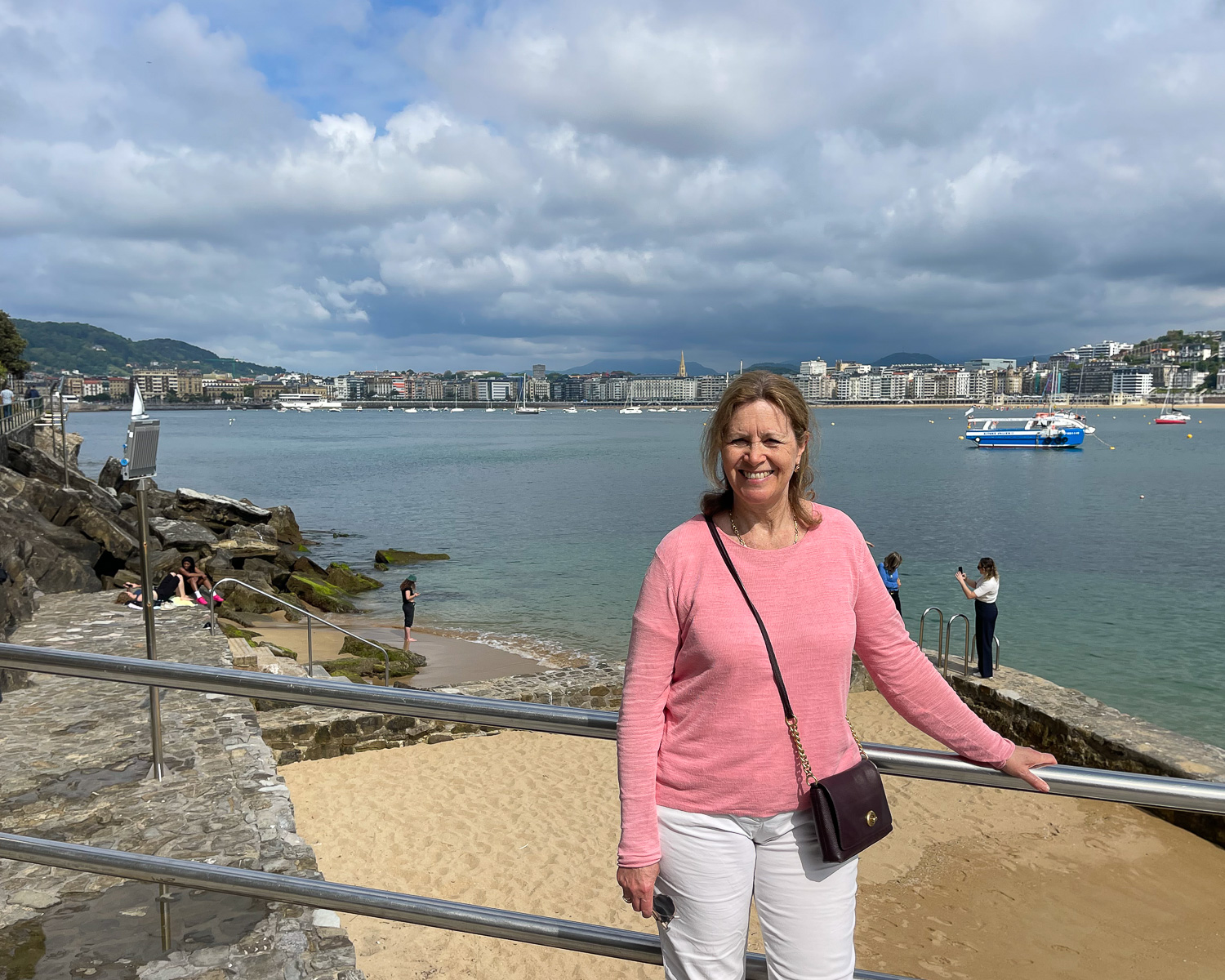
Be aware that this is “Green Spain”, with a climate that’s cooler and wetter than the scorching south, so you may experience showers at any time of year. The Basque people are extremely proud of their independent culture, so expect to hear and see Basque language written and spoken in San Sebastian, including San Sebastian’s Basque name of Donostia.
The city grew from a thriving port, living off fishing and whaling, to an elegant resort in the 19th century, when it became the favourite summer spot of Spanish royalty. At that time sea bathing was all the rage and San Sebastian expanded into the elegant Centro neighbourhood, with shopping, theatres, and casinos to keep the wealthy visitors entertained.
These days San Sebastian makes a popular city break destination, offering a mix of surfing and beach life with sightseeing, excellent food and attractive architecture. It’s one of those places that you visit and think – Yes, I could definitely live here!
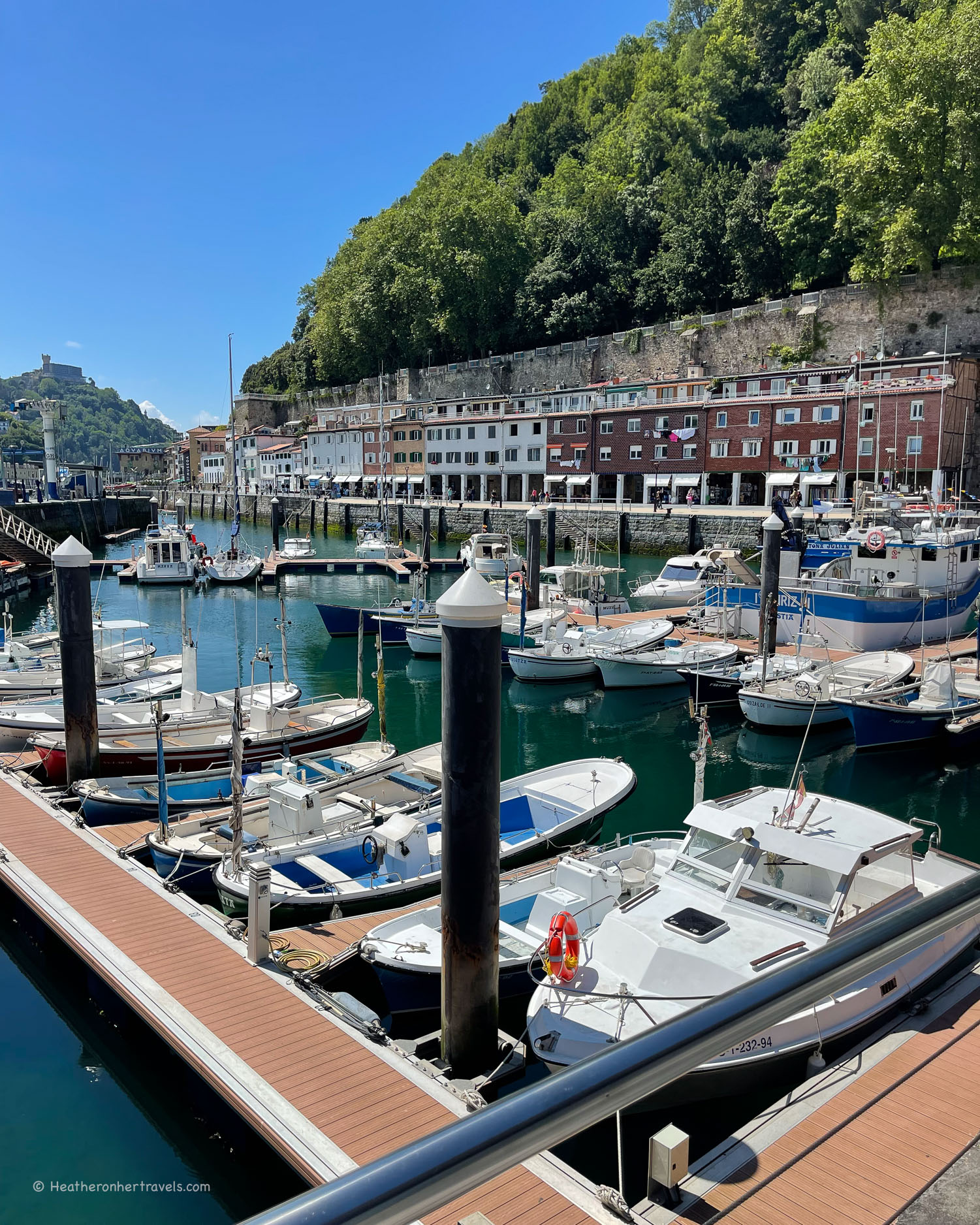
This article may contain affiliate links that provide commission on purchases you make at no extra cost to you. As an Amazon Associate I earn from qualifying purchases.
Top things to do in San Sebastian, Spain
If you are short of time and only have a day or two to explore, here’s what you should see first:
- Wander the streets of the Old Town or Parte Vieja, taking a quick look at Plaza de la Constitucion and the Basilica de Santa Maria del Coro.
- Visit the San Telmo museum, located in an old monastery, to understand more about Basque history and culture.
- Climb Monte Urgull for views over the Old Town, La Concha Beach and Zurriola Beach
- Stroll along La Concha Beach: sunbathe, swim or people-watch from the promenade.
- Visit Eduardo Chilleda’s “Comb of the Wind” sculpture, then take the funicular to the top of Monte Igueldo for more fabulous views over the bay.
- As evening falls, head back to the old town to try out a few Pintxos bars for an evening drink and the Basque version of tapas or small bites.
Now let’s explore all the top sights of San Sebastian and places to visit in each neighbourhood.
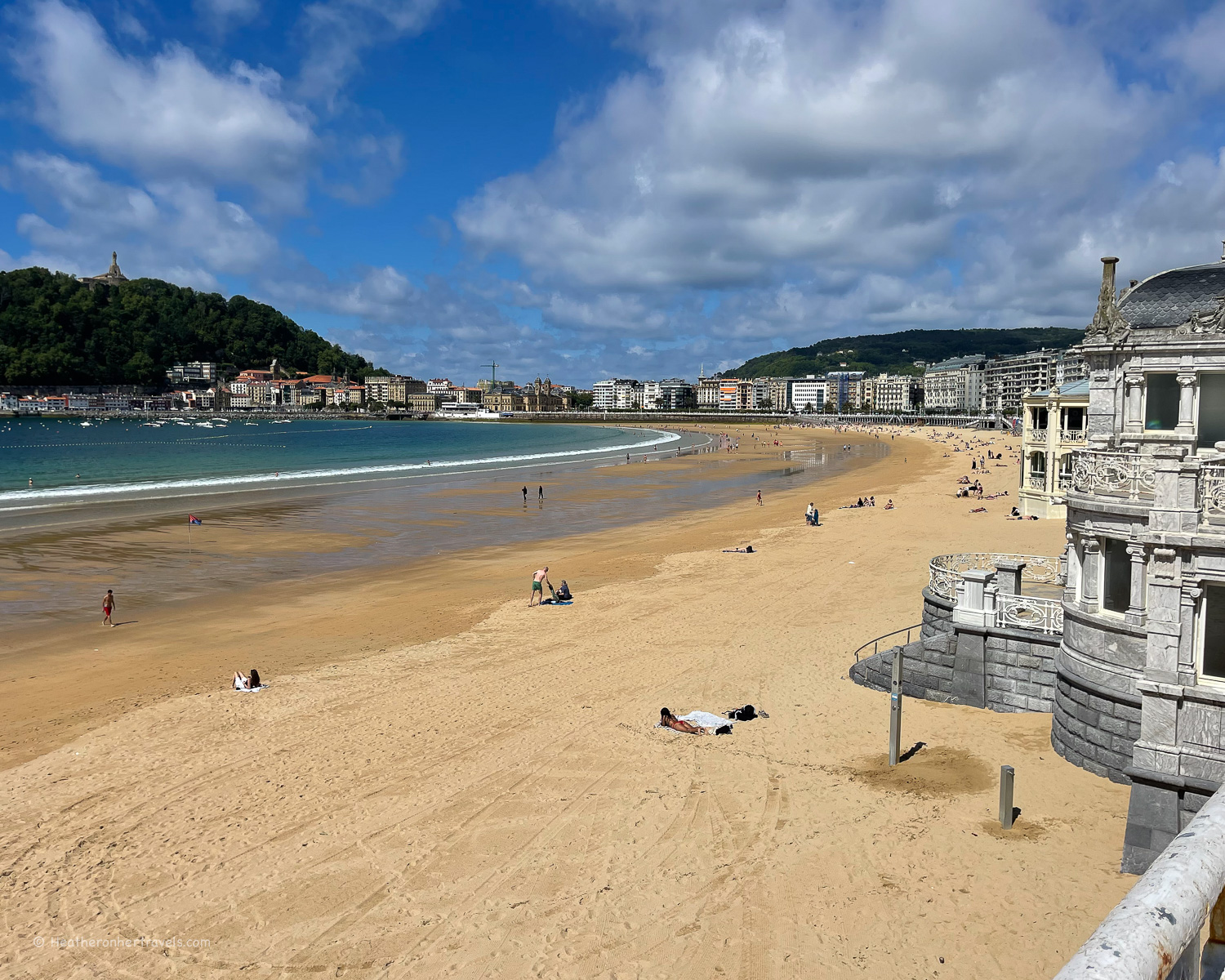
Parte Vieja / Old Town neighbourhood
The Parte Vieja or Old Town neighbourhood is a maze of pedestrianised streets with plenty of bars, shops and restaurants. This was the location of the medieval walled town that grew up in the shelter of the Monte Urgull next to the port.
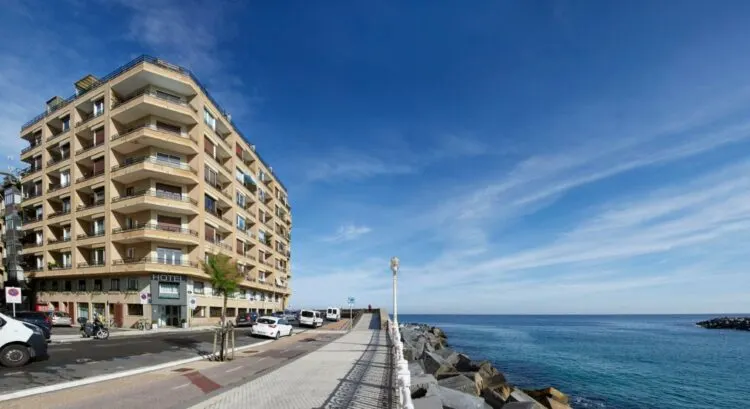
Hotel Parma is a comfortable family run hotel on the edge of the Old Town
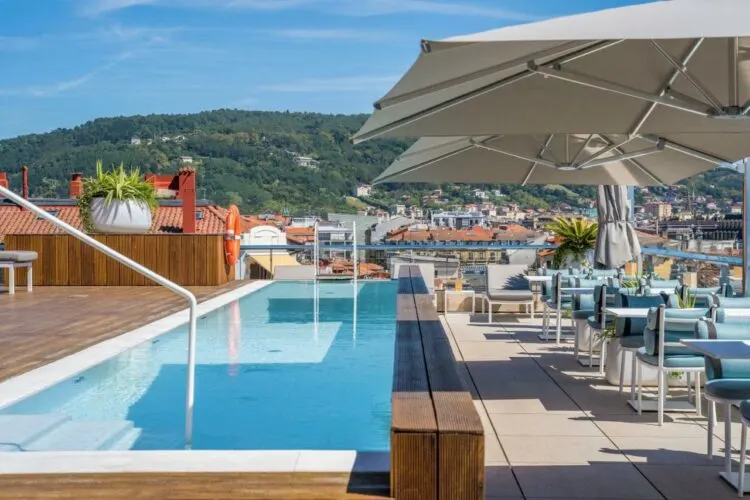
Lasala Plaza is a luxurious contemporary hotel with rooftop pool overlooking La Concha beach.
1. Explore the Old Town streets
San Sebastian never forgets the dark day of 31 August 1813, when the Anglo-Portuguese army under the Duke of Wellington stormed the city to oust the occupying French troops and burned it down in the process. Most of the buildings here are not quite as old as they seem, dating back to the 19th century reconstruction that took place after the fire.
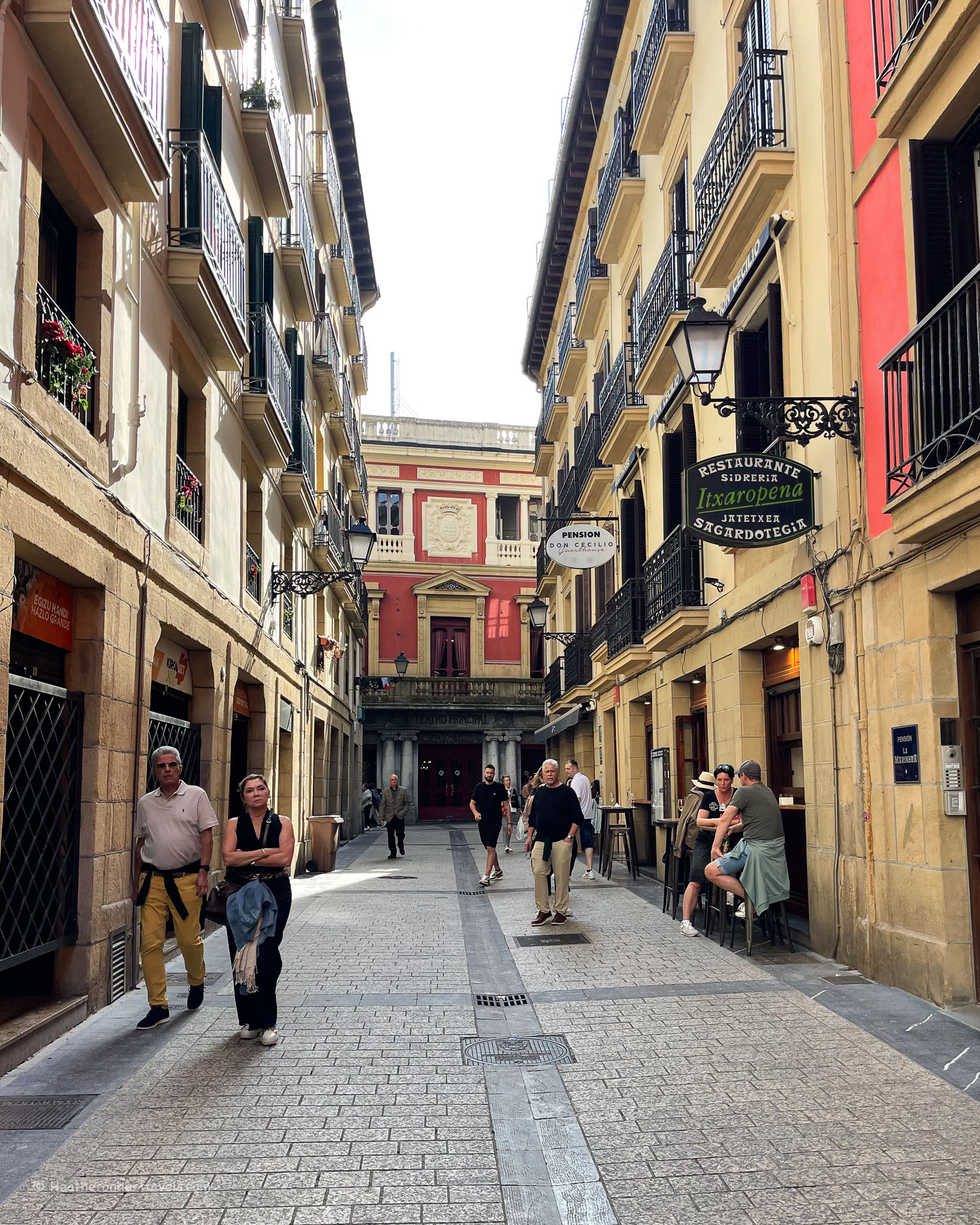
The busiest streets, that are packed with Pinxtos bars, are Calle 31 de Agosto and the parallel Calle de San Vincente, bisected by the Calle Major that ends in the Basilica de Santa Maria de Coro. The old town streets are especially lively in the evening and at weekends, when friends gather to make a bar crawl, ordering a drink and pintxos at a few different locations.
Basilica de Santa Maria del Coro
As you stroll along Calle Major, you’ll glimpse the gorgeous Baroque facade of the Basilica de Santa Maria del Coro (Our Lady of the Choir). Completed in 1774, the basilica is one of the few buildings that survived the fire of 1813. Highlights include a small museum of religious art and the elegant translucent marble cross by Eduardo Chillida behind the baptismal font.
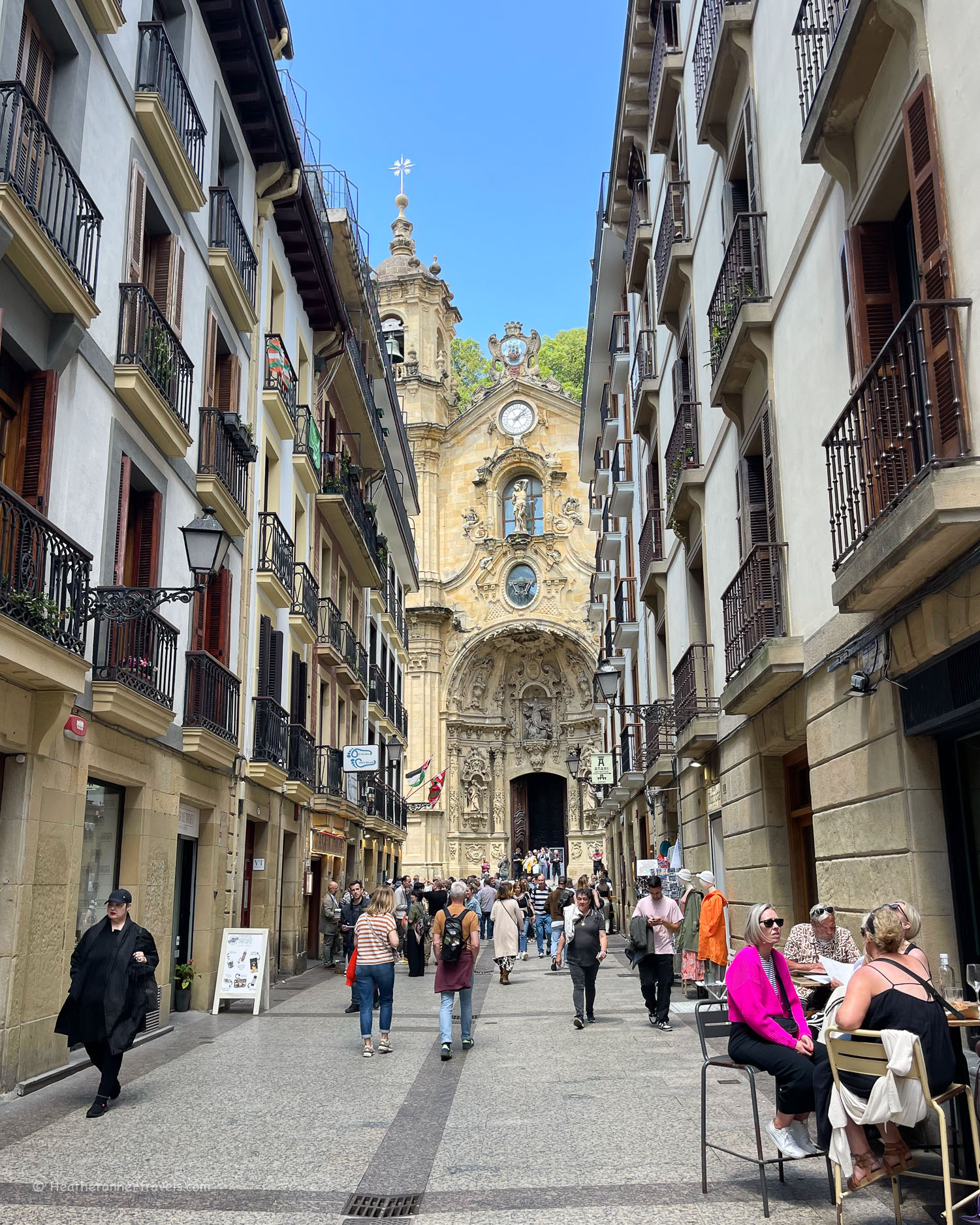
Passealeku Berria – for storm watching or sunset moments
If you want to turn your back on the city and enjoy the expansive views of the Bay of Biscay, take a promenade along Passealeku Berria. This seafront promenade is a fun place to stroll for walkers, joggers and dog walkers.
It runs from San Telmo Museum around the seaward side of Monte Urgull, as far as the Aquarium and Old Port. The promenade is a favourite spot to watch the waves on stormy days or sit on the wall and enjoy the sunset in summer.
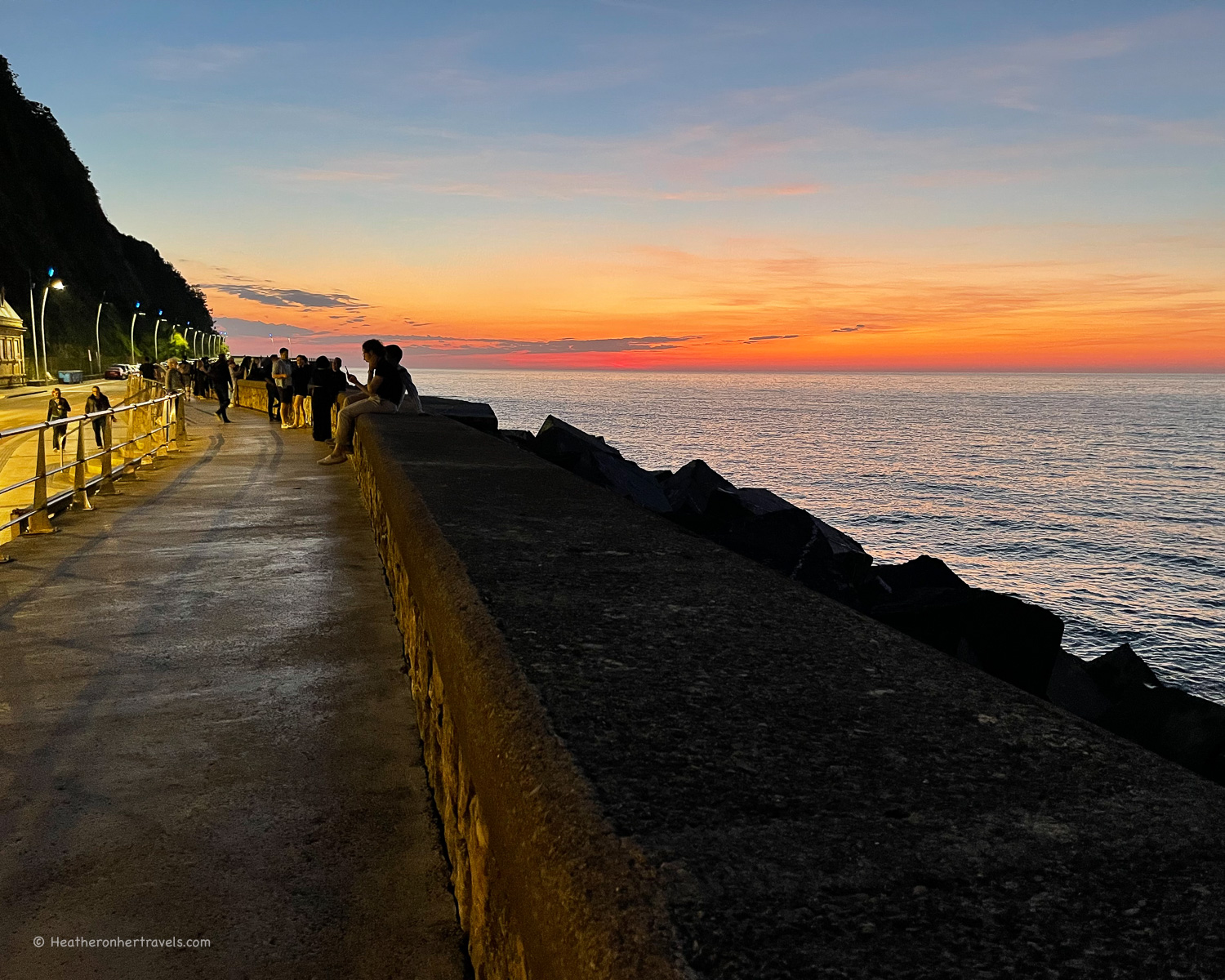
2. Plaza de la Constitucion – the old town square
The narrow streets of the Old Town suddenly open out into the paved expanse of Plaza de la Constitucion. It’s a great place to take a break from sightseeing and relax with a drink to watch the world go by. At one end is the old town hall, with arcades all around that make a useful shelter from the sun or one of San Sebastian’s frequent rain showers.
The tour guides love to point out the numbered balconies of apartments that overlook the square. In the past, the square was used for bull fights and the balconies were reserved as boxes for the wealthy, who could afford the best view of the spectacle.
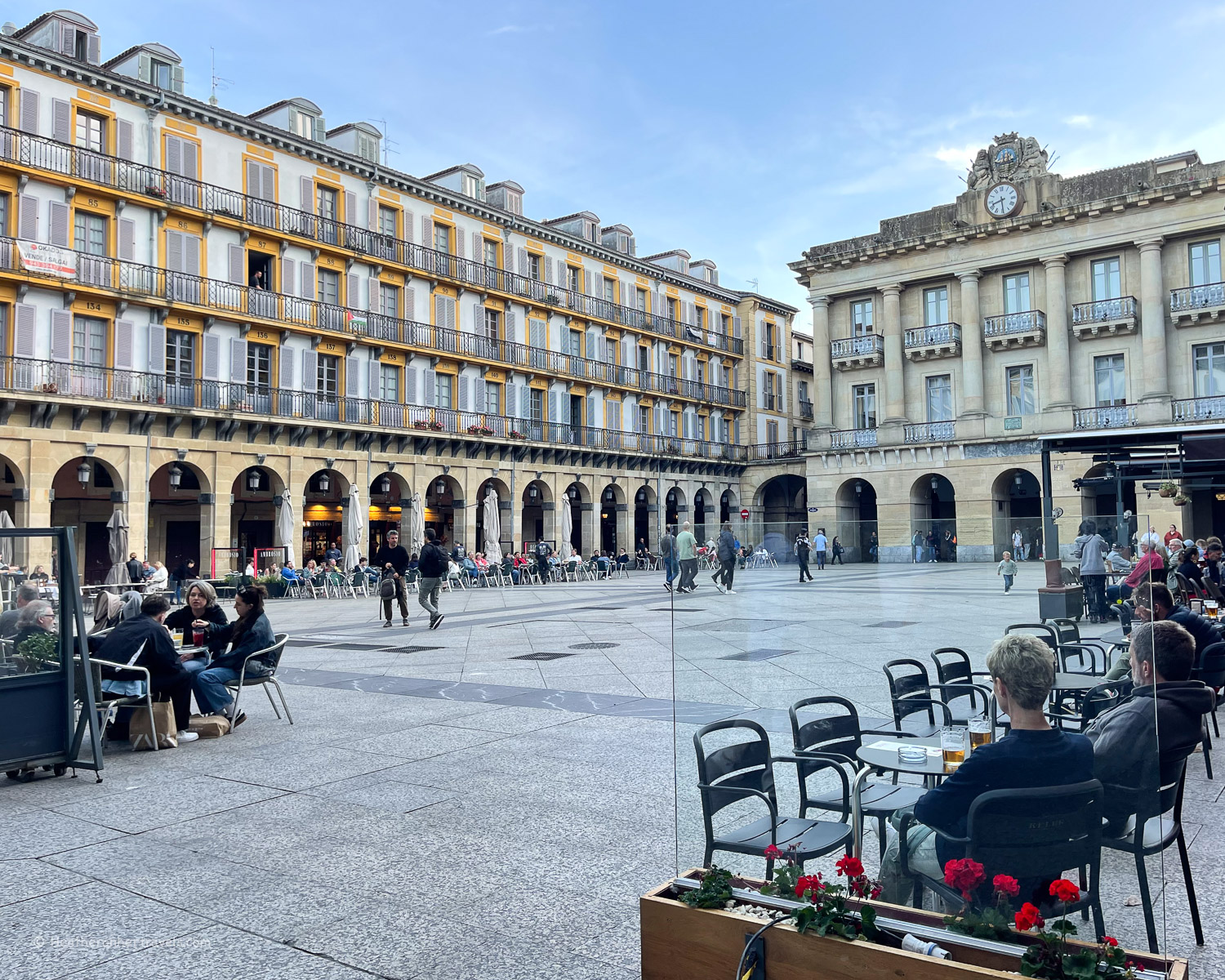
3. Go bar hopping on a Pintxos tour
The cuisine of San Sebastian is synonymous with Pintxos (pronounced pin – chos), the innovative small bites that are the Basque country’s answer to tapas. Almost every bar will serve them, from the tempting plates of cold Pintxos laid out on bar tops, to the more substantial racionnes or small plates that you can order from the menu.
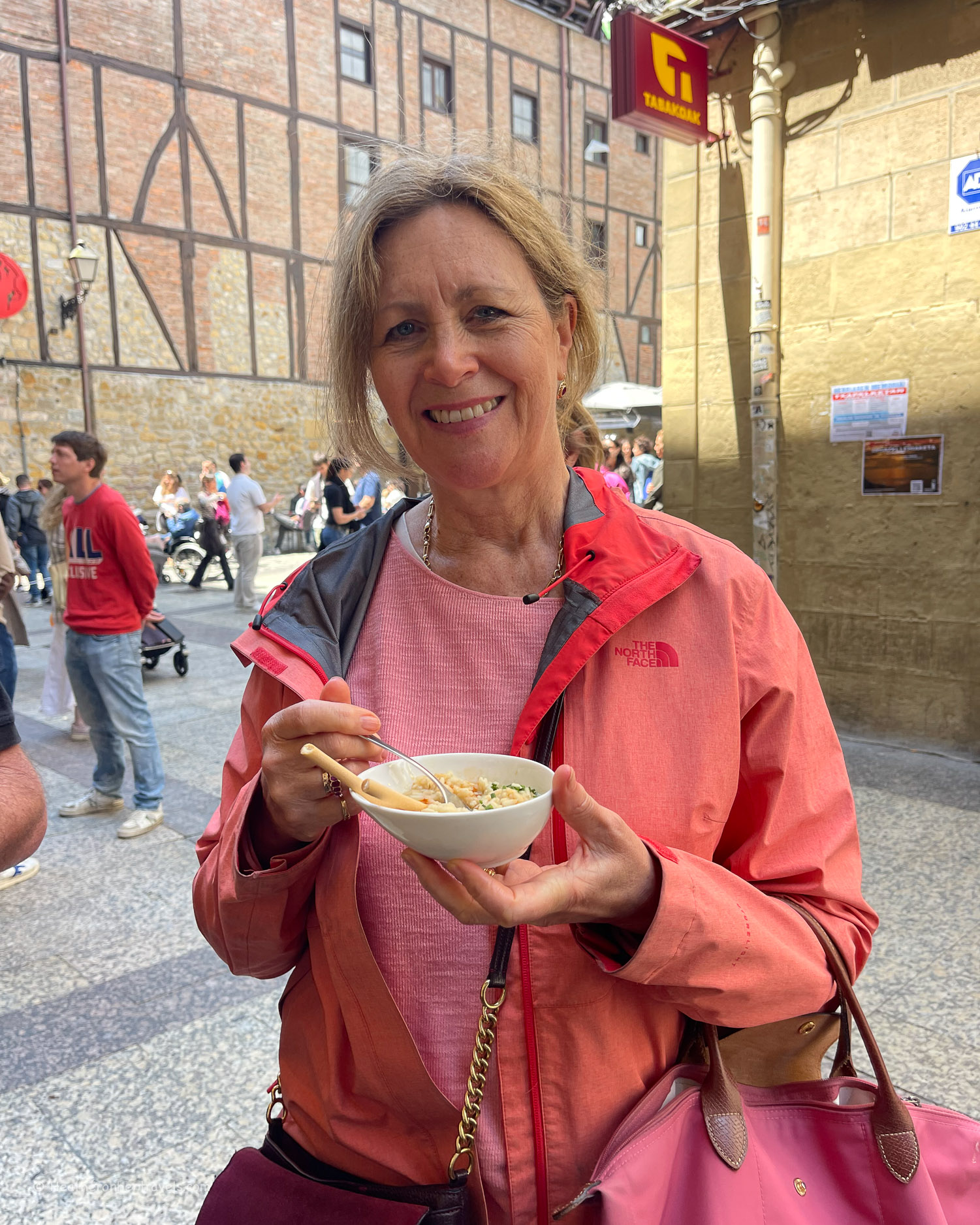
A good place to start your Pintxos experience is in the Old Town, where there are numerous bars packed together. Follow the locals who go bar-hopping to try a drink and one or two Pintxos at each one. There are also excellent Pintxos bars in the Gros and Centro neighbourhoods and they are a lot less touristy.
At the same time, you might try the fresh local white wine, called Txakoli (pronounced Cha – ko – li ), which is poured from a height to give it some fizz.
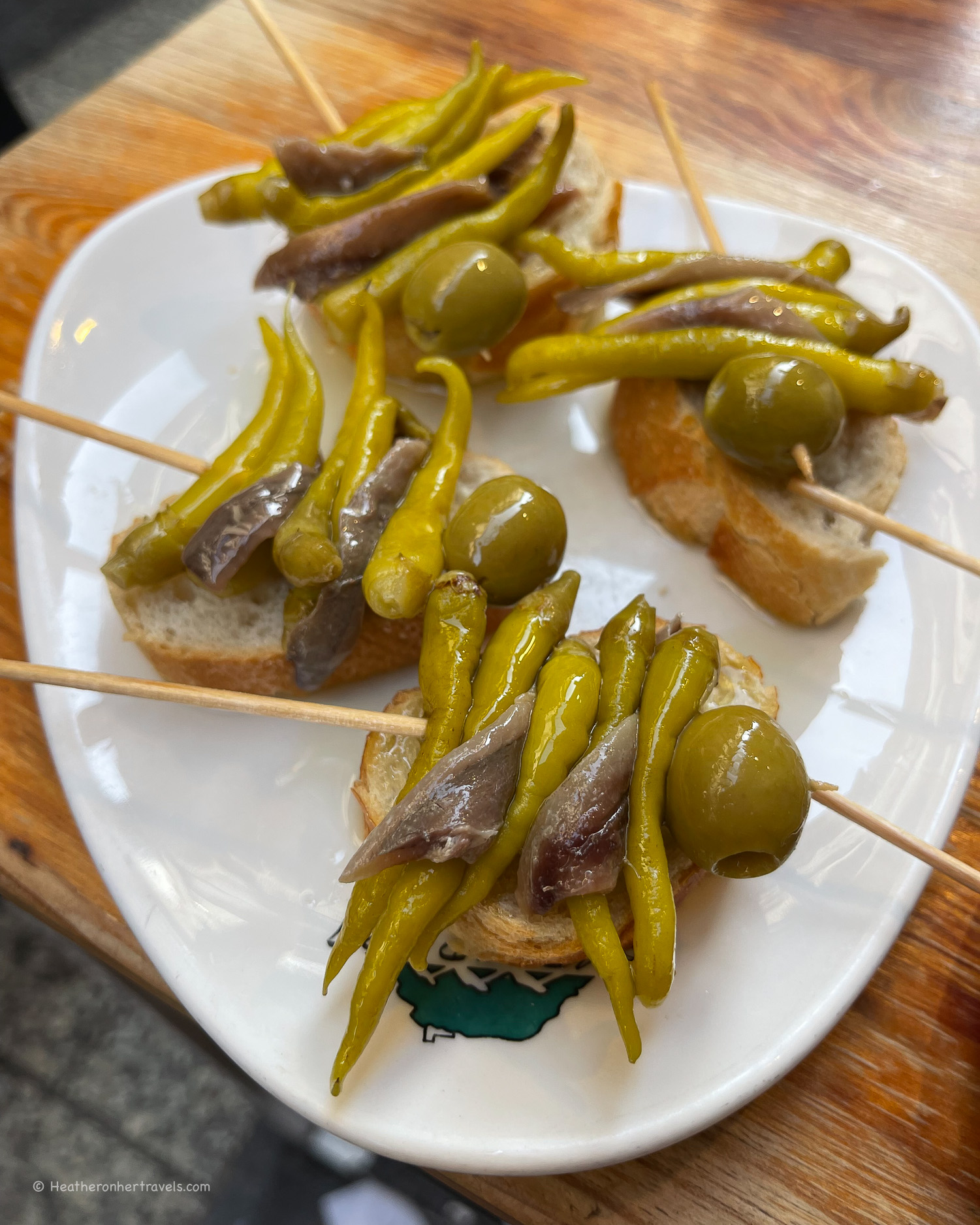
How to order Pintxos
If you’re not sure what to order, start with a bar that has a good selection on their counter, preferably labelled with what each contains. Once you’re tuned in to the typical Pintxos on offer, try ordering some of the hot Pintxos from the menu behind the bar. Ask a local or the barman what is the house speciality – there’s always one! If a bar is packed it’s normally a good sign of quality, so don’t be put off by the crowds, as service is invariably brisk and efficient.

Another good way to try the Pintxos experience, especially when you first arrive, is to take a Pintxos bar hopping tour, like the Old Town tour that we enjoyed with Devour Tours, who run food tours all over Europe.
Devour also run Pinxtos tours in the less touristy Centro neighbourhood as well as this fun Basque cookery class.
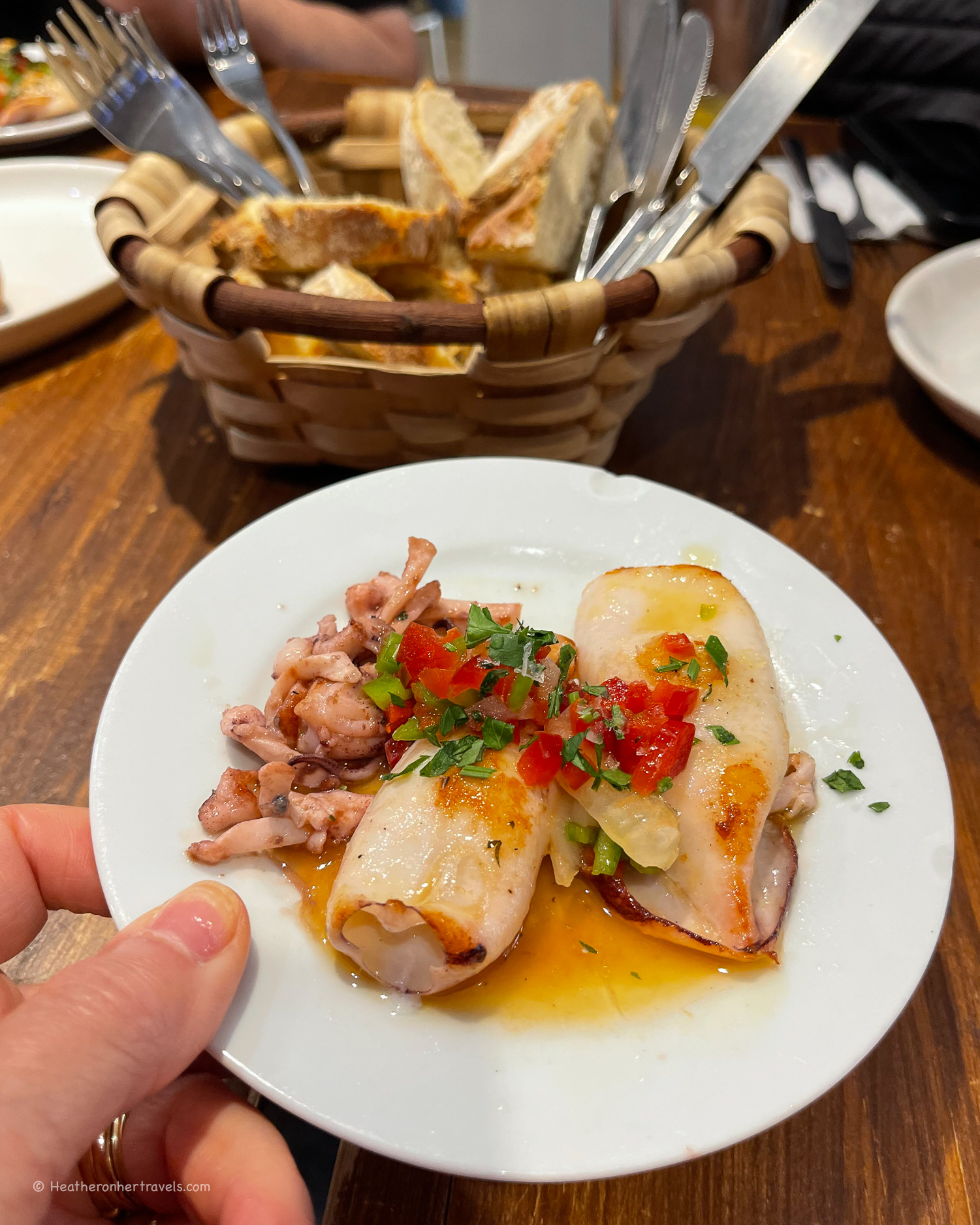
4. Monte Urgull – for views over the bay
For fantastic views over San Sebastian, climb Monte Urgull, the wooded hill that overlooks the town at one end of La Concha bay. This green space is accessed by pedestrian paths starting either behind San Telmo museum or behind the Aquarium and Old Port.
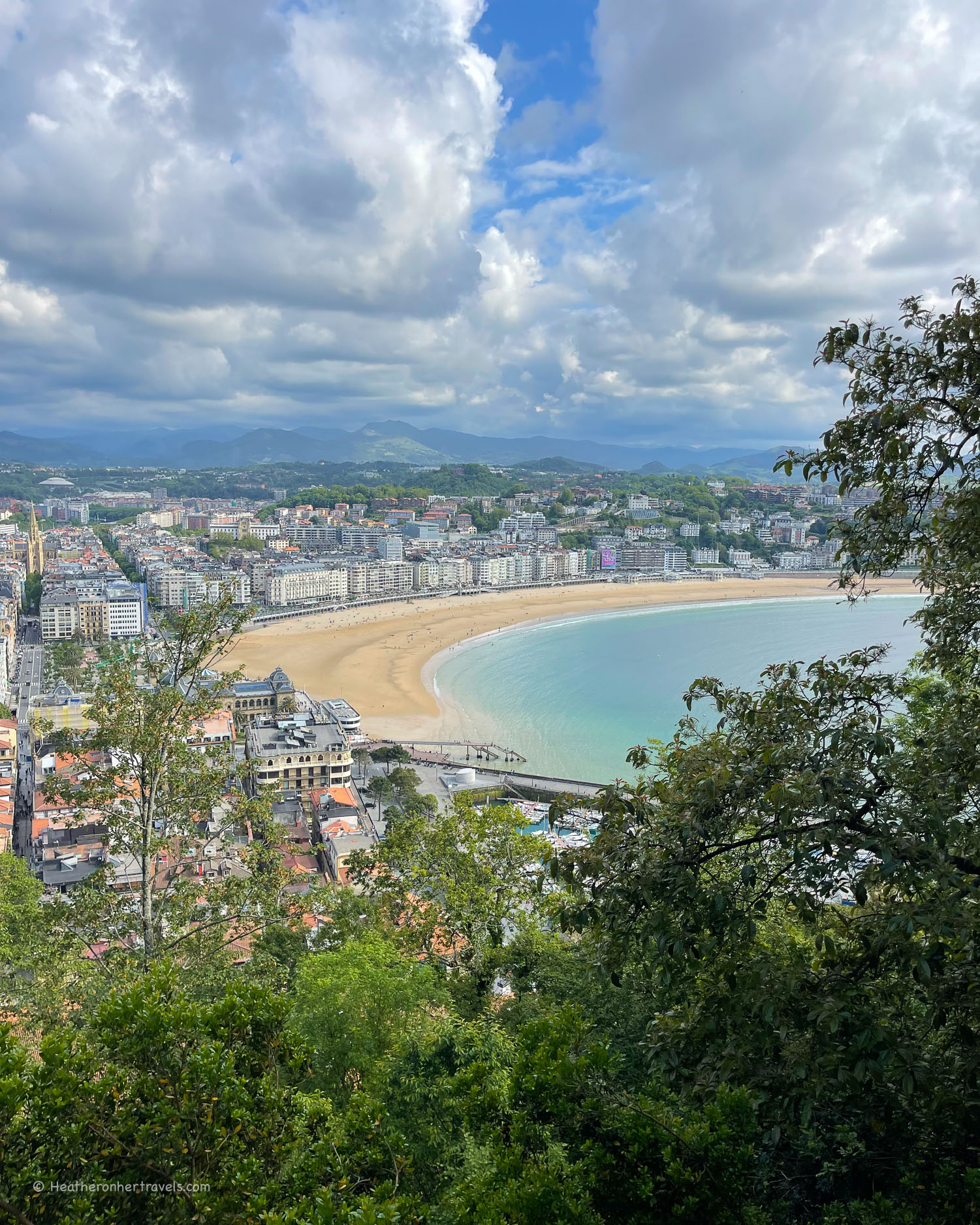
I walked up from the San Telmo Museum and stopped at the first small bastion, with lovely views over Zurriola Beach and the Gros neighbourhood.
Continuing up the hill, the path wound through shady trees to the 12th century fortress of Castilla de la Mota, with a 40ft looming statue of the Sacred Heart from the Franco era. The fortress contains a small military museum, which was closed when I visited, but there are old canons all around the ramparts.
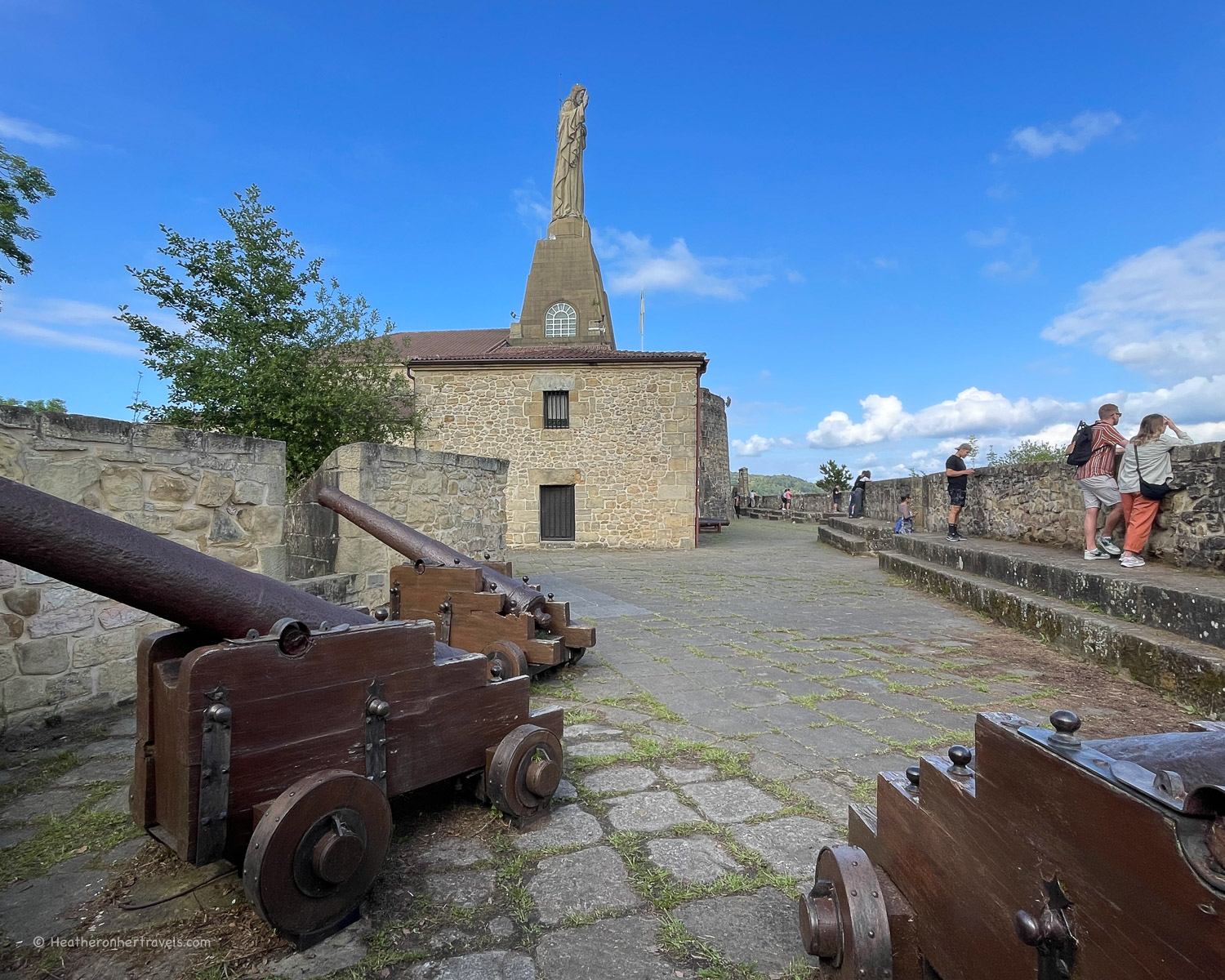
Continuing down the hill towards the aquarium, I passed by a cute outdoor bar, where there happened to be a live band playing in the early evening. There are some grassy areas above the bar that would make a good place for a picnic.
5. San Telmo Museum – Basque history and culture
If you visit only one museum in San Sebastian, it should be the San Telmo Museum, at one end of the Old Town. It’s located in the pleasant Zuloaga Plaza, in a 16th century Dominican convent to which has been added a modern extension, incorporating the original cloisters.
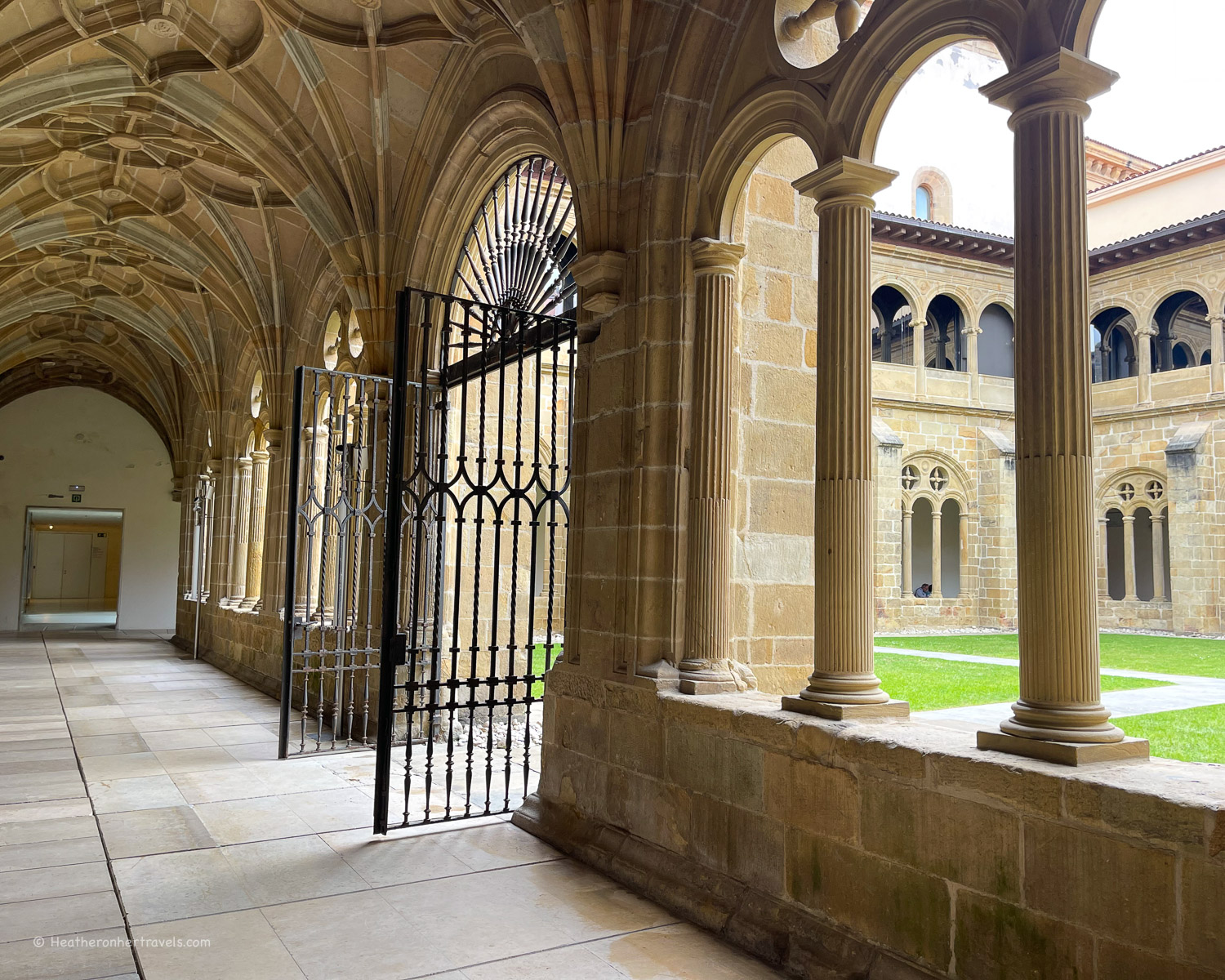
The museum’s highlight is the collection of Sert Canvases, on display in the former church of the convent. These huge artworks by Jose Maria Sert, were created in 1929 specifically for this location, and depict in monumental fashion some of the scenes and themes from San Sebastian’s history.
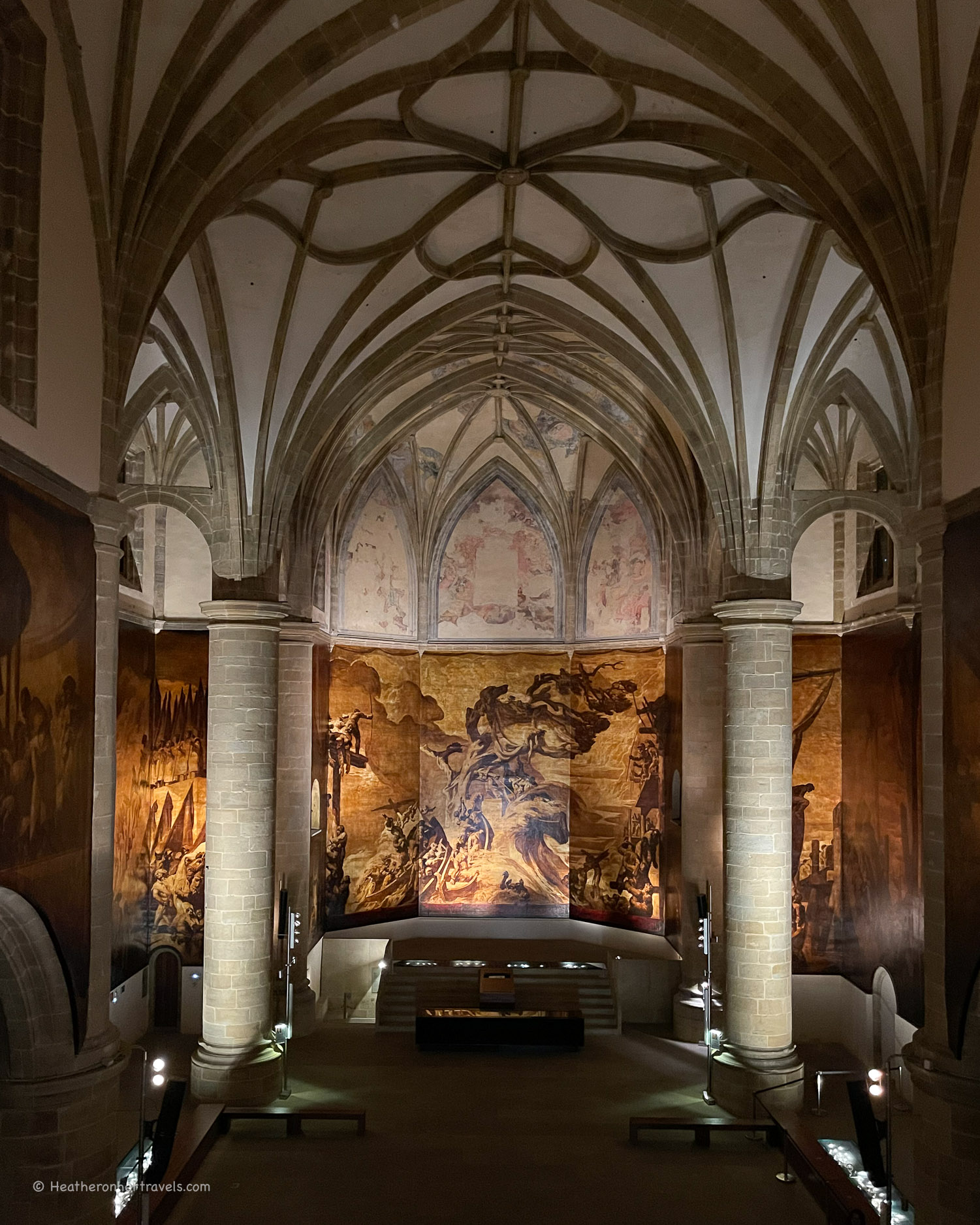
Other exhibitions cover aspects of Basque life and San Sebastian’s history, from folk customs and maritime traditions, to the collections of vintage tourism posters and 1960s pop culture. This museum is a one stop shop to brush up on your understanding of Basque culture and history.
Open: Tuesday – Sunday (Closed Mondays except public holidays) 10am – 7pm (8pm in summer)
6. Old Port of San Sebastian – a charming maritime scene
The Old Port is one of the few parts of the Old Town that survived the fire and destruction of 1813. It’s now a marina full of smaller leisure and fishing boats, surrounded by cute houses. If you’re interested in Naval history, stop by at the small museum in an 18th century tower house to learn about San Sebastian’s sailing traditions.
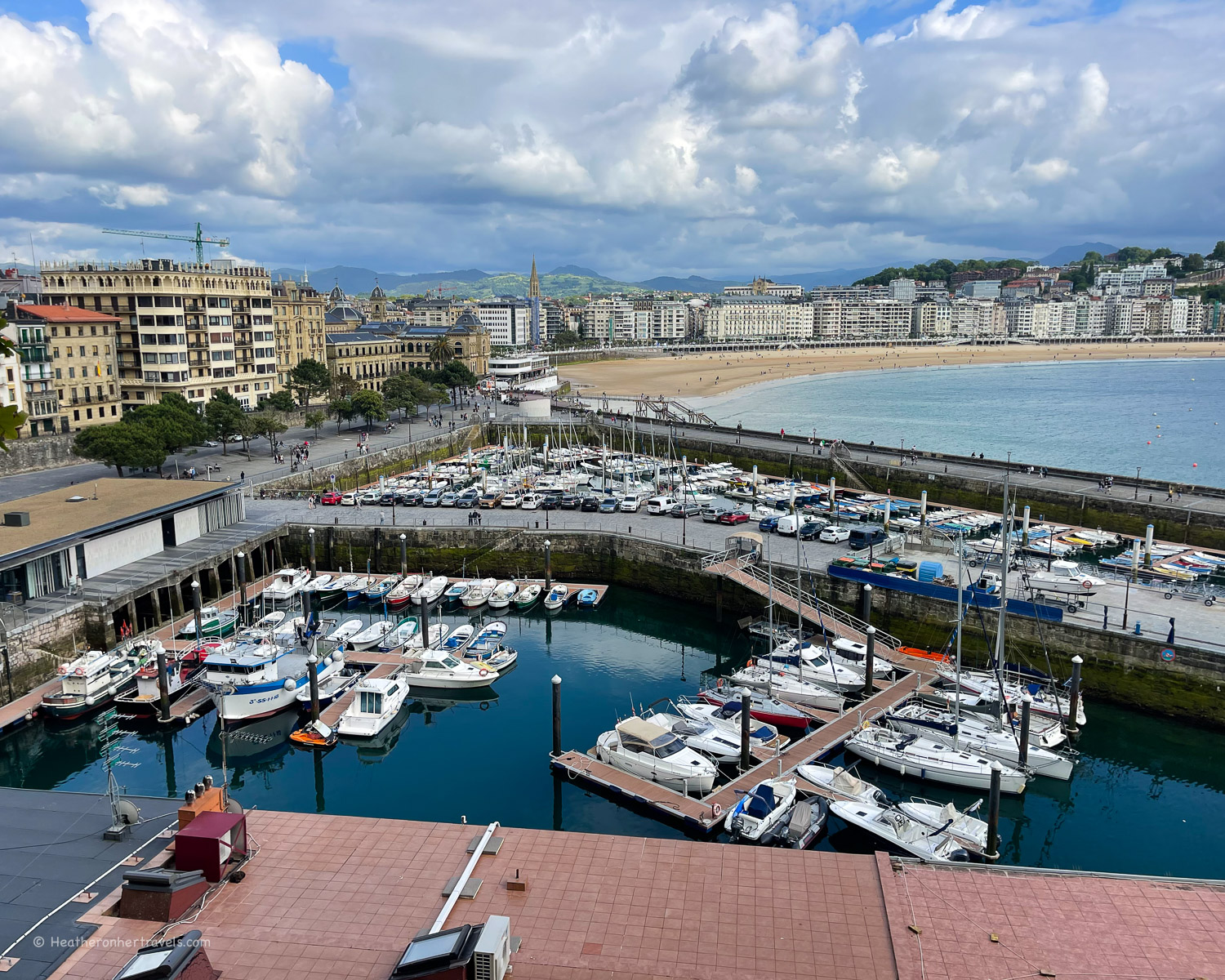
There are plenty of fish and seafood restaurants here, making this one of the best places in San Sebastian to try fresh fish. The large restaurant of Kofradia overlooking the harbour would be my recommendation, but there are several to choose from.
Tip: Try the locally caught and sustainably fished Bonita tuna, which comes from nearby Bermeo.
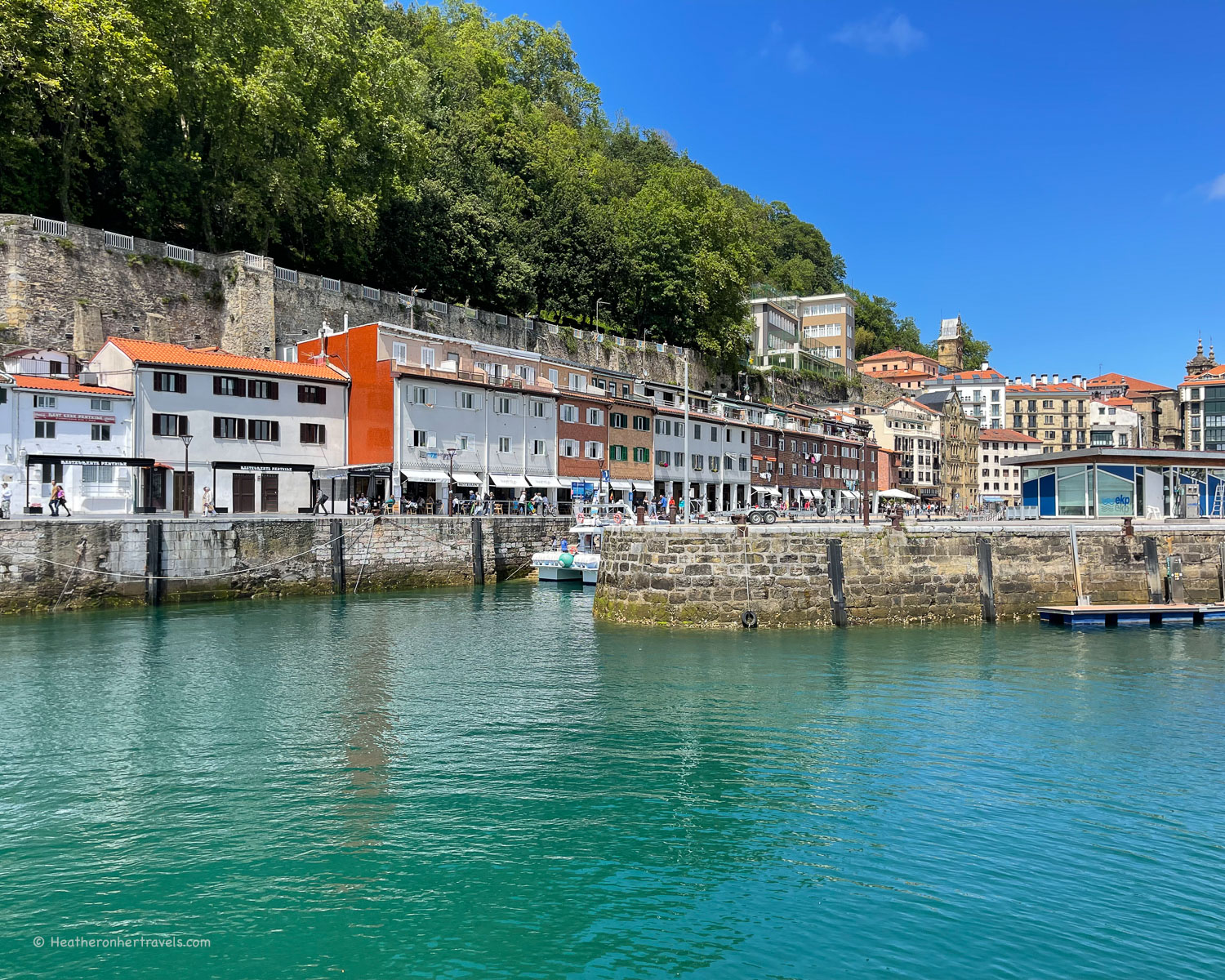
Aquarium of San Sebastian
I didn’t have time to visit the Aquarium which is located above the old port. In addition to the tanks of marine life, there’s a transparent tunnel to walk through with sharks, rays and turtles swimming all around you.
I’d have been interested in the exhibition covering the maritime past of the Basque people, who were accomplished sailors. I avoid most captive animal experience these days, but the aquarium is understandably popular with families.
Open: Daily in Summer but closed Mondays in Winter 10am – 7pm ( 8pm in summer) Tickets: €14 Adults
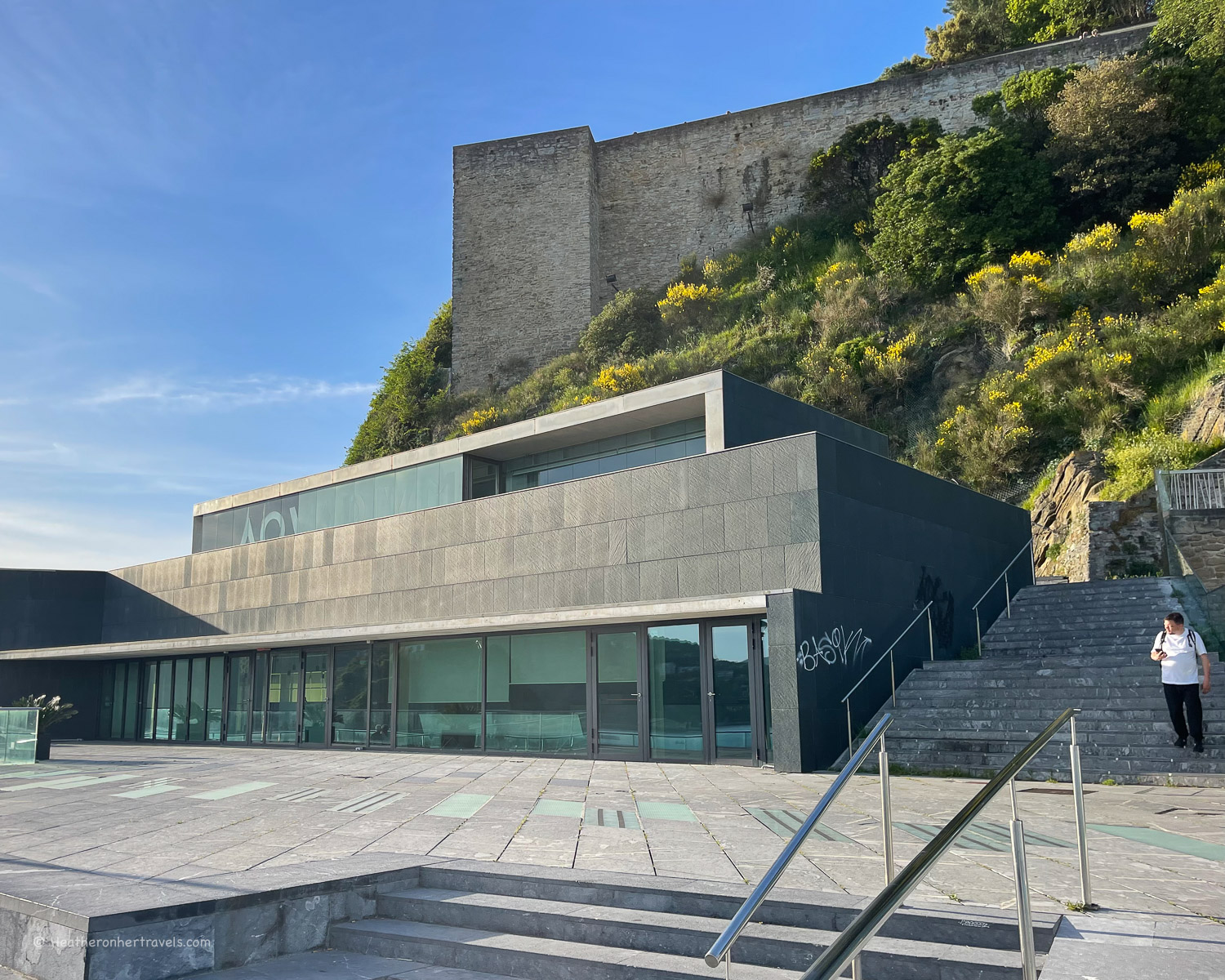
7. Boat ride to Santa Clara island
From La Concha beach, or almost any of San Sebastian’s viewpoints, you’ll spot Isla Santa Clara in the middle of the bay. I really enjoyed taking a boat ride there from the Old Port, for the bargain price of €4 return. Admittedly it’s only a 10 minute ride, but you get some great views from the water, and somehow feels like its own little world.
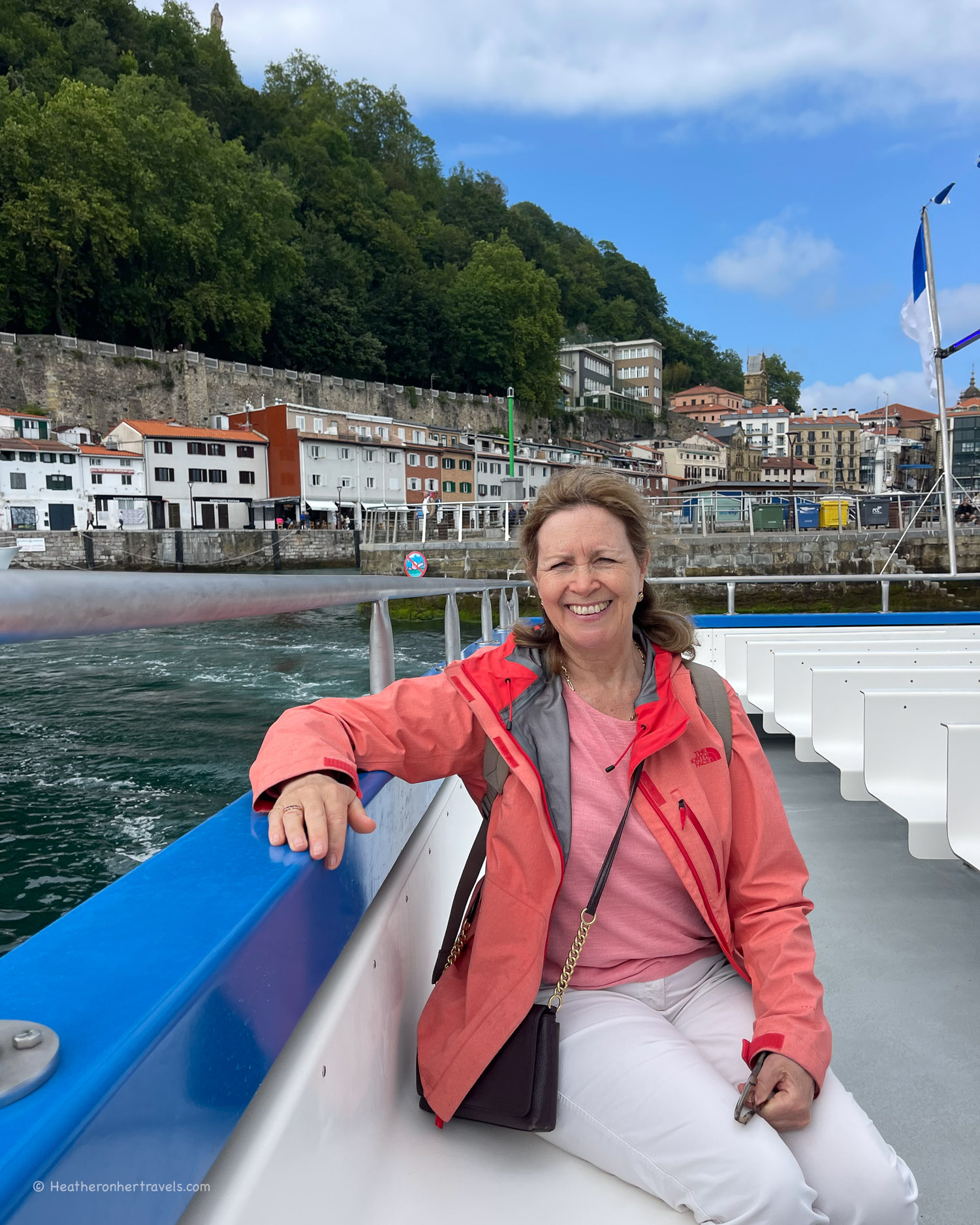
Once you arrive on Isla Santa Clara, there’s a tiny beach which is only exposed at low tide, as well as some steps at the end of the cafe where you could swim. The cafe is a fun place to sit while waiting for your return ferry or to watch the more serious swimmers crossing the channel from Ondaretta beach.
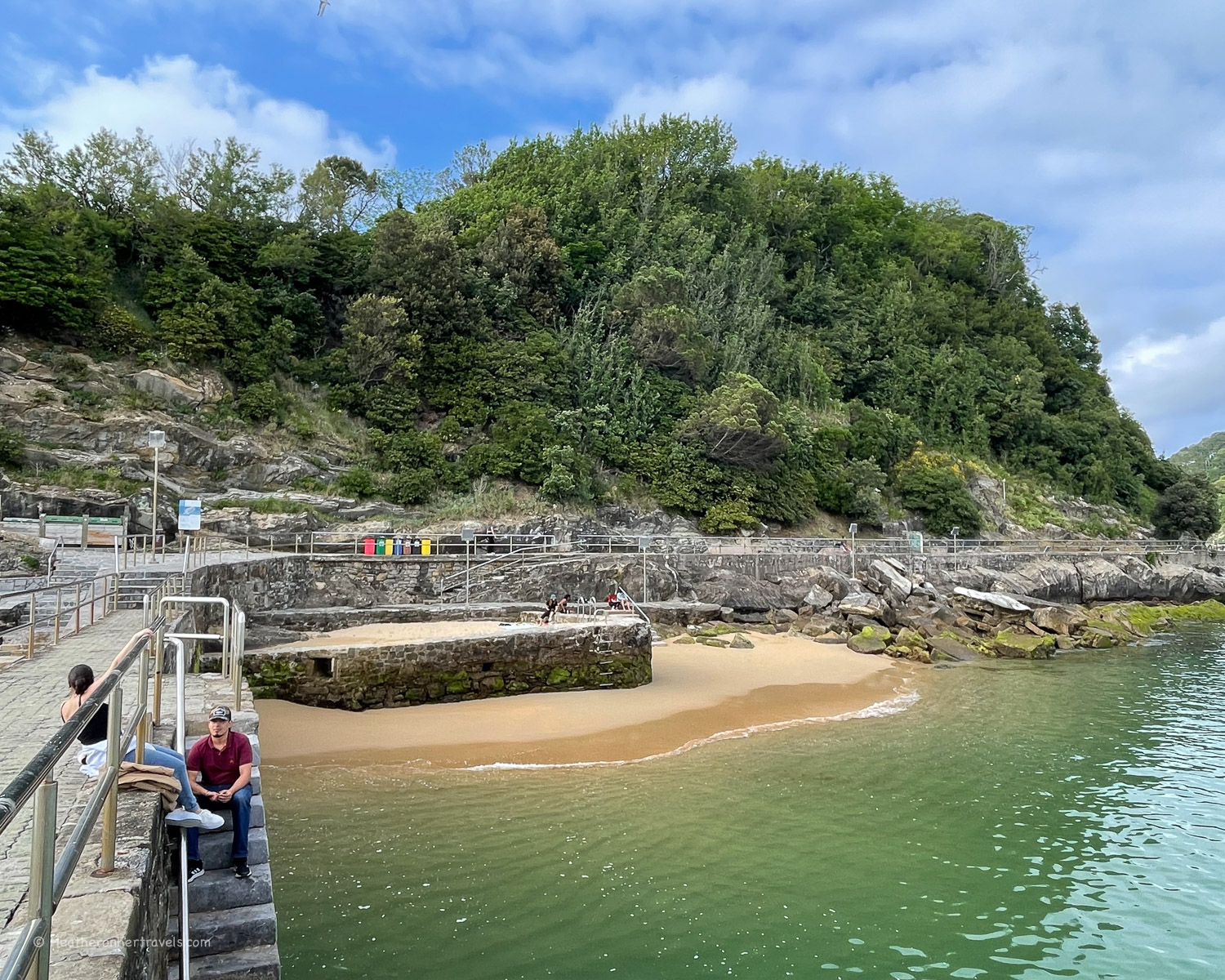
Walking up the stone pathway behind the cafe brings you into a wooded area, where there are picnic tables to sit in the shade.
Hondalea art installation
We also really enjoyed taking a look at the free Hondalea art installation by Christina Iglesias located inside the Santa Clara Lighthouse.
The interior of the lighthouse has been stripped out with a version of the barnacle covered rocks sculpted from metal with the tide washing through them. I love this kind of thing, but Guy didn’t really get it, wondering why we couldn’t just look at the real rocks outside!
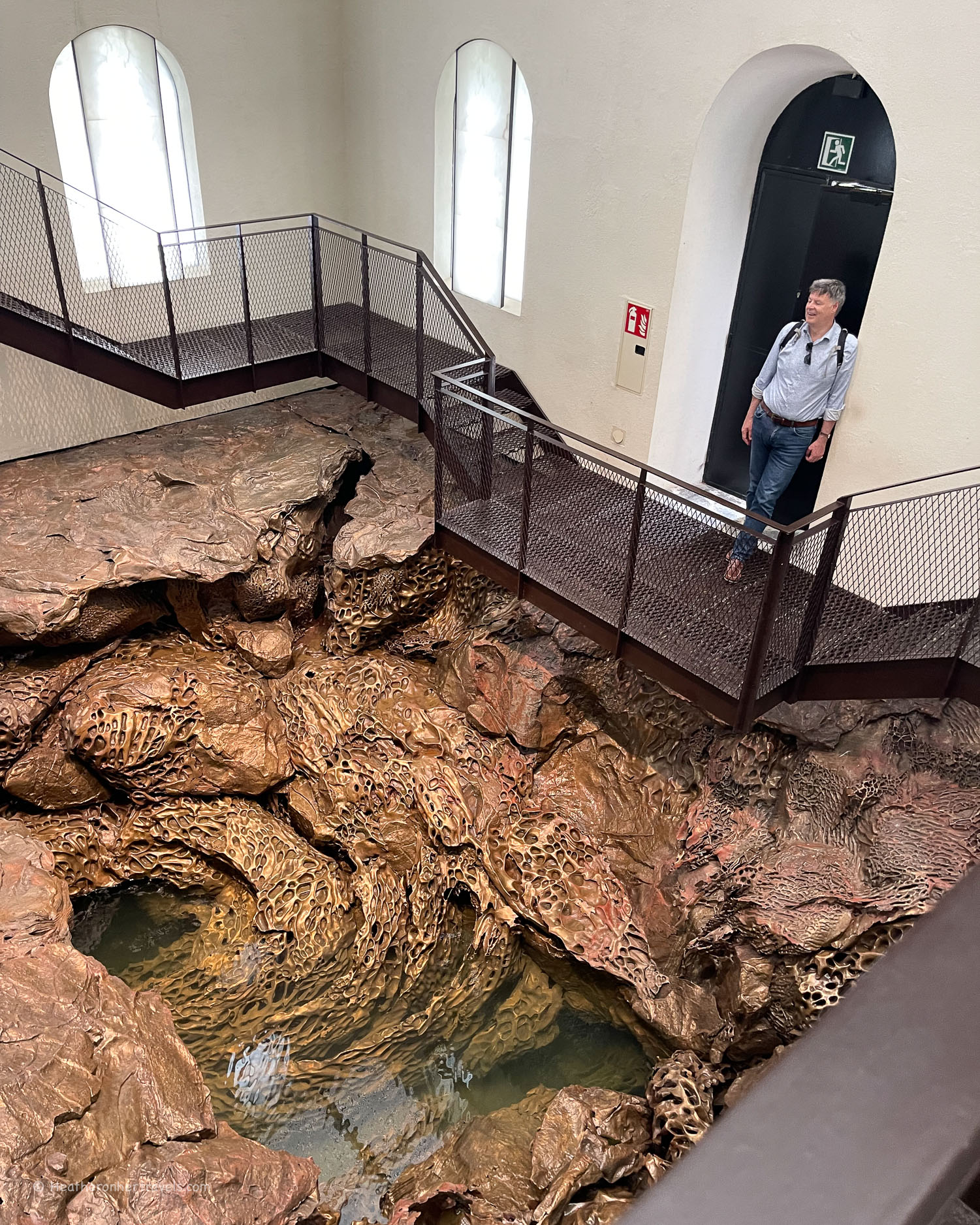
When you are ready, just walk back down to the jetty to catch the next boat back to the harbour, they run every half an hour.
The Centro neighbourhood – Belle Epoque Style
While the Old Town of San Sebastian dates back to the 12th century, the Centro neighbourhood developed in the late 19th century when the city became popular as a holiday destination. Sometimes it’s known as the “Romantic” neighbourhood, with Belle Epoque architecture of broad boulevards, elegant apartment buildings and all the best shops.
Where to stay in Centro
Budget – Pension Buenpas
Mid-range – Room Mate Gorka or Hotel Arbaso
Luxury – Hotel Maria Christina or Nobu Hotel San Sebastian
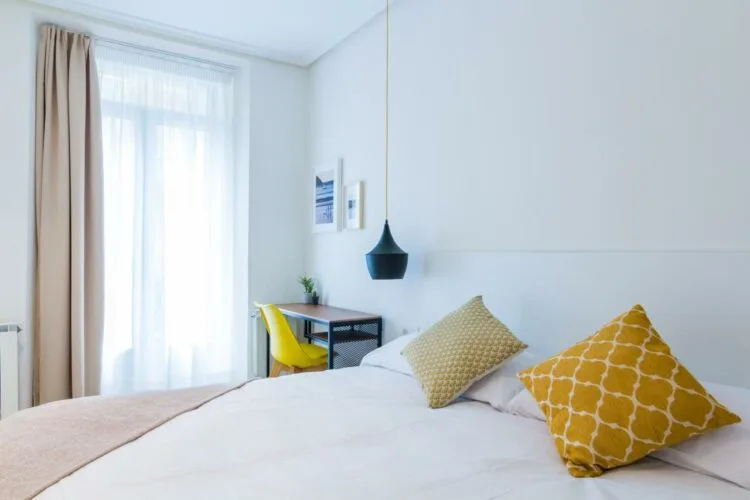
Pension Buenpas is a modern style guest house close to the cathedral in the Centro district
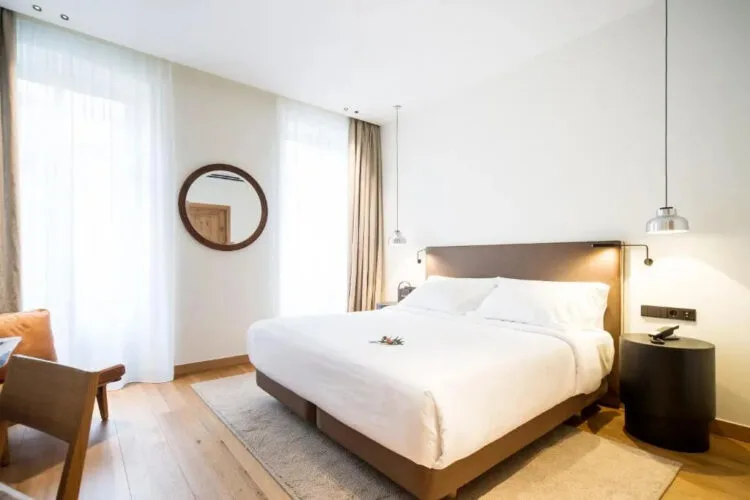
The 4-star Hotel Arbaso in the city centre and boasts a restaurant, free bikes and a bar.
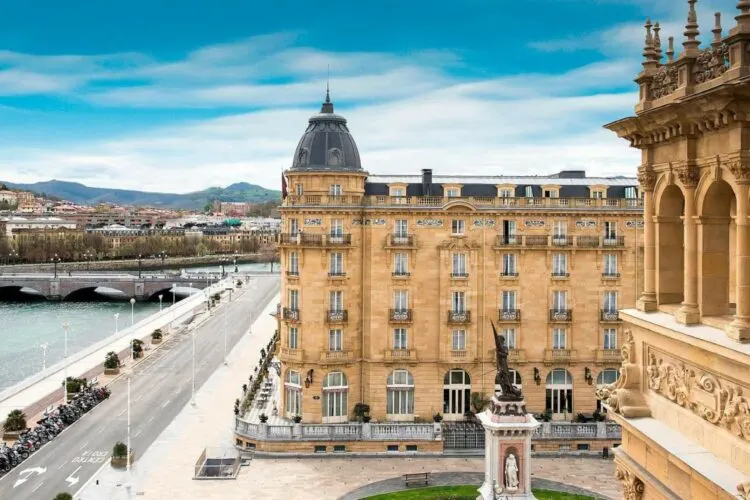
The 5-star Hotel Maria Cristina is San Sebastian’s premier luxury hotel from the Belle Epoque era
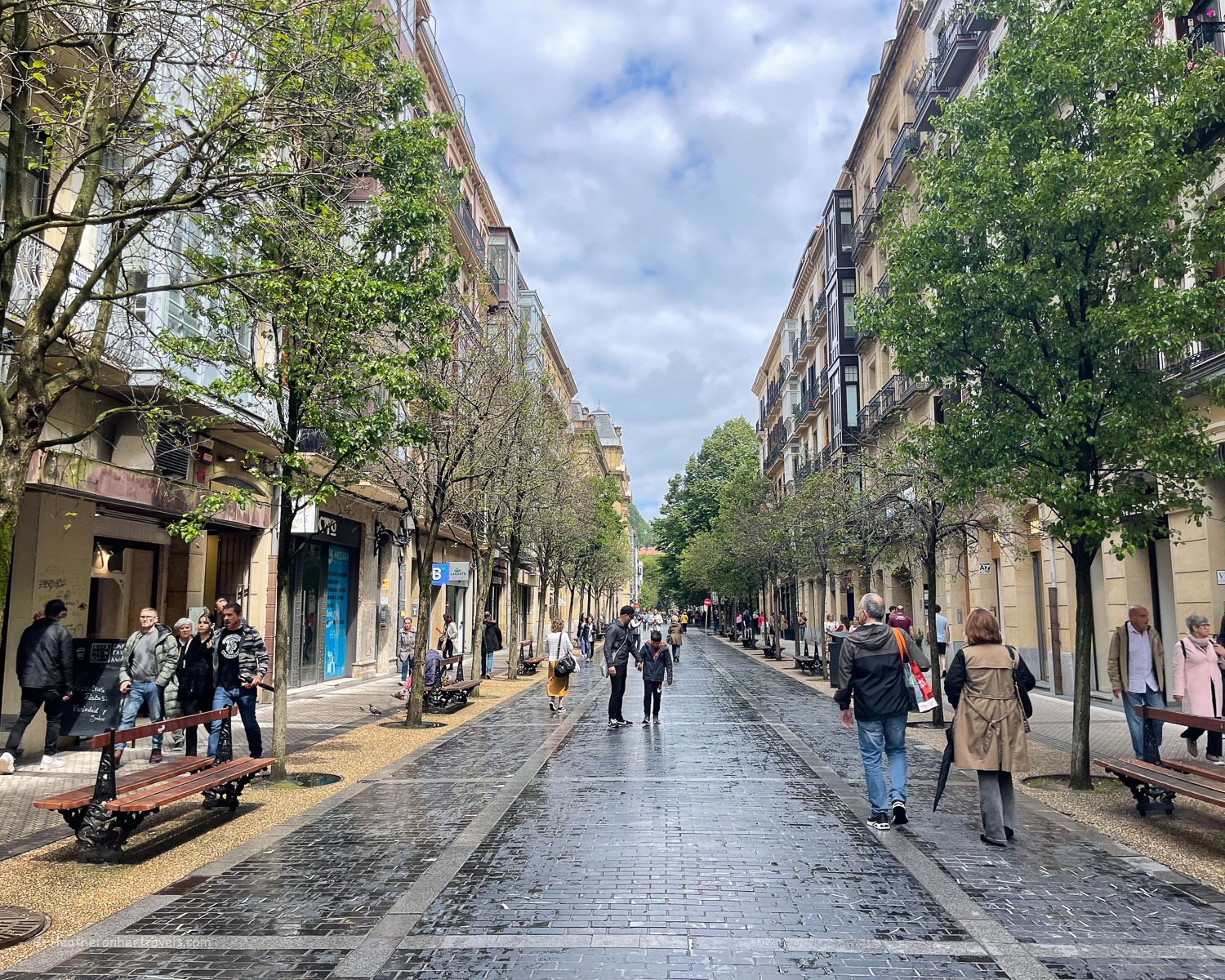
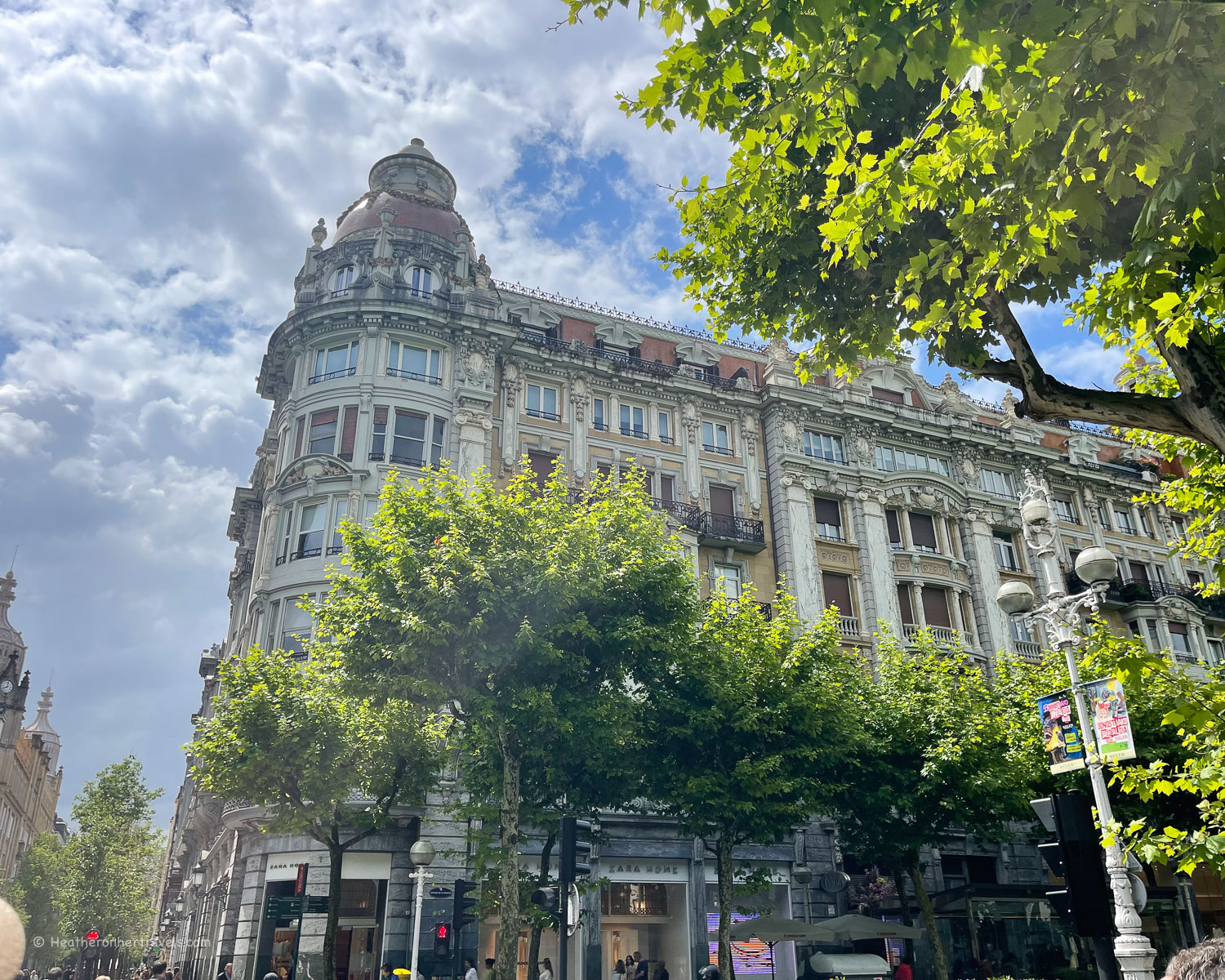
8. Parque de Alderdi Eder and the City Hall
The transition from the Old Town to the Centro neighbourhood is marked by the imposing and decorative City Hall. It was one of the original casinos that were built in the 19th century, to entertain the wealthy visitors who followed the court of Queen Maria Cristina to spent their summers here.
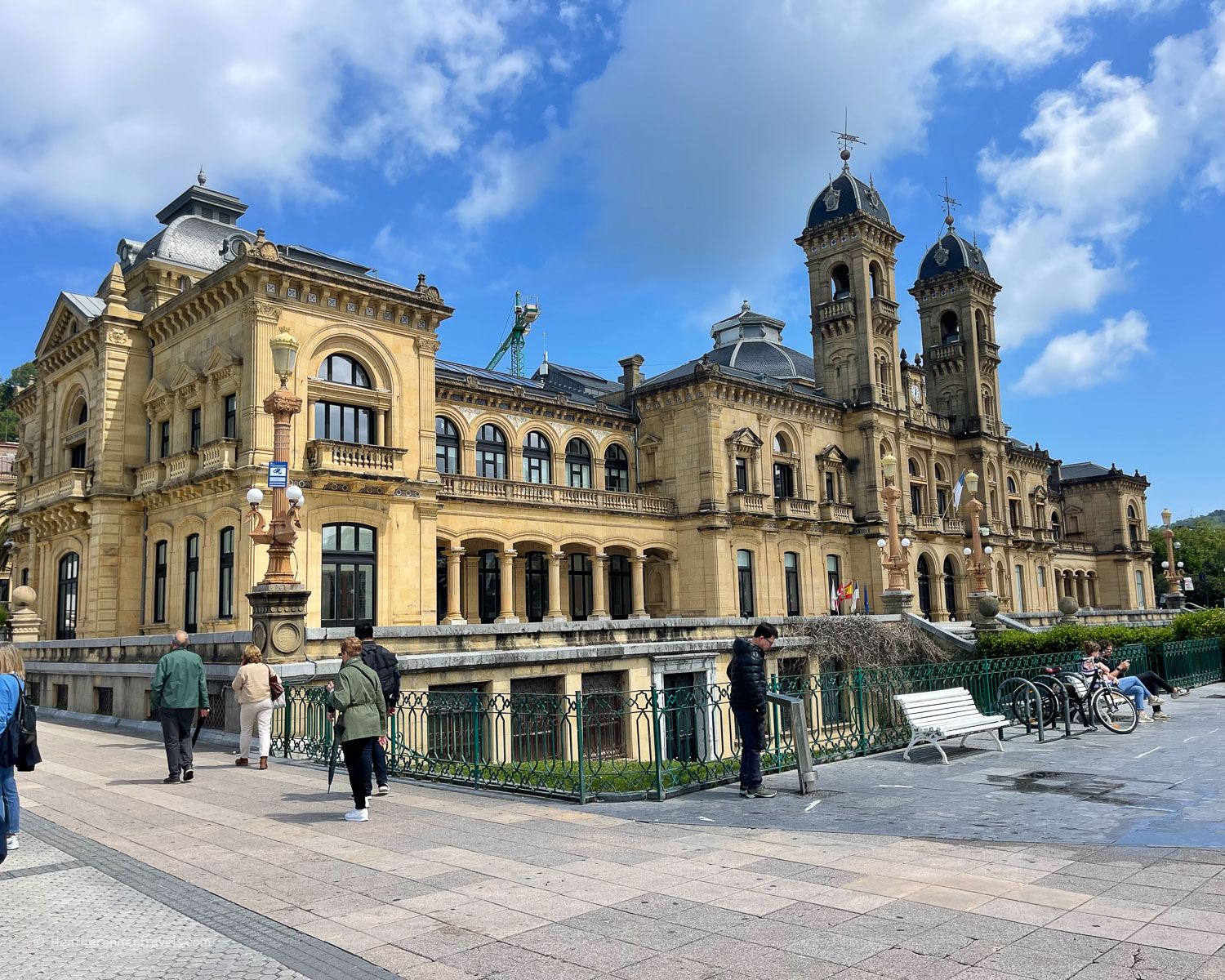
In front of the city hall extends the Parque de Alderdi Eder, with paving, fountains, palm trees and and grassy borders. If you happen to be visiting in summer, look out for the purple flowering tamarisk trees, which were a gift from Napoleon III and do particularly well in San Sebastian’s sea air.
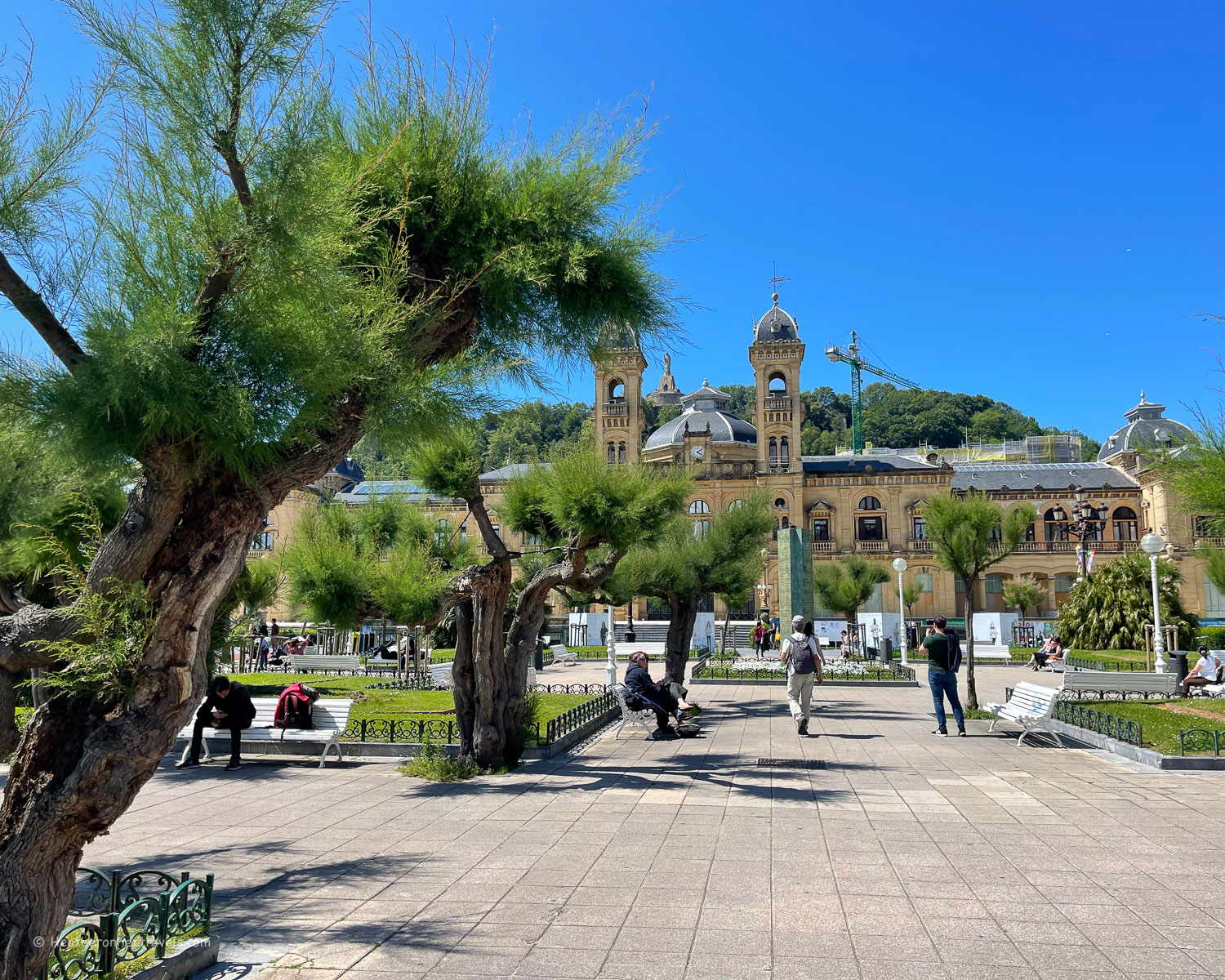
The promenade overlooking La Concha beach that runs beside the park is a popular spot for street performers, but do keep a close eye on your valuables, as it’s a bit of a tourist hot spot.
Tip: If you see the gentleman selling handmade wafers be sure to buy some. He’s the last of these artisan sellers, where once there were many selling these snacks as a treat for children.
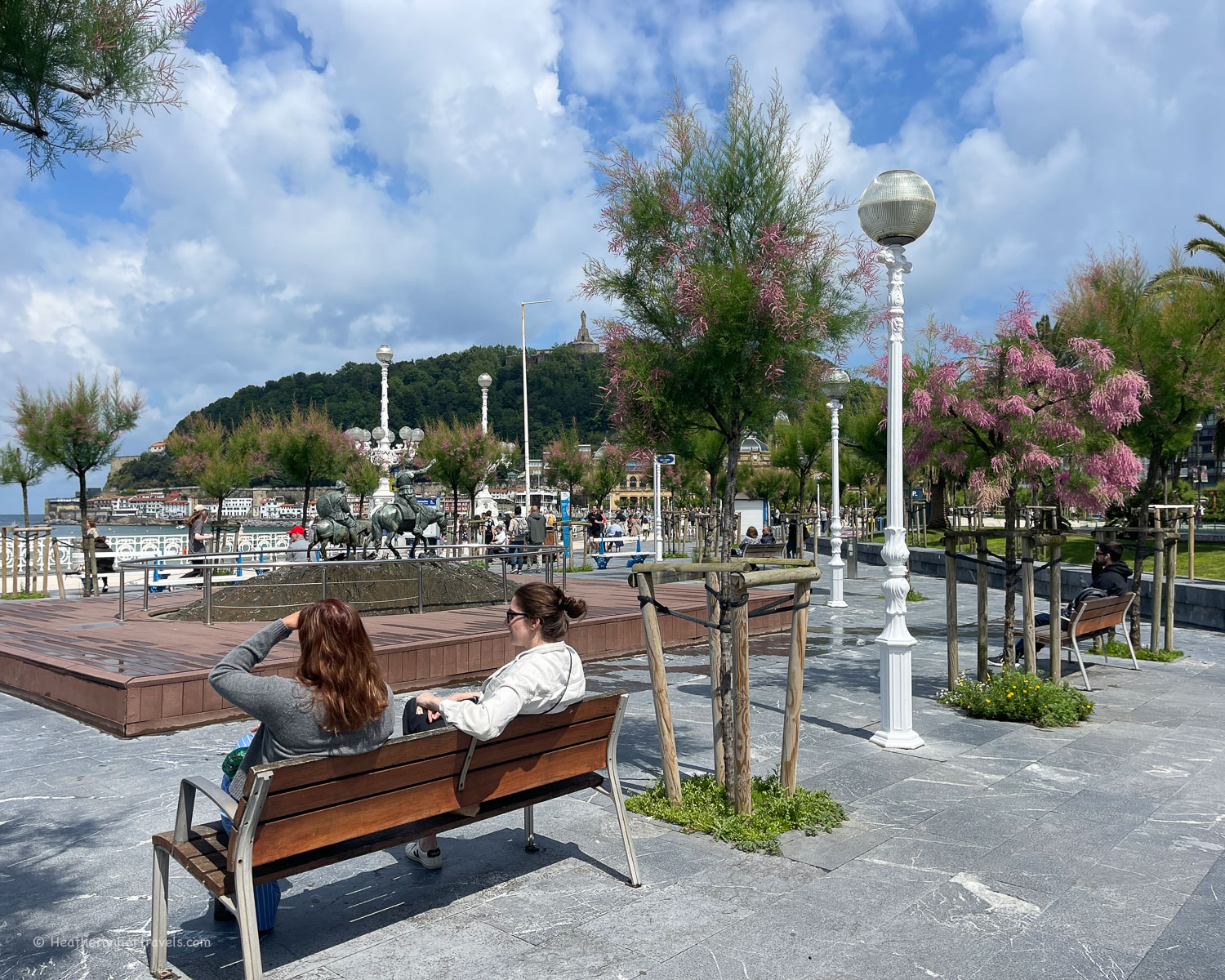
9. La Concha Beach – golden sand and calm waters
La Concha beach is one of the jewels of San Sebastian, a long sweep of golden sand that curves around the bay. Close to the city hall you’ll find the Real Club Nautico de San Sebastian, built in curvaceous style of the 1920s. While this is a private member’s club, there’s a metal walkway nearby reaching out into the sea, that’s a favourite place for locals to swim.
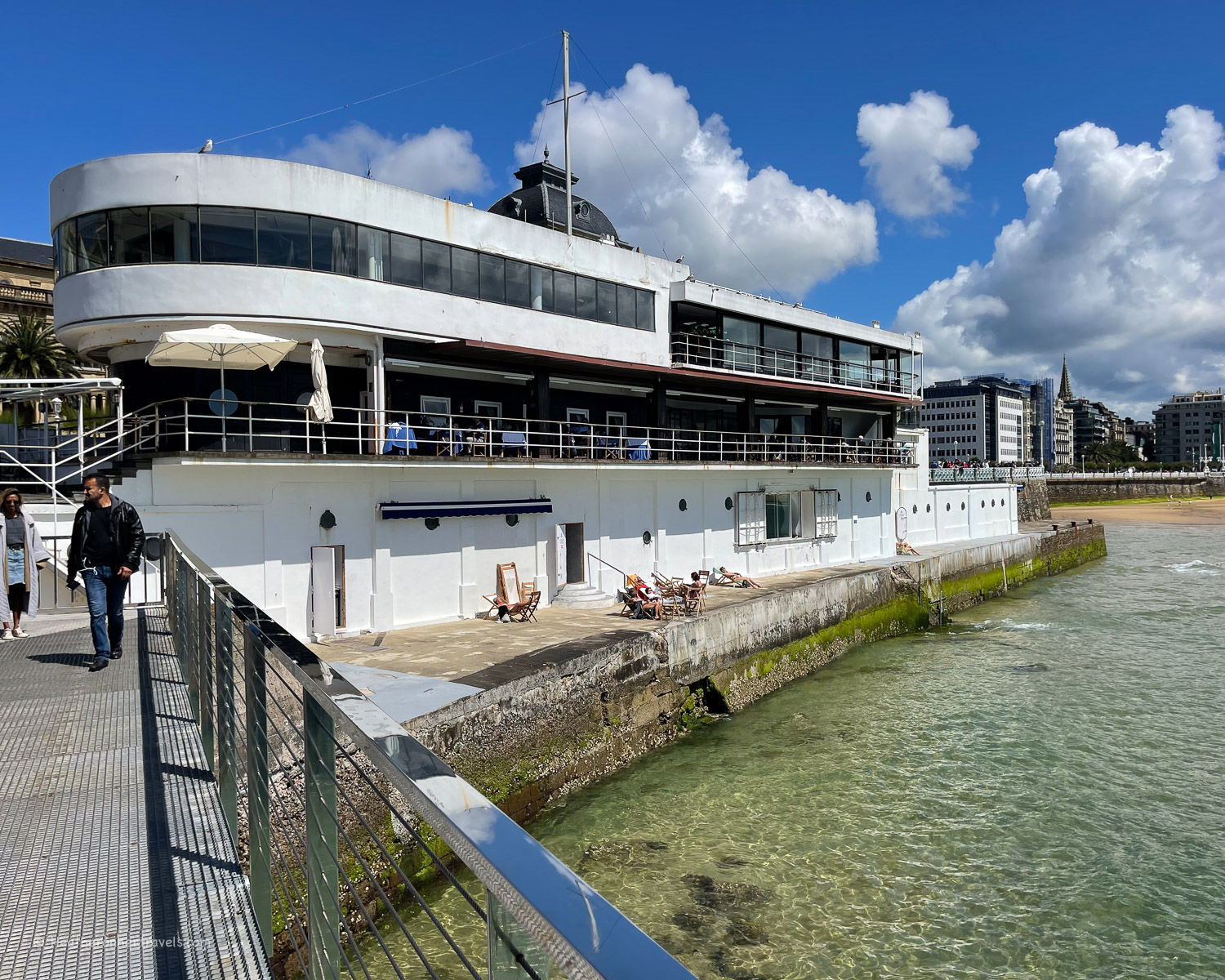
The promenade continues right along the beachfront, bounded by the famous white wrought iron railings. At low tide, the beach is often used by artists who use the flat sand as their canvas.
A walk along the seafront or a day relaxing and swimming here is one of the fun things to do in San Sebastian, especially in summer.
In the 19th century there was a craze for sea bathing and the mineral sea water was considered to have health giving properties. It was made fashionable in the 1840s by Queen Isabel II, who was advised by her doctors to bathe in sea water as a treatment for her skin complaints.
Later the Queen Regent Marie Christina loved to spend her summers here together with her court at Palacio Miramar.
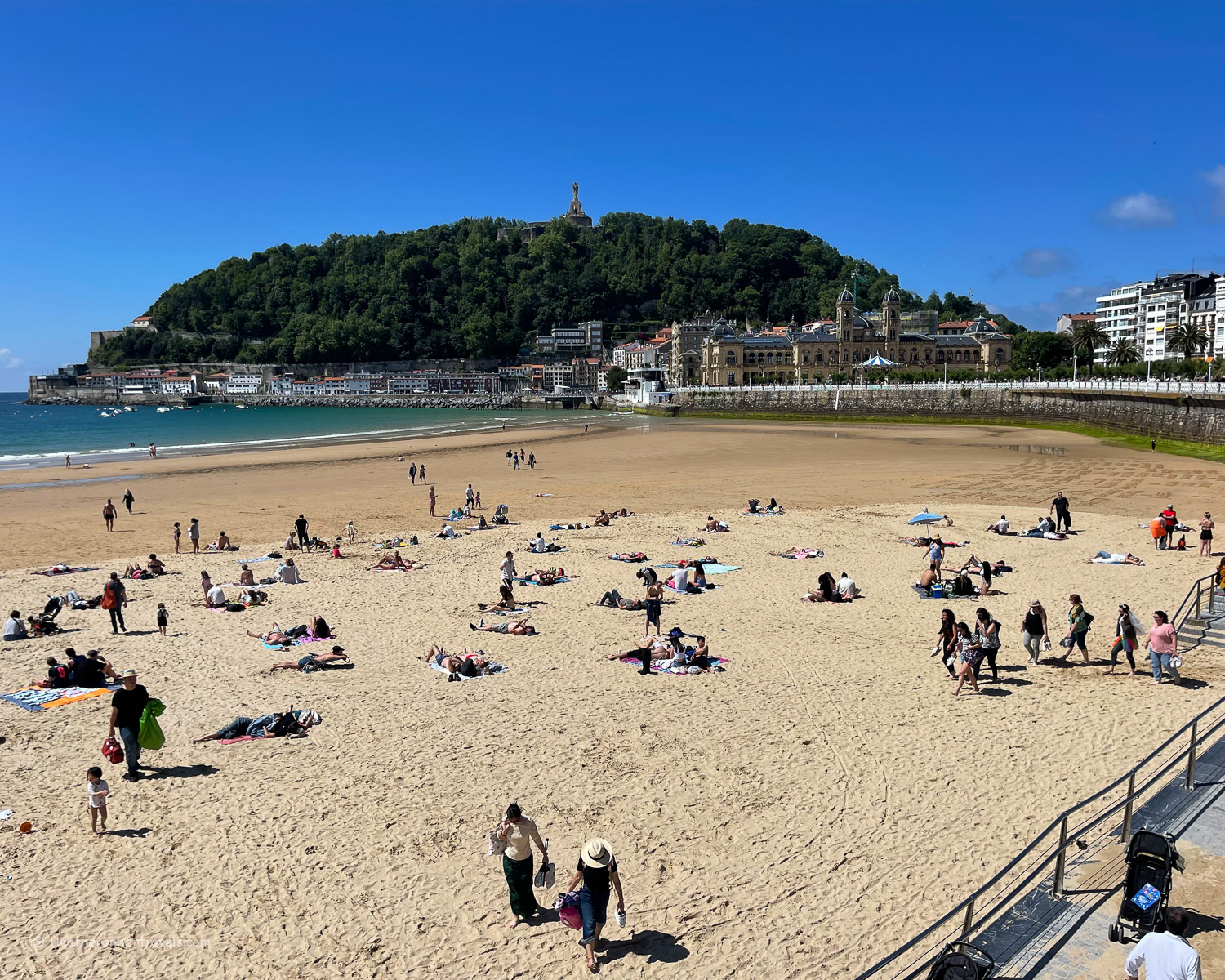
La Perla Spa
To continue the spa tradition of Thalassotherapy or treatment with sea water, book a session to use the facilities at La Perla spa. In addition to the saunas and indoor pools, the spa offers direct beach access for sea swimming.
La Perla is located in the middle of the beachfront promenade, and was one of the original sea bathing pavilions that line this part of the beach.
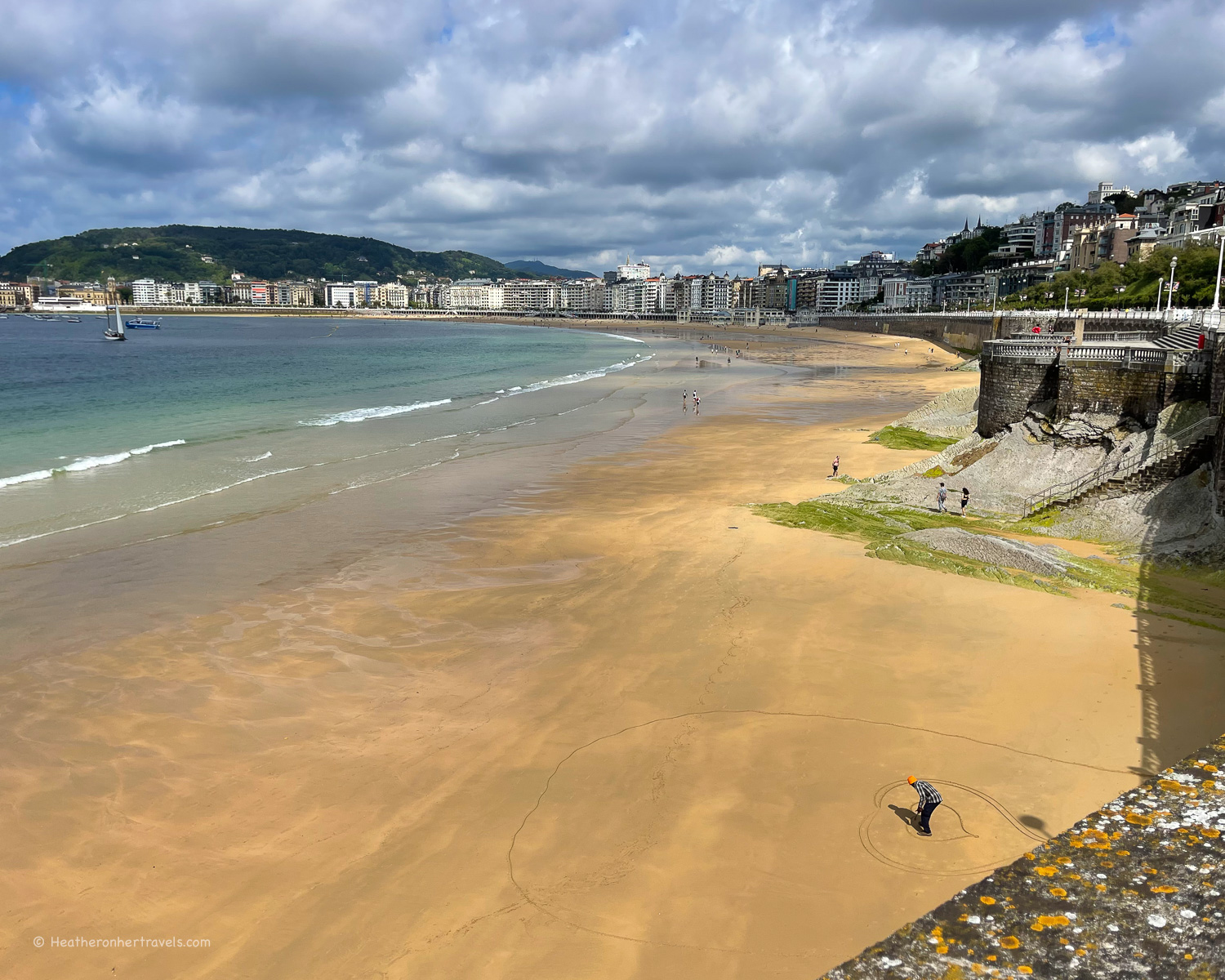
If you make the (quite long) walk from the City Hall to the other end of the beach, look out for the seafront sculpture by local artist Eduardo Chillida, which is his Tribute to Alexander Fleming.
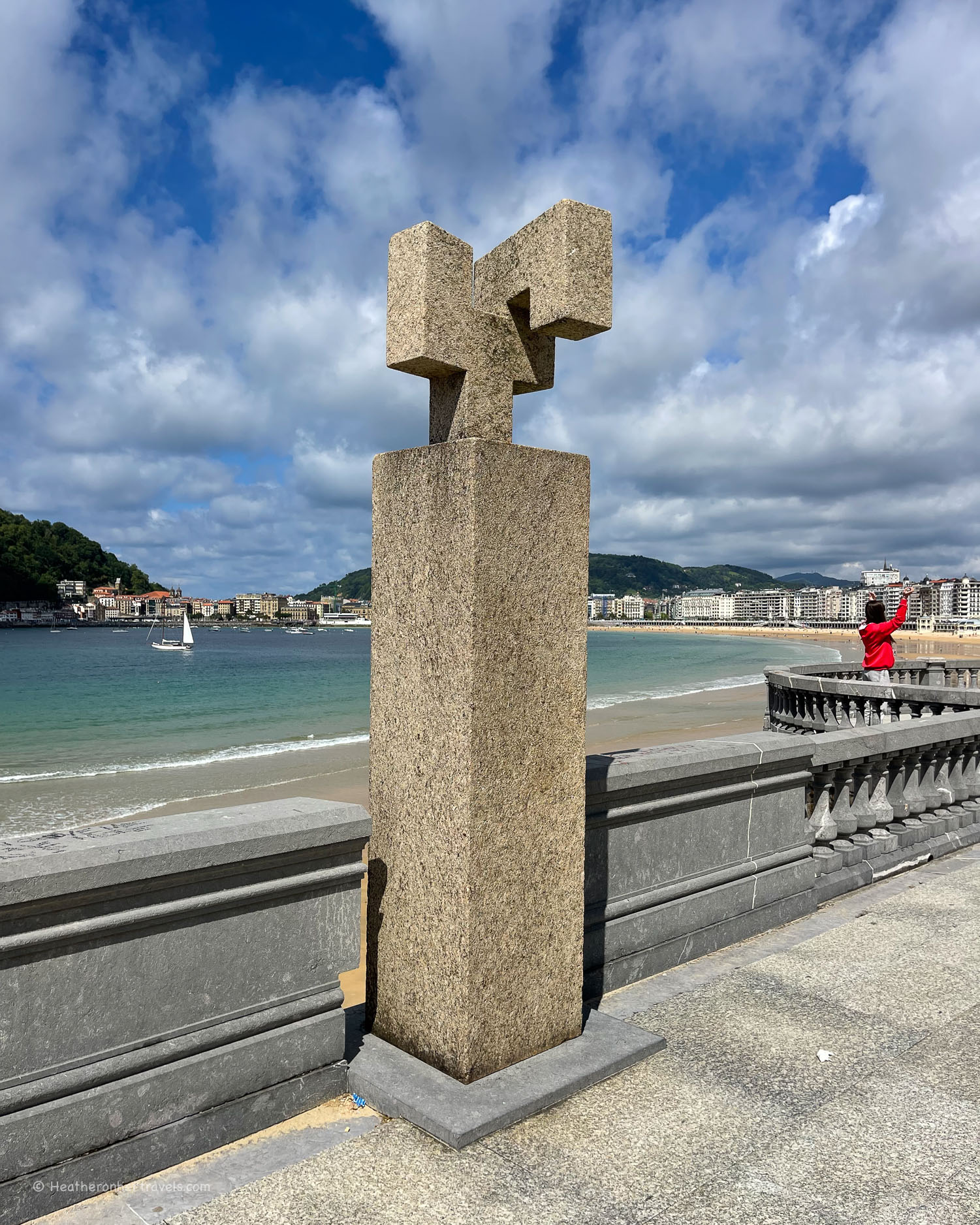
10. Gipuzkoa Plaza – a green park
A stroll along the riverfront, past the Belle Epoque landmarks of Hotel Maria Cristina and the Victoria Eugenia Theatre, will bring you to the green and shady Plaza de Gipuzkoa. It’s named after the Gipuzkoa municipality within which San Sebastian sits, with the local government’s building running along one side.
While it’s not huge, the plaza manages to pack in plenty of greenery, with a duck pond, rockery and water features. There’s the air of an English style park, with the gravel paths, shrubs and shady trees.
The small pavilion in the middle is actually a weather station, with a barometer and planetary chart. It was a useful curiosity in the days before we could all look up the weather on our phones.
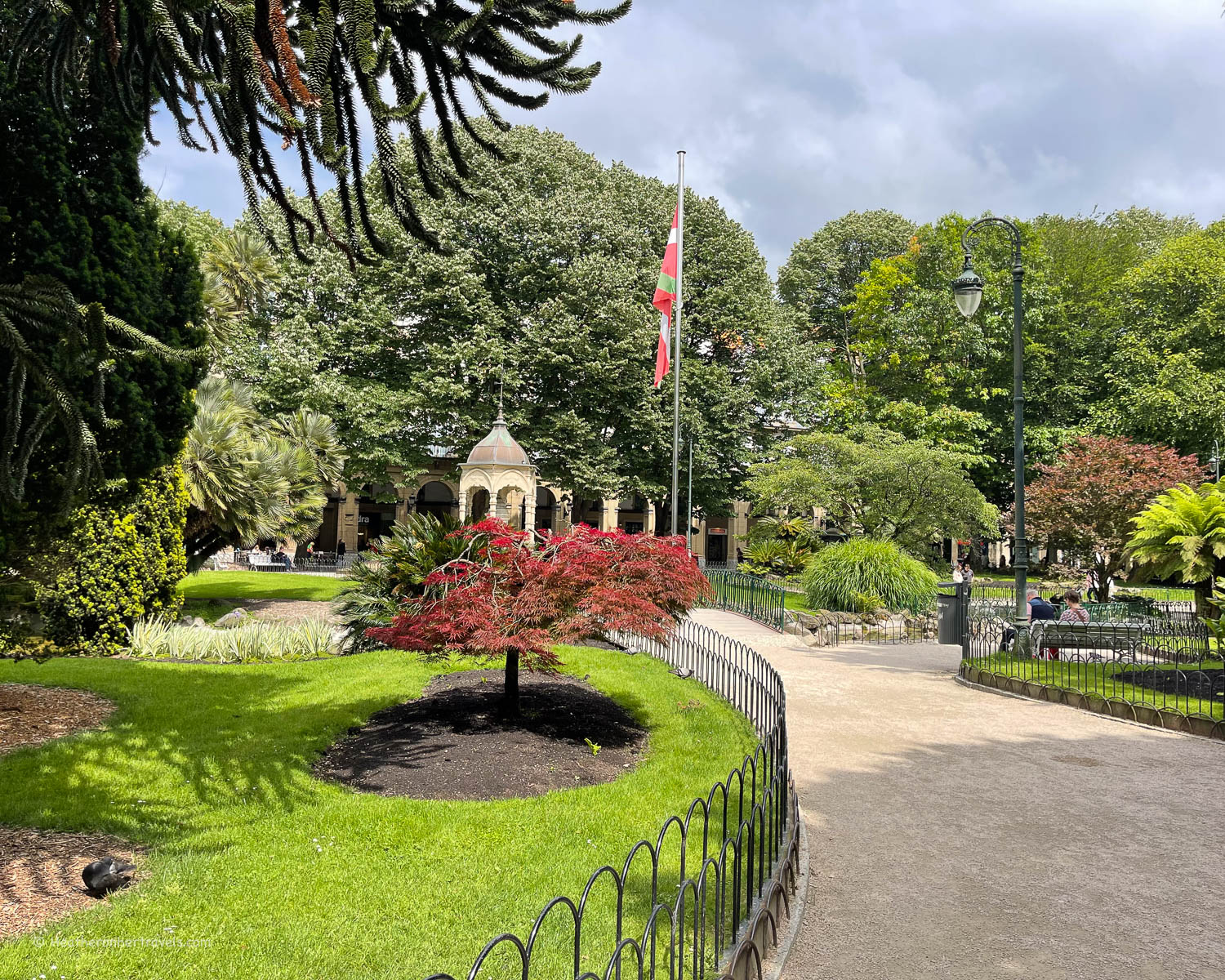
11. Buen Pastor cathedral
If you’re in the Old Town, with your back to the Basilica, you might spy in the distance the wedding cake spire of the Buen Pastor (Good Shephard) Cathedral. Like the surrounding Centro neighbourhood it was constructed in 1895 during the Belle Epoque period of San Sebastian’s expansion.
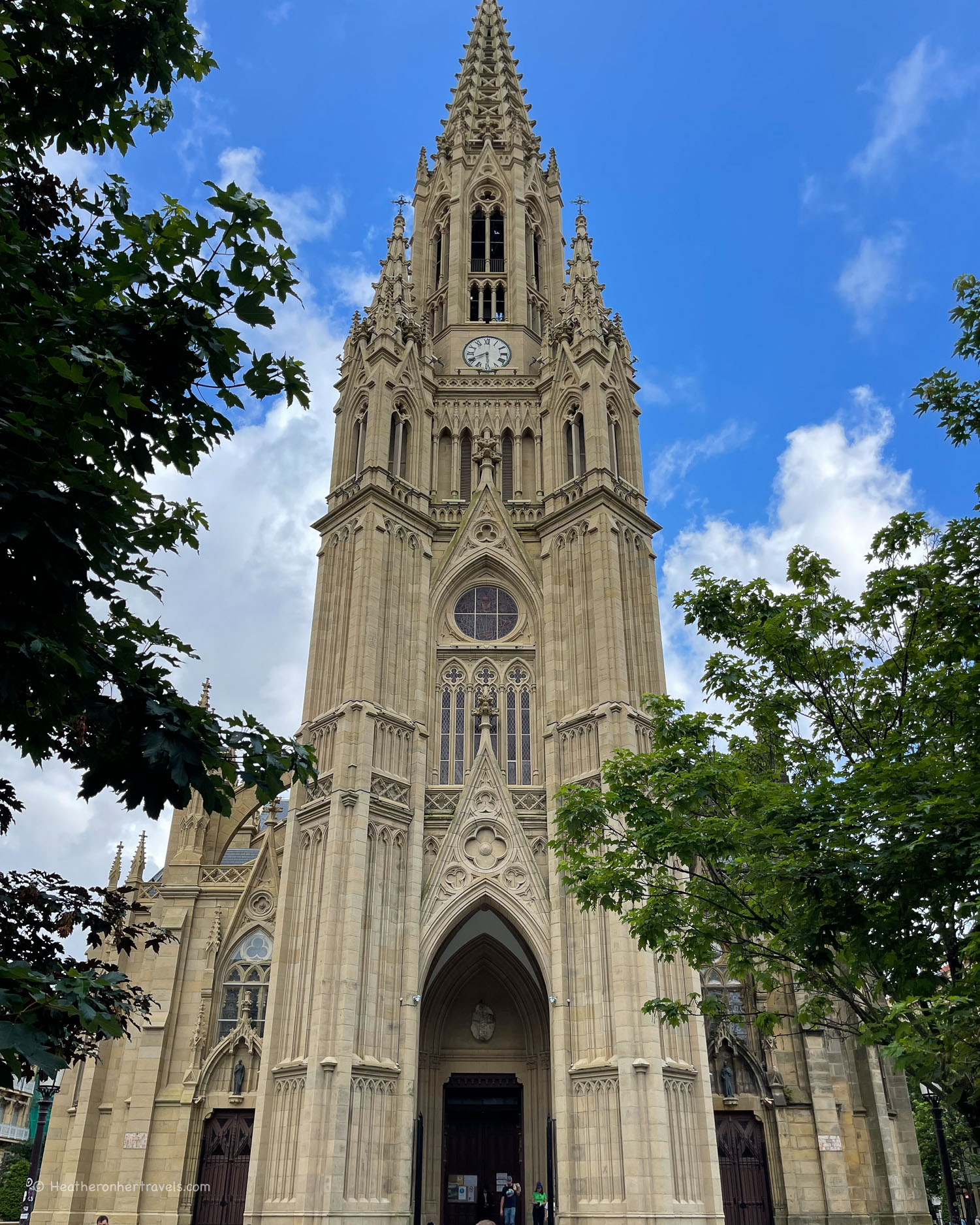
When I visited the cathedral, I found the unadorned interior stonework strangely plain, compared to Spain’s richly decorated and gold encrusted churches of earlier eras. However, then the sun came out and cast magical coloured patterns on the stonework from the stained glass windows. Someone up there was telling me not to be so hasty in my judgement and find beauty in simplicity!
Above the door as you enter, there’s a simple alabaster cross donated to the cathedral by San Sebastian’s favourite sculptor, Eduardo Chillida.
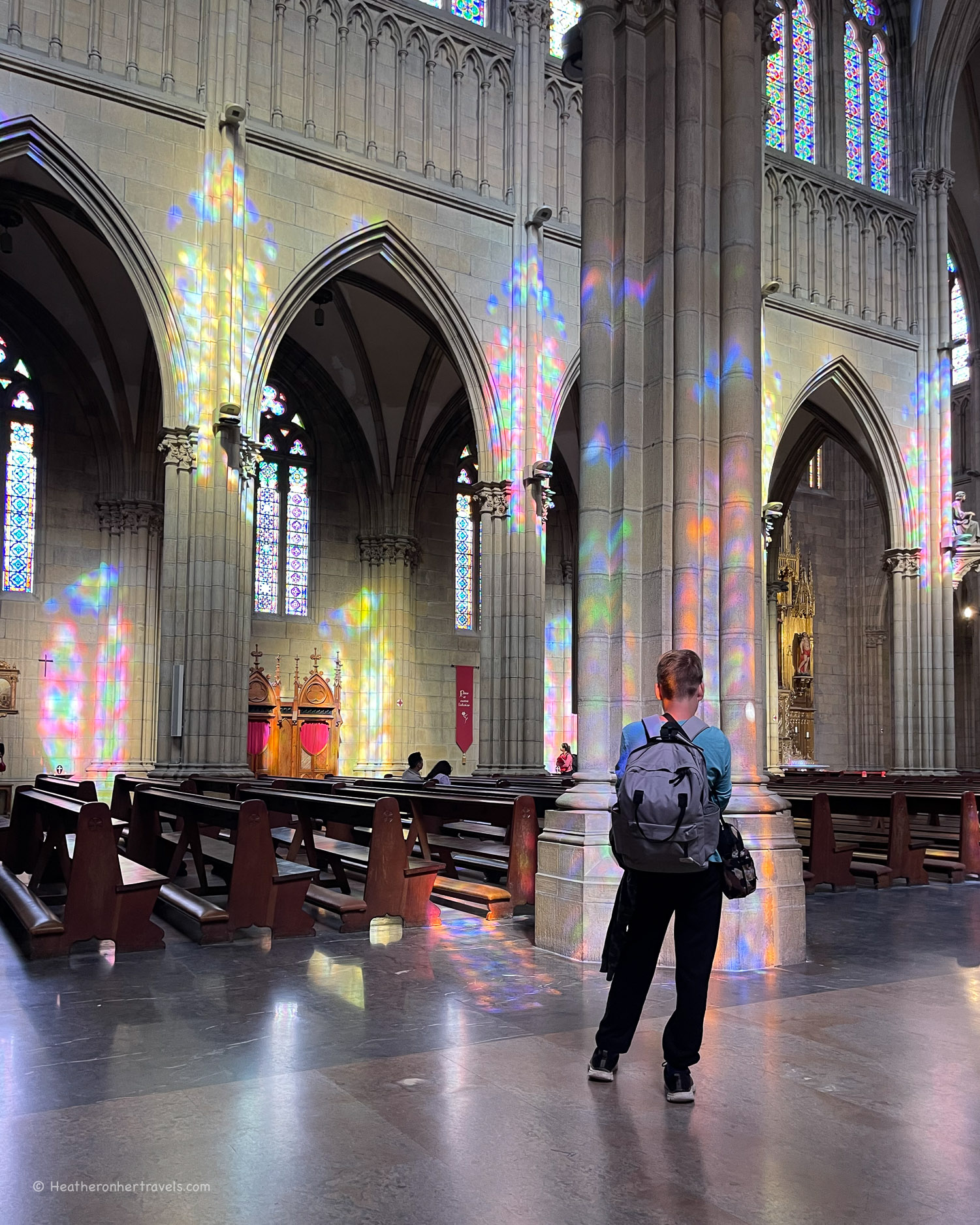
Gros neighbourhood – for surfing and boho vibe
In the past Gros was considered an unremarkable working class neighbourhood. But as it’s home to the best surfer beach in San Sebastian, the area has developed something of a trendy, hipster reputation.
This is where we stayed, as there are plenty of small hotels and guest houses which tend to be quieter at night than the buzzing Old Town. It’s a convenient location to base yourself, an easy walk to the Old town in one direction and the bus and train station in the other.
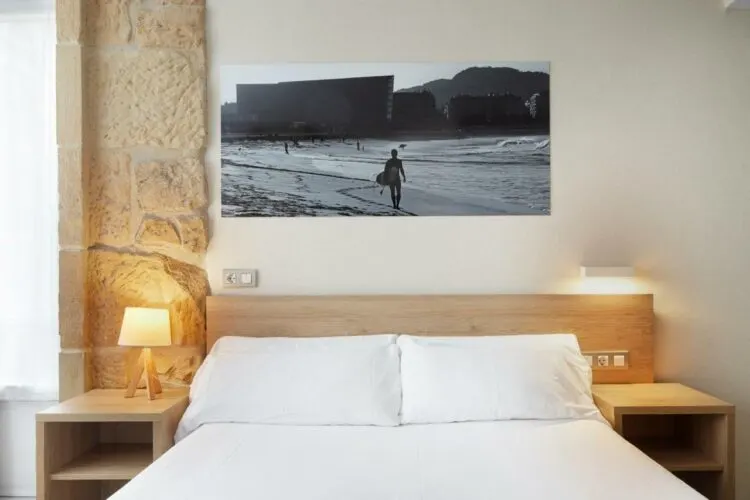
Welcome Gros Hotel is a contemporary self checkin budget hotel in the Gros neighbourhood.
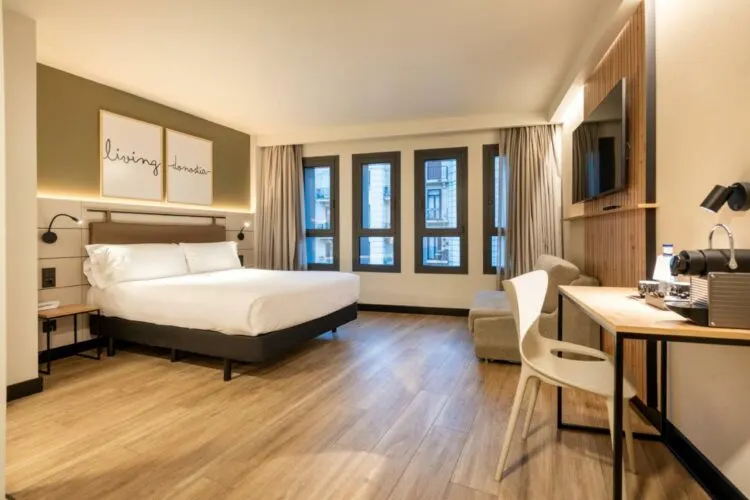
The Leonardo Boutique Hotel is a stylish boutique hotel, 300M from Zurriola Beach
12. Playa de la Zurriola – best for surfing in San Sebastian
Zurriola beach has become the go to spot for the younger crowd, with a broad stretch of golden sand for sunbathing, volleyball and beach tennis. It’s less protected than La Concha or Onderrata beaches, with bigger waves that make this a great location for surfing.
If you fancy trying some surfing in San Sebastian, you can arrange a lesson or rent a surf board from one of the surf schools located nearby.
Bera Bera surf school has a location right on the beach, while Pukas Surf has a shop just across the road. In this neighbourhood, we got used to seeing wetsuit clad surfers carrying their boards along the streets back to their cars or apartments.
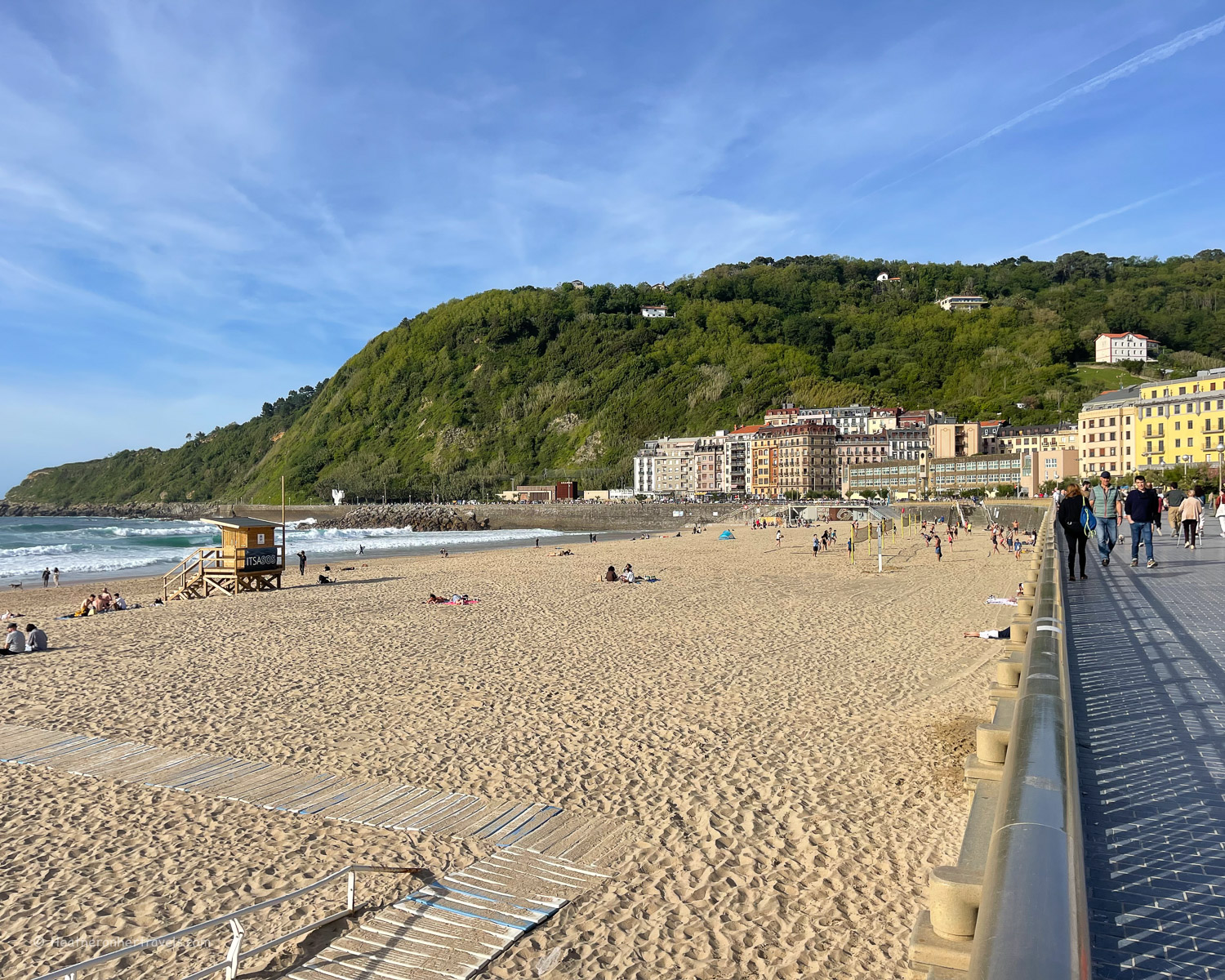
Kursaal Convention Centre
Dominating one end of the beach is the Kursaal Convention Centre, designed by Spanish architect Rafael Moneo. It’s a grey block of a building that is inspired by the huge square rocks that are piled along the river mouth and coastline, designed to protect from the battering waves.
The building opened in 1999 and is somewhat controversial since it replaced one of the 19th century casino buildings that stood on this spot. I attended a conference there, and didn’t find it especially attractive outside, and rather functional inside.
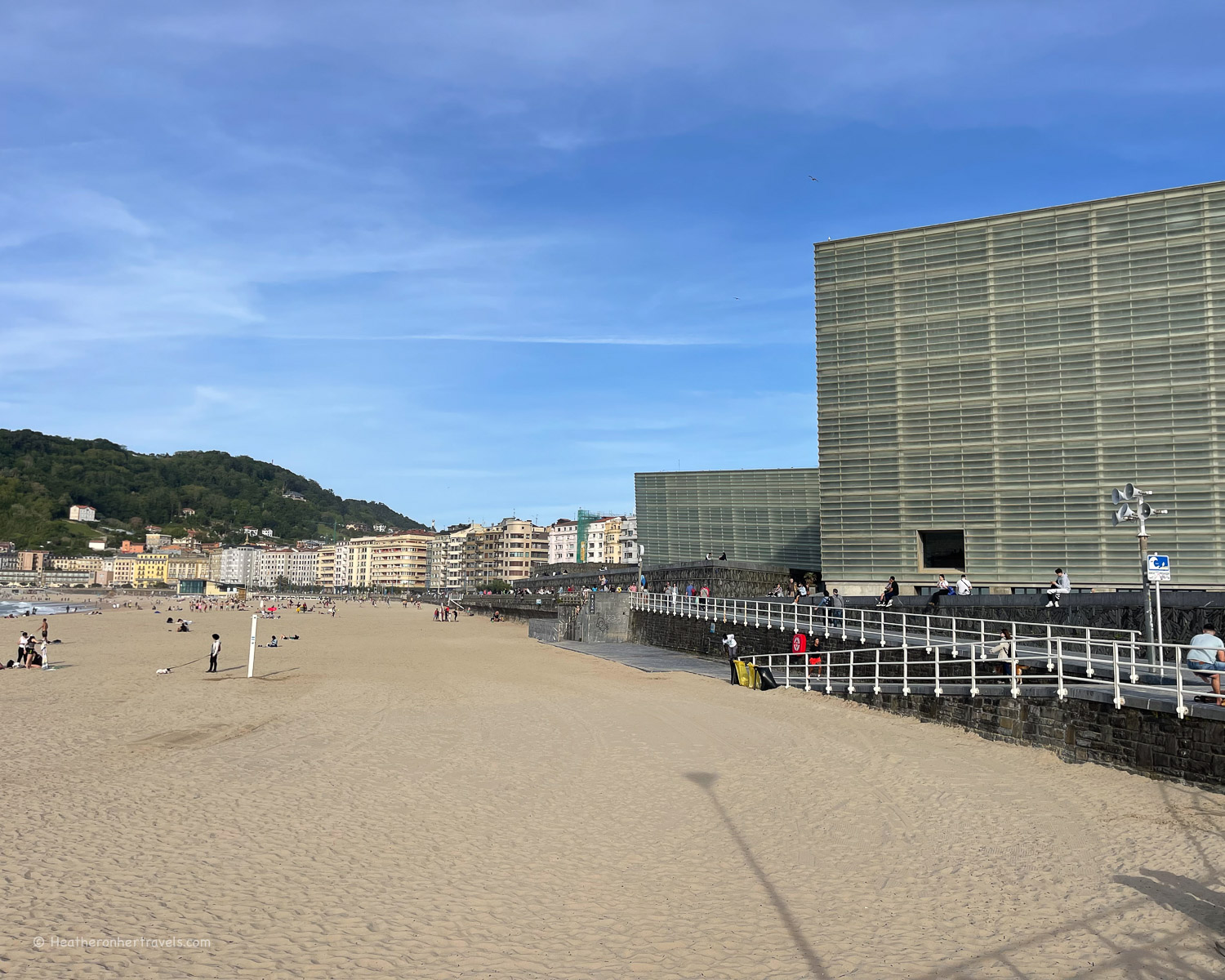
At the opposite end of the beach is a stretch of sea wall that’s a favourite spot for people to meet friends and watch the sunset. The streets of the Gros neighbourhood behind the beach are worth exploring in the evening if you are looking for a Pinxtos bar or restaurant for dinner.
The whole area has a much more local feel than the Old Town, which is packed with tourists. We liked some of the bars and restaurants near Plaza de Cataluna such as Bar Bergara or those around Calle Pena y Goni such as Bar Desy (try the burgers) and Bodega Donostiarra.
Antiguo neighbourhood
While it doesn’t seem very old, the Antiguo neighbourhood behind Ondarreta beach is actually where the original settlement of San Sebastian grew up from the 12th century, clustered around the monastery of San Sebastian.
However it proved difficult to defend from the sea, so most of the commercial activity moved to the other side of the bay to the protection of the walled Parte Vieje. These days, most of the streets near the beach are lined with holiday homes, many remaining from the 19th century when wealthy families would spend the summer there.
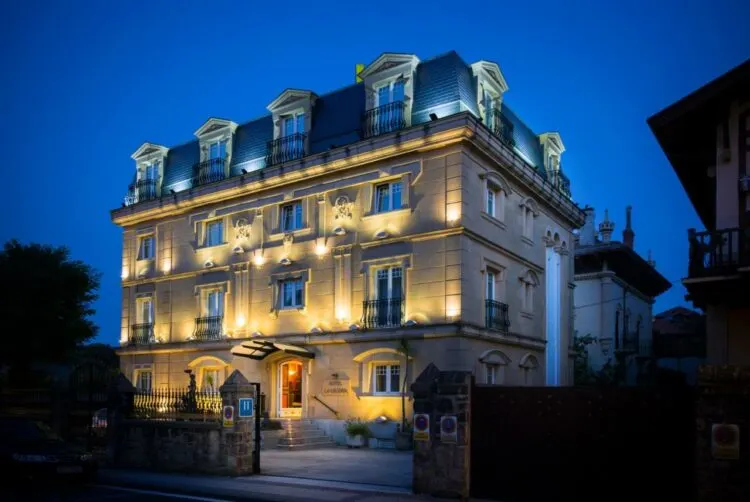
Elegant La Galería Hotel is located in a 19th century building opposite Ondarreta Beach.
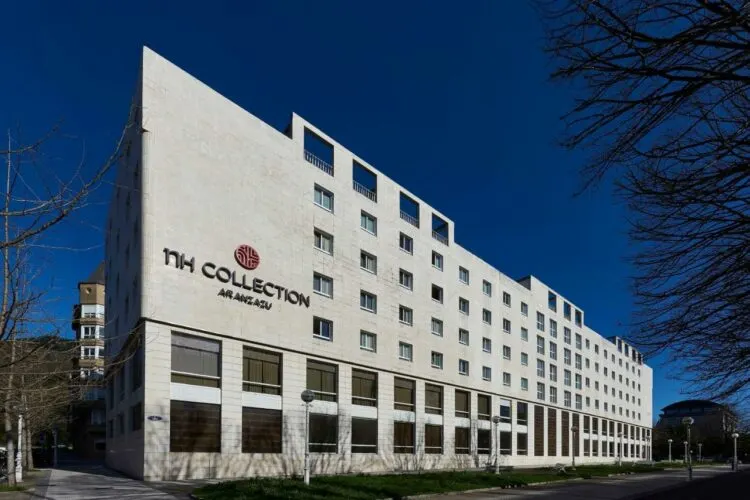
The NH Collection San Sebastián Aranzazu is a stylish modern hotel 300M from Ondarreta Beach
13. Miramar Palace – a royal summer residence
In the 1890s, the Miramar Palace was commissioned by Queen Maria Christina, so that the Royal Family could have a suitable place to stay for their summer visits. It was located on the site of the old Monastery of San Sebastian and built in the style of an English country house with surrounding gardens and lovely views over the bay.
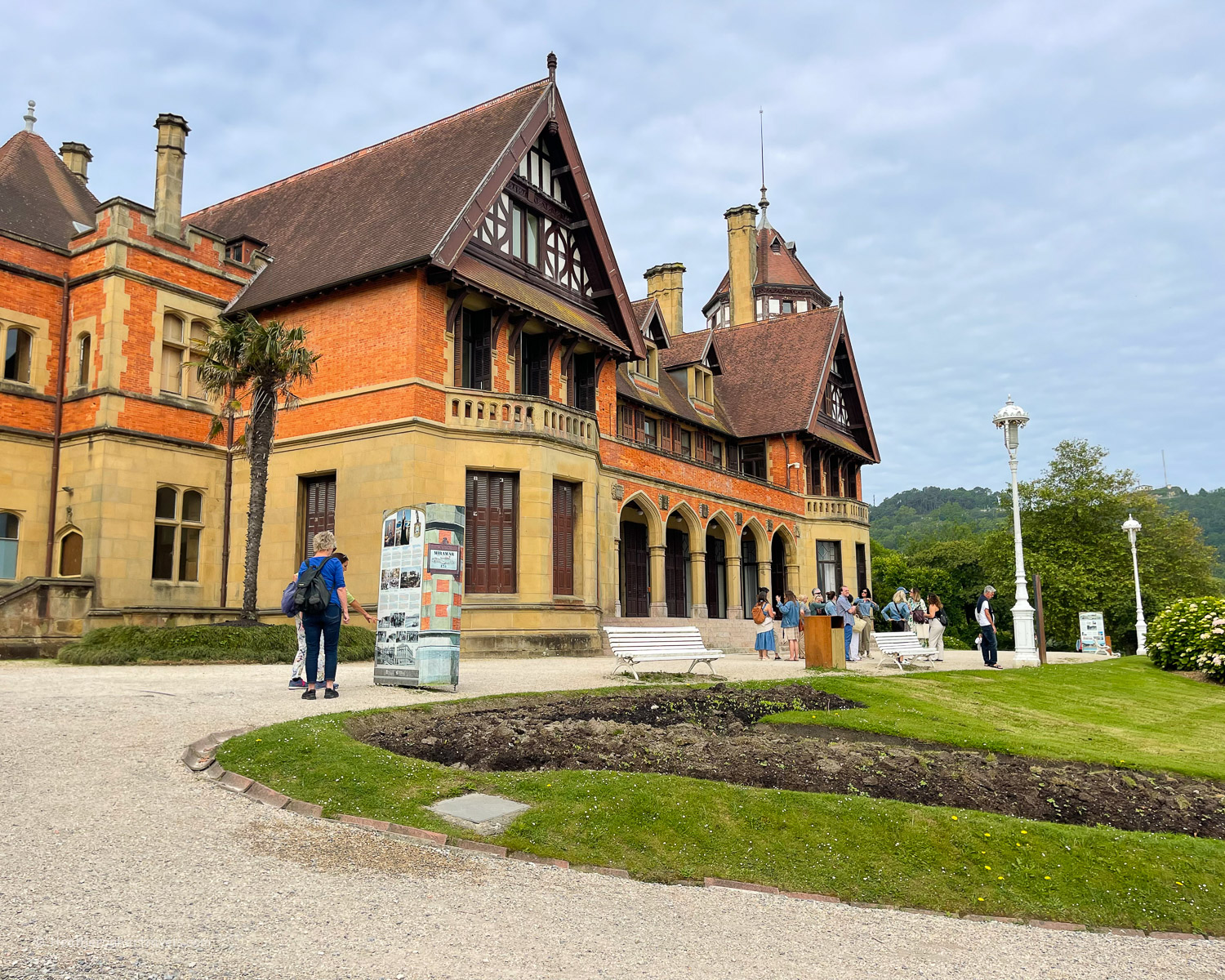
Over the following century, the Royal family sold off parts of the estate, which was eventually purchased by the City Council. The pretty gardens are open to the public, with information signs about the history of the Palacio. However, the house itself is generally closed to the public and used for summer schools or rented out for functions.
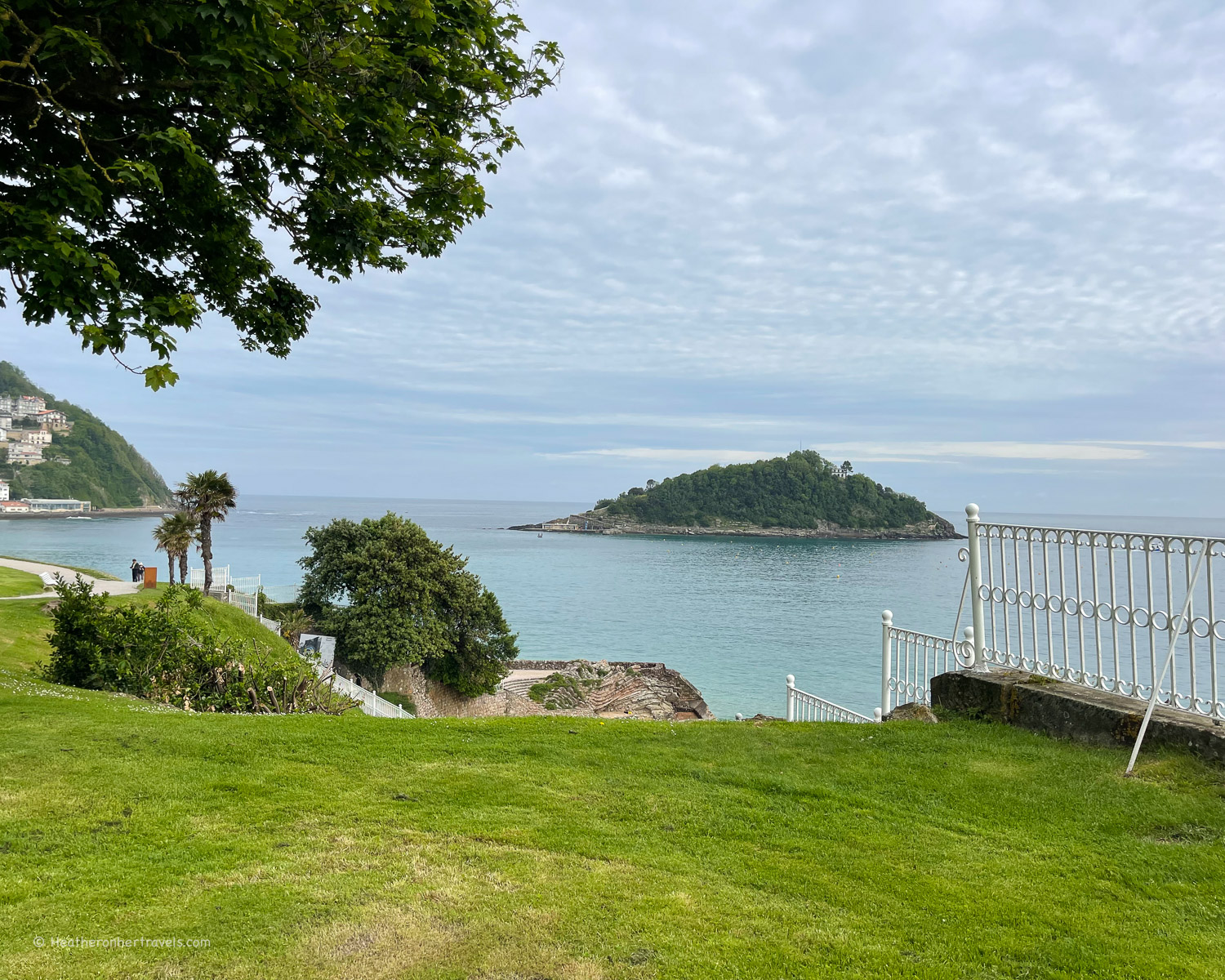
Immediately below the Miramar Palace, the road runs through a tunnel, with a pedestrian walkway to one side. In 2016 this pedestrian tunnel was decorated by artist Víctor Goikoetxea, with an artwork known as “Miramart”, evoking the play of light falling through the underwater marine world.
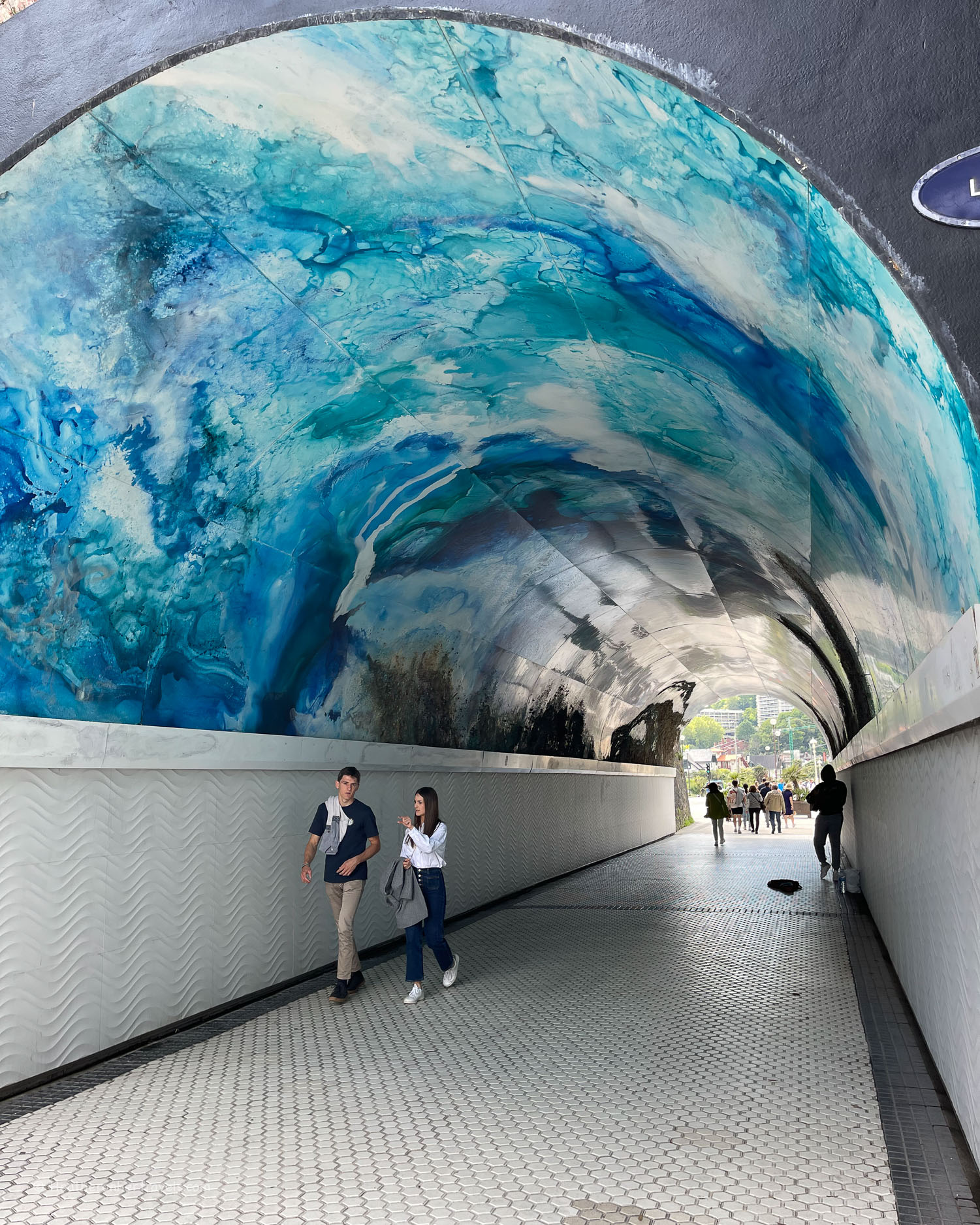
14. Ondaretta Beach – sheltered and family friendly
While Ondarreta Beach is a smaller extension of La Concha, it shares the same broad stretch of golden sand, only divided by a small rocky promontory.
Ondarreta is protected from the ocean waves by Isla Santa Clara, with shallow calm water that makes it an ideal beach for families. It’s backed by the pretty public park, with benches, pathways and tamarisk trees.
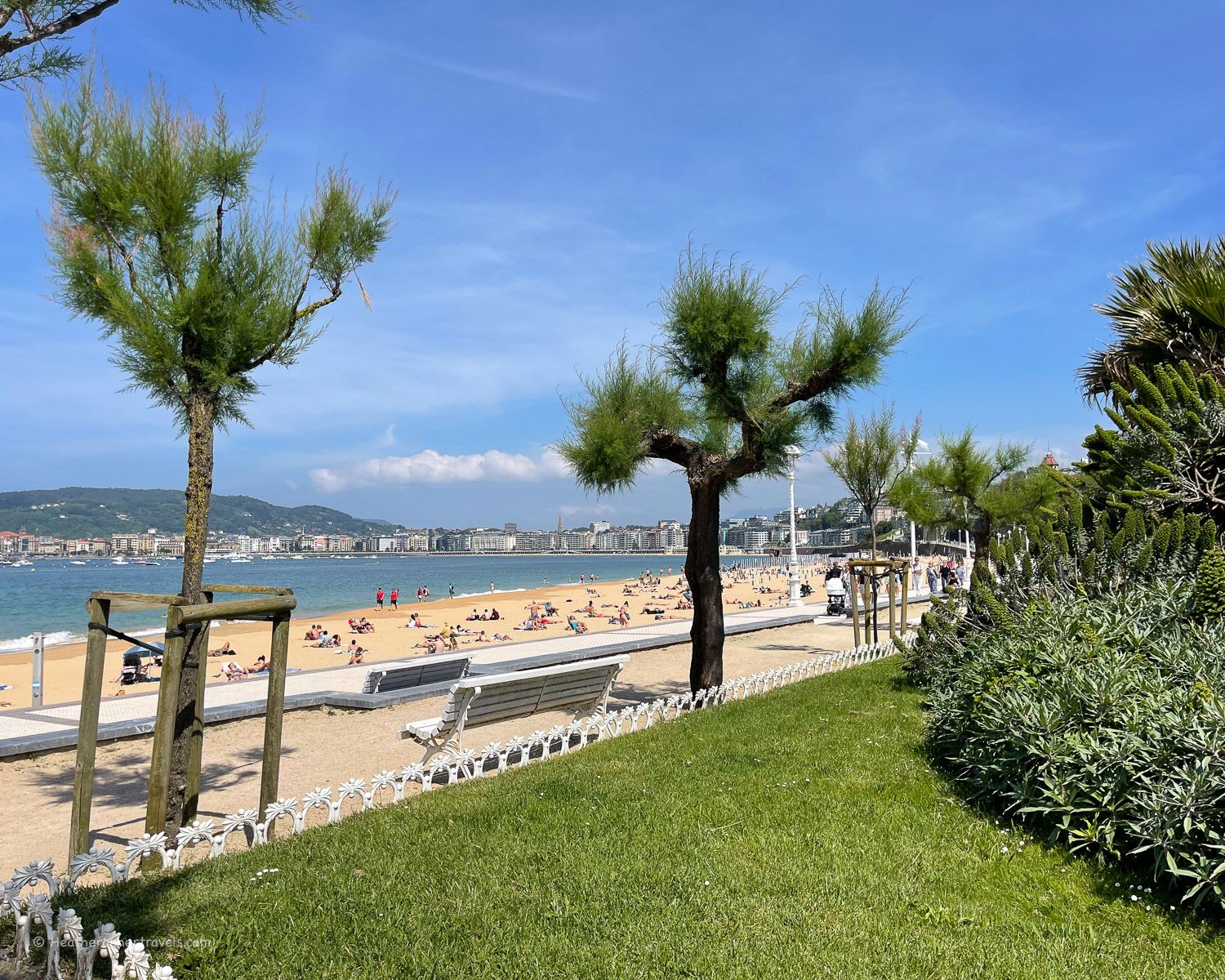
There are excellent facilities here, with a children’s play area, vintage blue and white stripe beach tents and public changing rooms, where for a small fee you can use the showers and lockers.
In summer, when the water is calm, confident swimmers may like to try swimming the half a kilometre over to Santa Clara Island, with a floating platform to break your journey halfway.
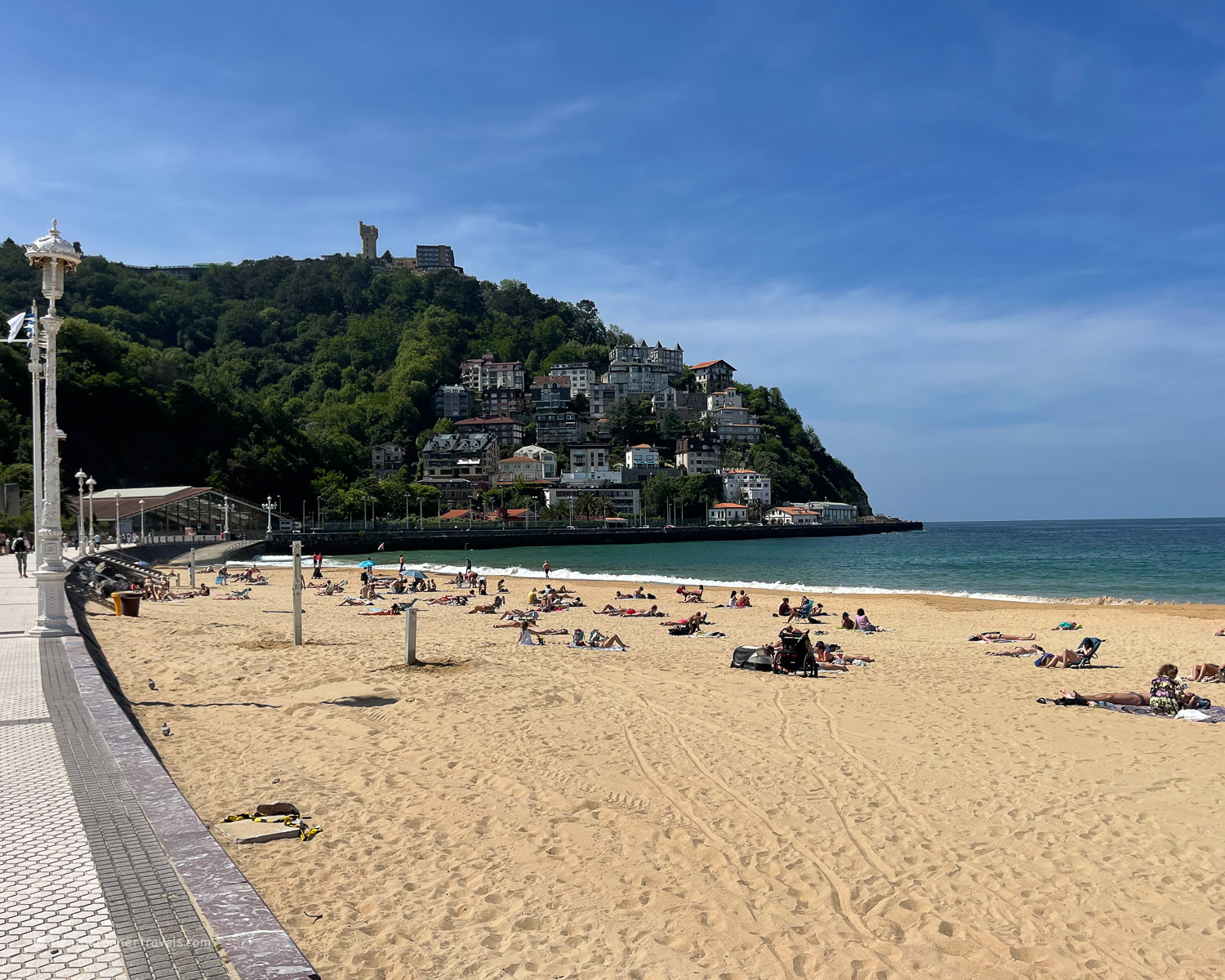
Igueldo neighbourhood
At the western end of La Concha beach is another wooded hill overlooking the bay, known as Monte Igueldo. The neighbourhood around is green and wooded, with just a few older houses set on the hillside.
Where to stay in Igueldo
Mid-range – Mercure Monte Igueldo
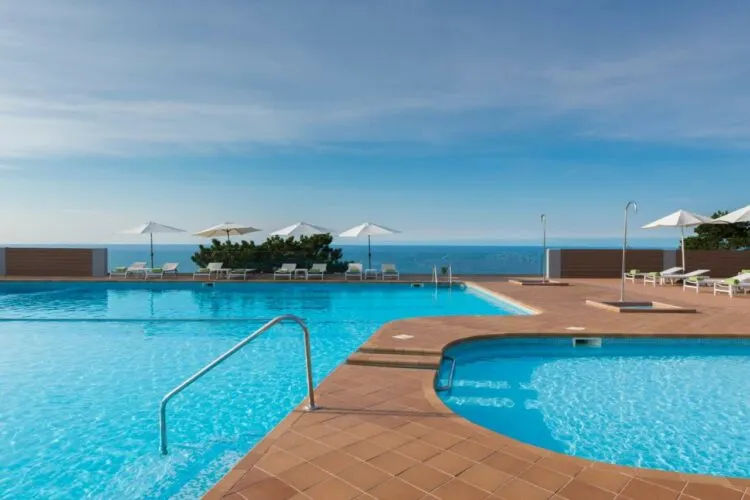
The Mercure Monte Igueldo has a picturesque setting on Mount Igueldo, with impressive views of San Sebastian Bay.
15. Monte Igueldo – take the cablecar for stunning views
The easiest way to get to the top of Monte Igueldo, is to take the vintage funicular, which opened in 1912. It runs up and down every 15 minutes, although you can also walk up the steep winding road (Paseo del Faro), or take the bus if you prefer. It was a fun ride as the funicular rose up the hill, although most of the views on the way up are obscured by trees and houses.
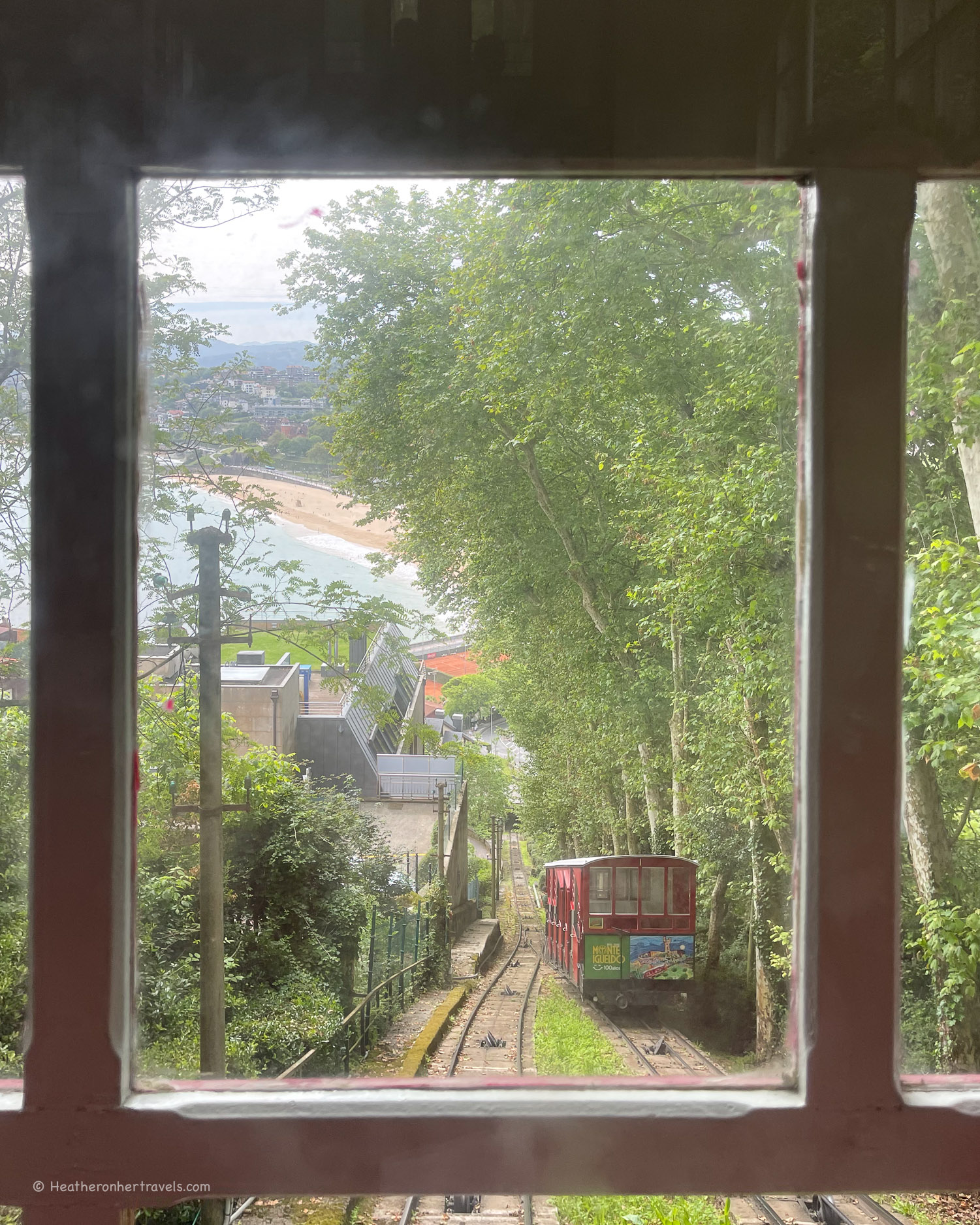
Once at the top there’s a large terrace, offering sweeping views across the bay towards La Concha beach and the Old Town. For even more striking views you could climb to the top of the tower, which was once used as a lighthouse. This is a fun place to come in the evening or at sunset, with some cafes and food stalls around the viewing terrace.
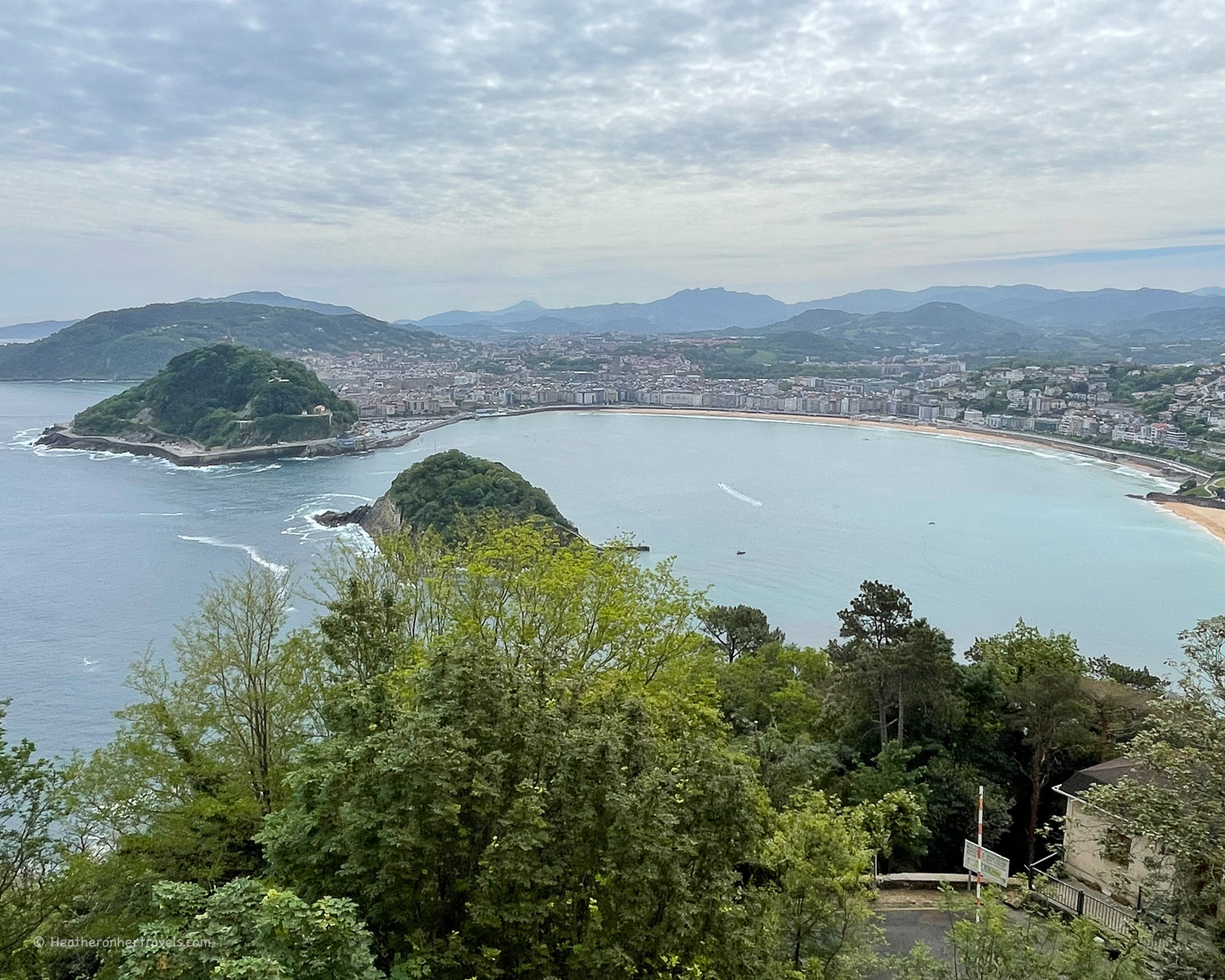
The small amusement park here dates back to the 20th century, with old fashioned carousels, roller coaster and funfair rides. It’s a favourite with families and many San Sebastian’s residents have fond memories of coming here as children.
Most visitors come to the park at weekends, holidays and on summer evenings, perhaps after a day on the beach, so check the opening hours if you’re going to Monte Igueldo mainly for the funfair.
16. Peine del Viento – the comb of the wind sculpture by Eduard Chillida
I love discovering art and sculpture that blends seamlessly into the landscape, like the Peine del Viento sculptures that sit just below Monte Igueldo. The sculptor, Eduardo Chillida was born in San Sebastian and this is his master work, designed in collaboration with architect Luis Pena Ganchegui.
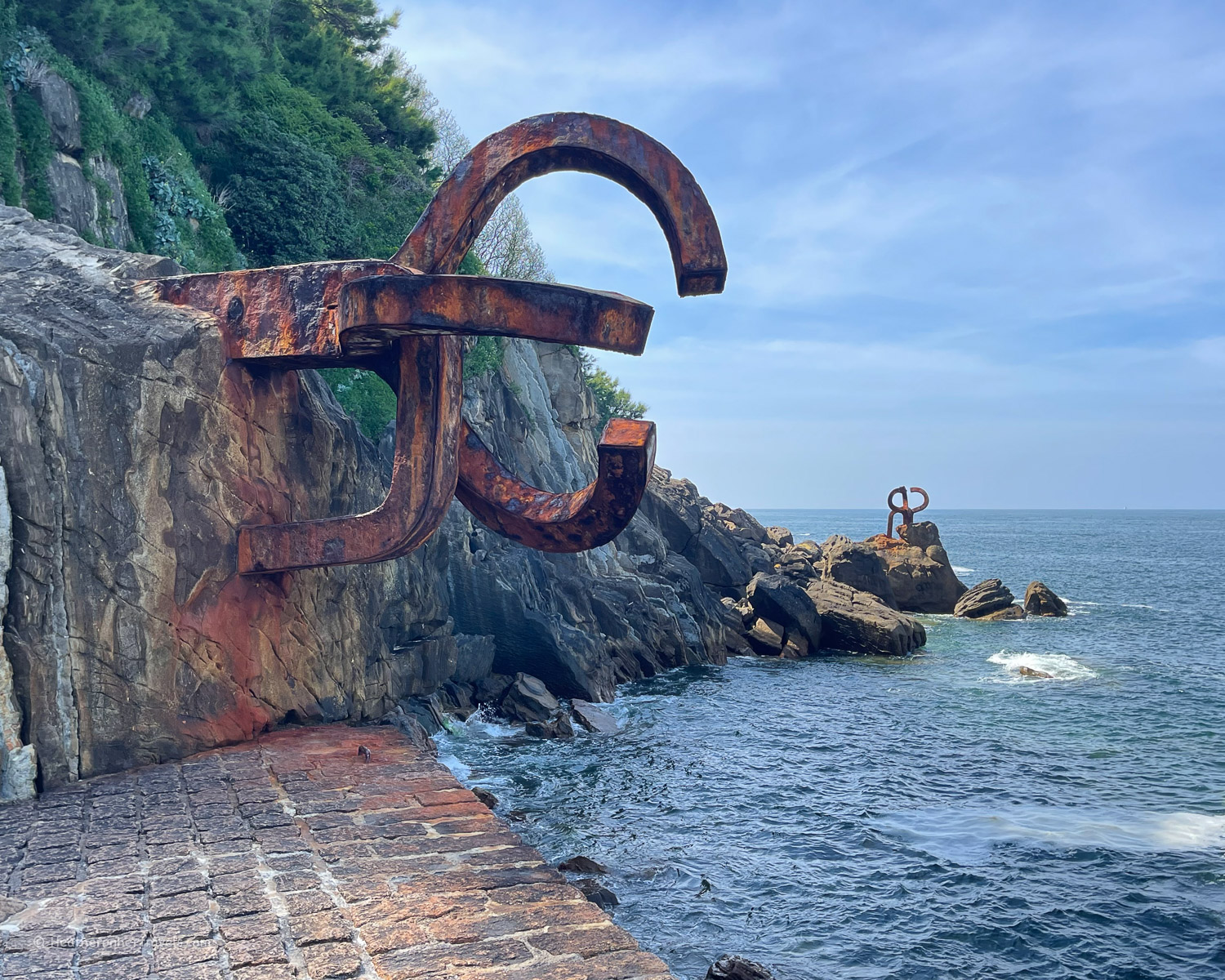
If you wander along the path at the far end of Ondarreta beach, you’ll come to the wilder area of rocks where the three sculptures are installed. These eroded iron hook like sculptures are inspired by the wind and waves that come crashing down on the shore, designed to ‘comb’ but not control the restless wind.
The sculptures meld seamlessly into the rocks, although I learned from a photo exhibition at the Tabakelara gallery that they took a huge amount of effort to install, with scaffolding and a temporary railway used to bear their weight.
While we were there on a calm summer day, in stormy weather, the waves crashing around create a dramatic backdrop for the artworks.
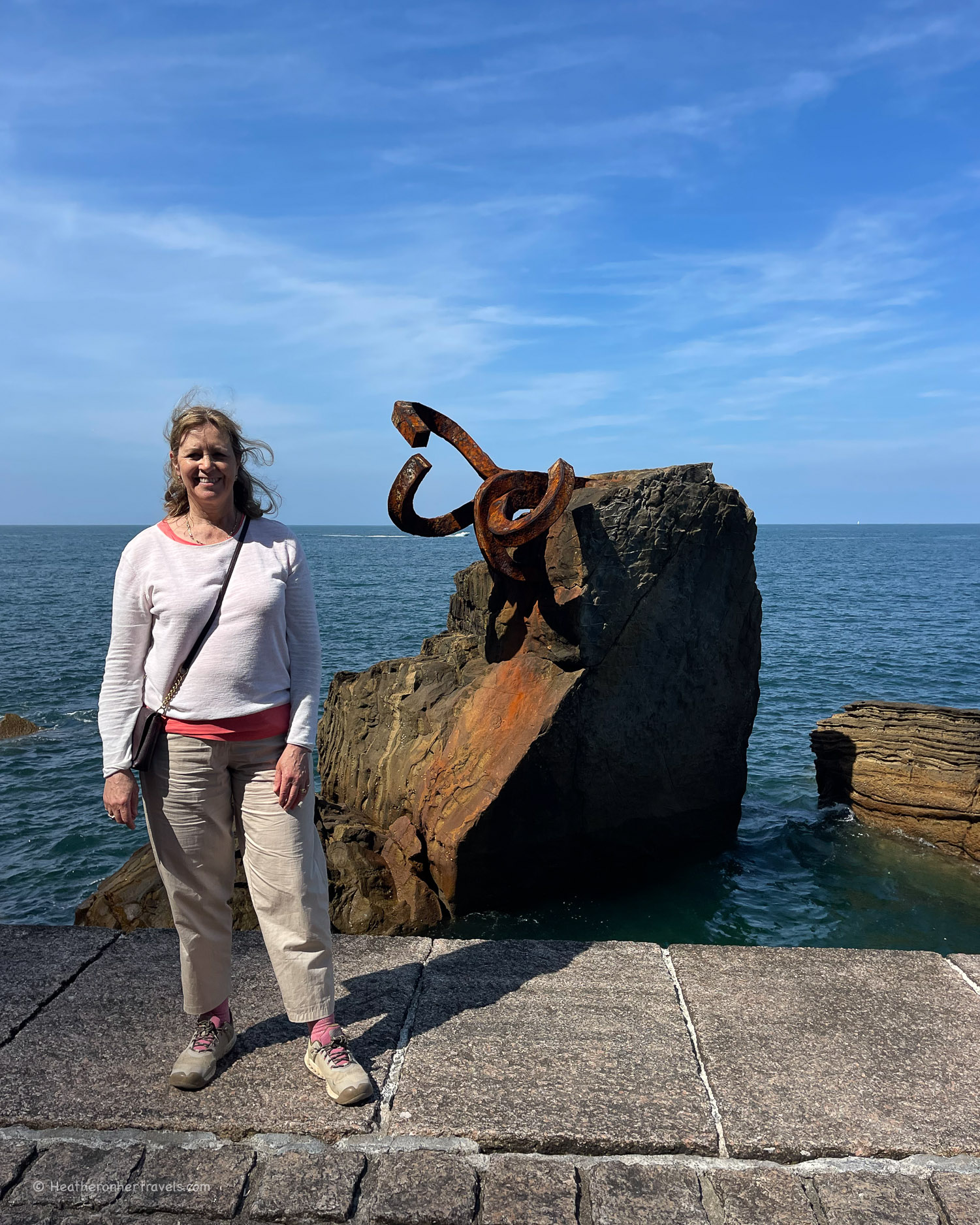
There are also blow holes installed into the cobbled terrace, that make an eerie sound like a whale if you stand over them. Beware getting an unexpected drenching of sea spray, if the waves are high.
Egia neighbourhood – the former industrial area
Most people don’t make it to the more industrialised Egia neighbourhood, unless they are arriving or departing via the train and bus stations that are located there. But if you have time, you might wander along the riverside promenade past the Belle Epoque confection of Maria Cristina bridge.
Where to stay in Egia
Budget – Cristina Enea Rooms
Mid-range – Abba San Sebastian Hotel or One Shot Tabakalera House
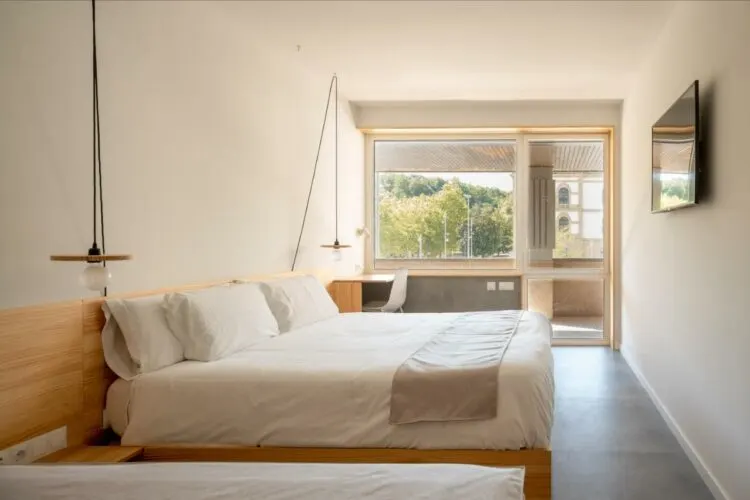
Cristina Enea Rooms is a modern budget guest house close to Cristina Enea Park.
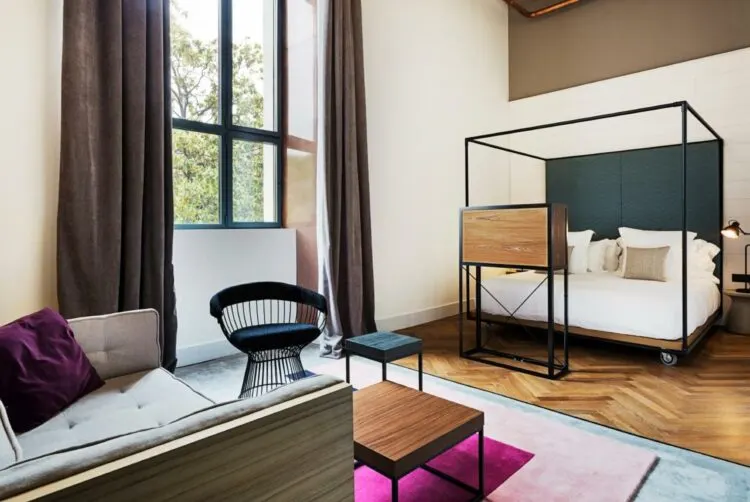
One Shot Tabakalera House – this boutique hotel is located within the Tabakalera contemporary art centre.
A couple more places to visit in this neighbourhood are:
17. Tabakalera – contemporary arts centre
When we visited, the area around the Tabakalera arts centre was undergoing a lot of development, although the centre itself was still open. It’s a free arts and cultural centre housed in an old tobacco factory and offers contemporary art installations as well as special exhibitions.
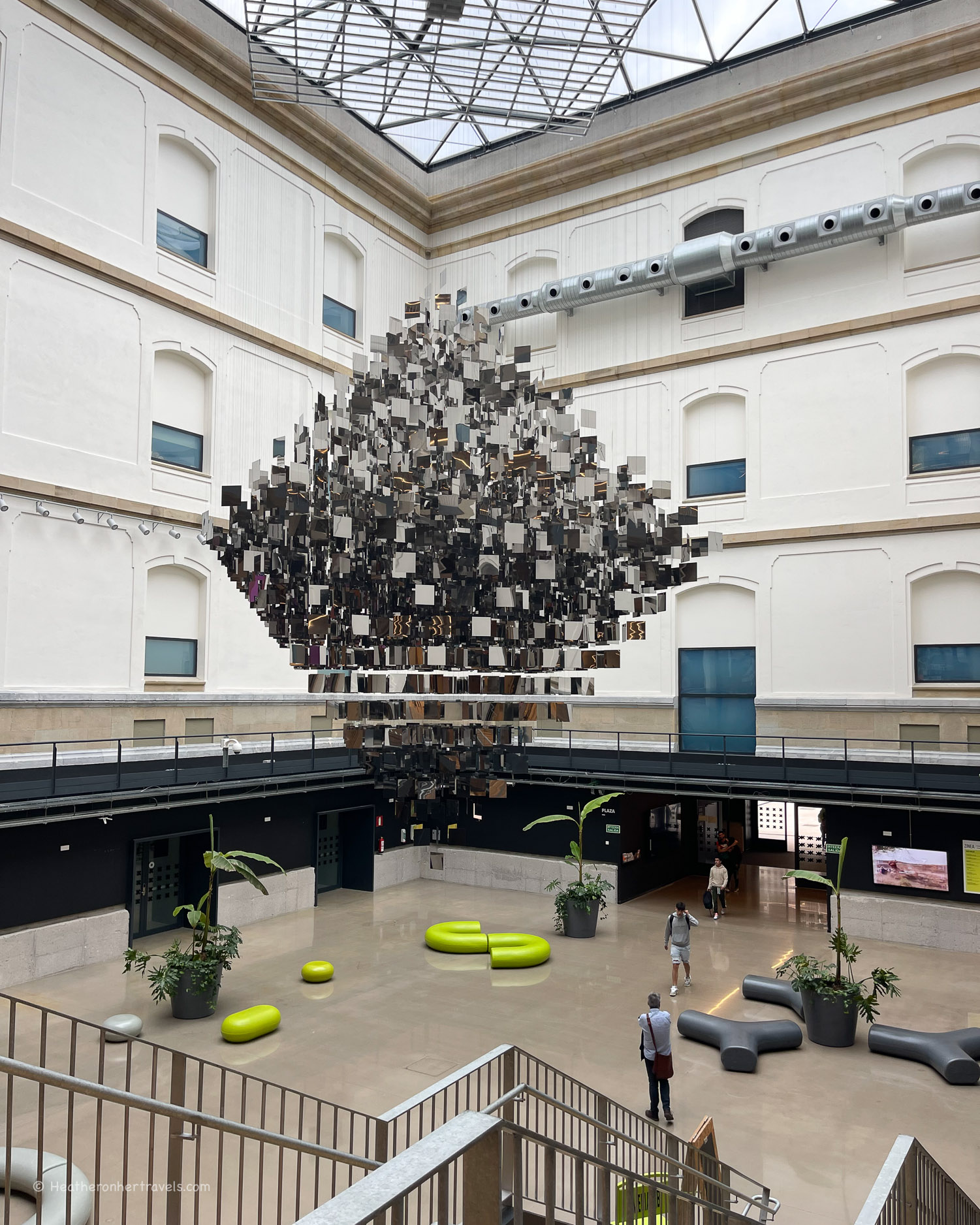
I enjoyed the free temporary exhibition while I was there, showing the images of photographer Jesus Uriarte who was a long time collaborator of sculptor Eduardo Chillida, shedding light on the way he worked and the installation of the Peine del Viente sculptures.
The 5th floor rooftop terrace houses a restaurant and events space, with views towards the river and there’s also a ground floor cafe and design hotel One Shot Tabakalera, within the building.
18. Parque de Cristina Enea – the city’s largest park
At Parque de Cristina Enea, I really felt at home in the English style park with its cute gingerbread gatehouse, grassy lawns and shady mature trees. The park stretches over 23 acres and pathways rise up the slope to a large duckpond and a country house that’s been beautifully restored with modern extensions.
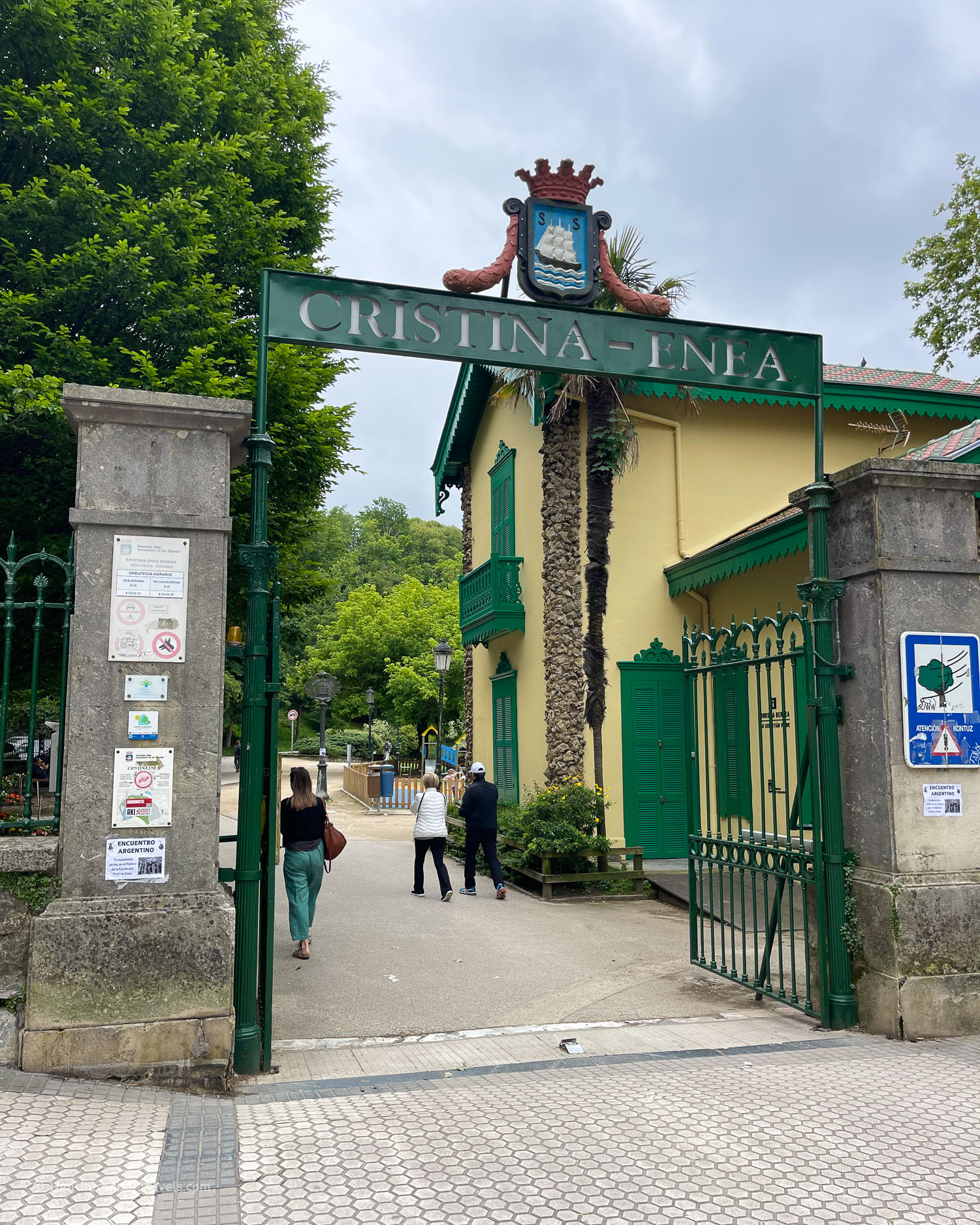
Around the former home of the Duchess of Mandas, after whom the park is named, the planting of gunera and tree ferns gives a lush and sub tropical atmosphere, where peacocks roam around. The house, which was the country residence of the Duke and Duchess, is now owned by the city council of San Sebastian and used as an environmental resources centre.
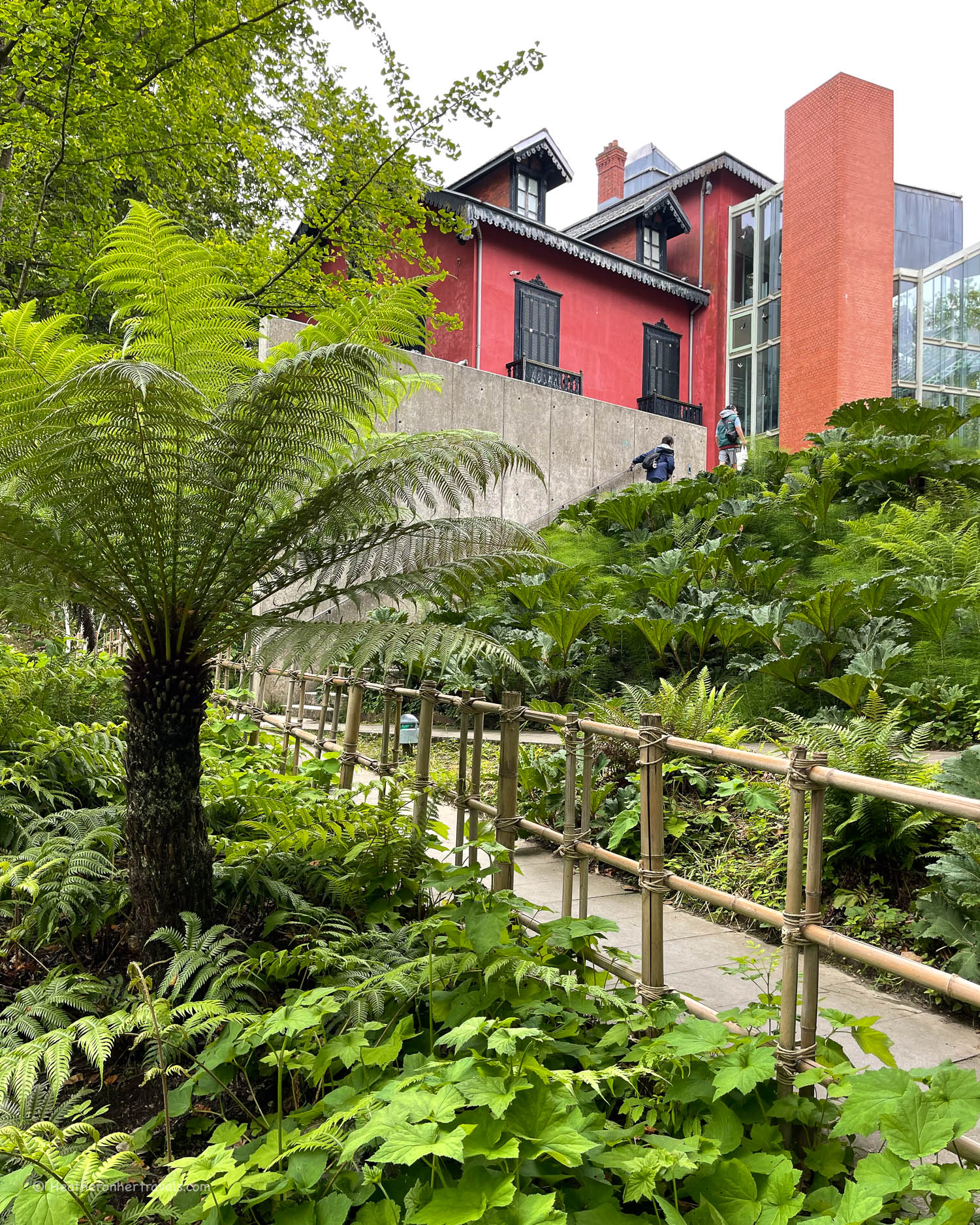
Outside the centre of San Sebastian
19. Chillida Leku
I’ve already mentioned the sculptures of San Sebastian’s leading artist, Eduardo Chillida at the Peine del Viento and on the seafront of La Concha. If you’d like to see more of his work, head to the northern edge of San Sebastian to visit Chillida Leku, (it means Chillida’s place). The farm was owned by the sculptor and conceived as a rural studio and setting for his artworks.
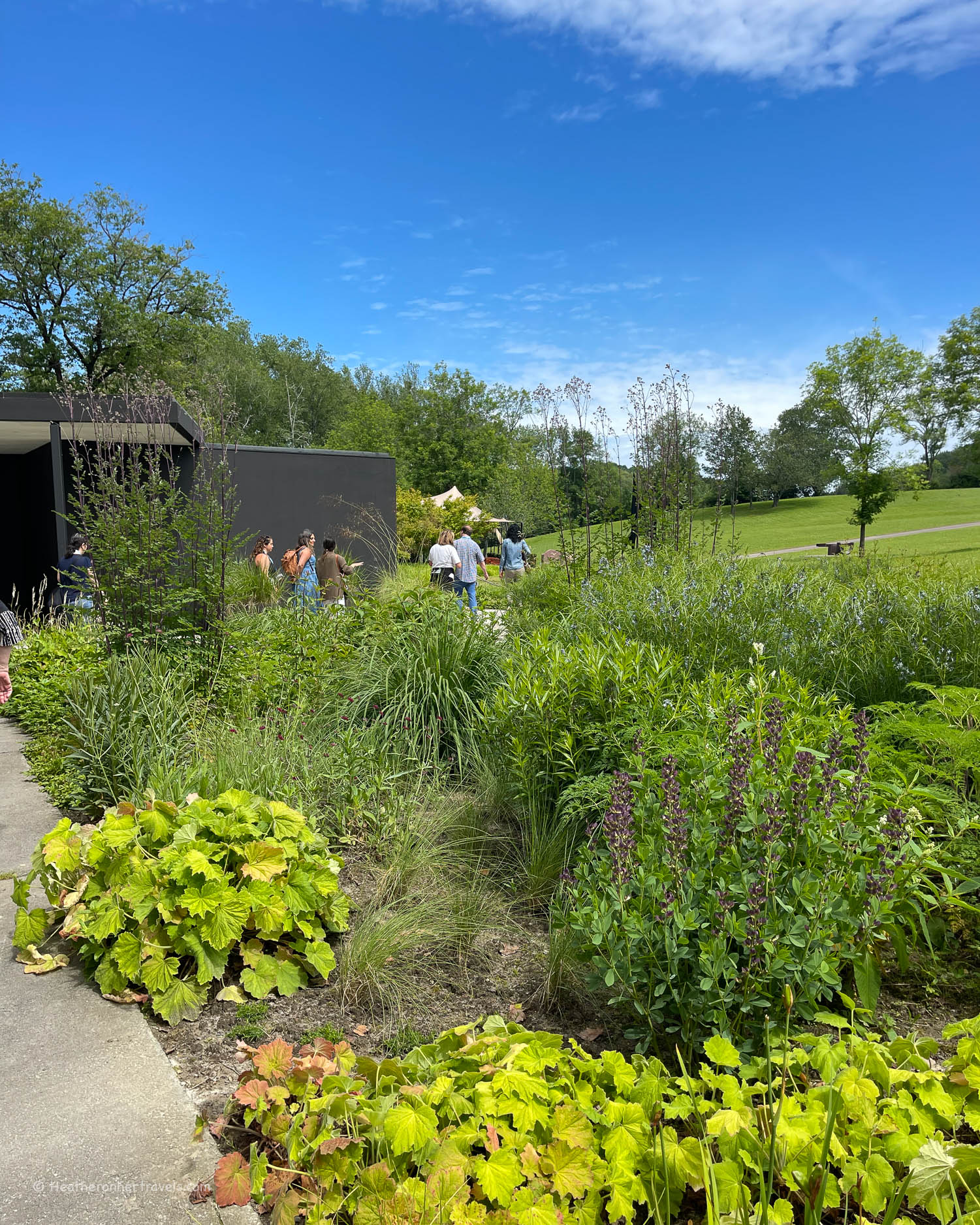
As an art lover, this was one of my favourite parts of this trip. It’s especially lovely if you get a sunny day to enjoy the gardens, cafe and rolling meadows with sculptures dotted around the landscape. A highlight is the gorgeous old stone farmhouse, that was converted to make a gallery for Chillida’s sculptures, drawings and paper artworks.
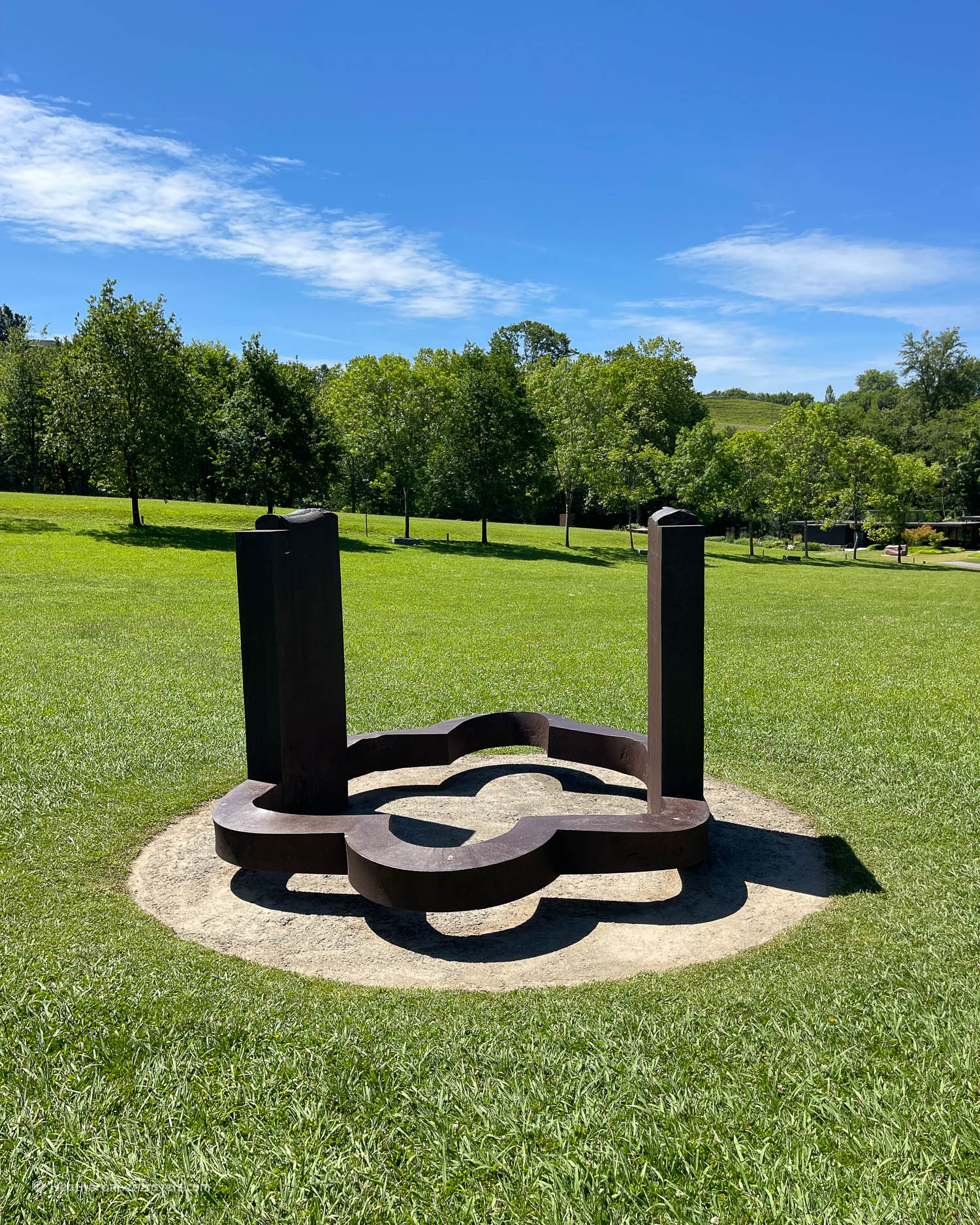
About Eduardo Chillida
Chillida was born in San Sebastian where he mainly lived until his death in 2002. His abstract works are exhibited in museums and galleries around the world, but he is not so widely known outside Spain. Now that Chillida Leku is run by the international art organisation Hauser and Wirth, the estate is a beautifully presented and restful spot to reflect on Chillida’s work.
Read more in my article about Eduardo Chillida and where to see his sculptures.
How to get there: If you are coming by bus, take the BU05 Lurralde Bus, running every 30 minutes, from Calle Okendo behind the Victoria Eugenia Theatre in San Sebastian, which stops right outside the museum.
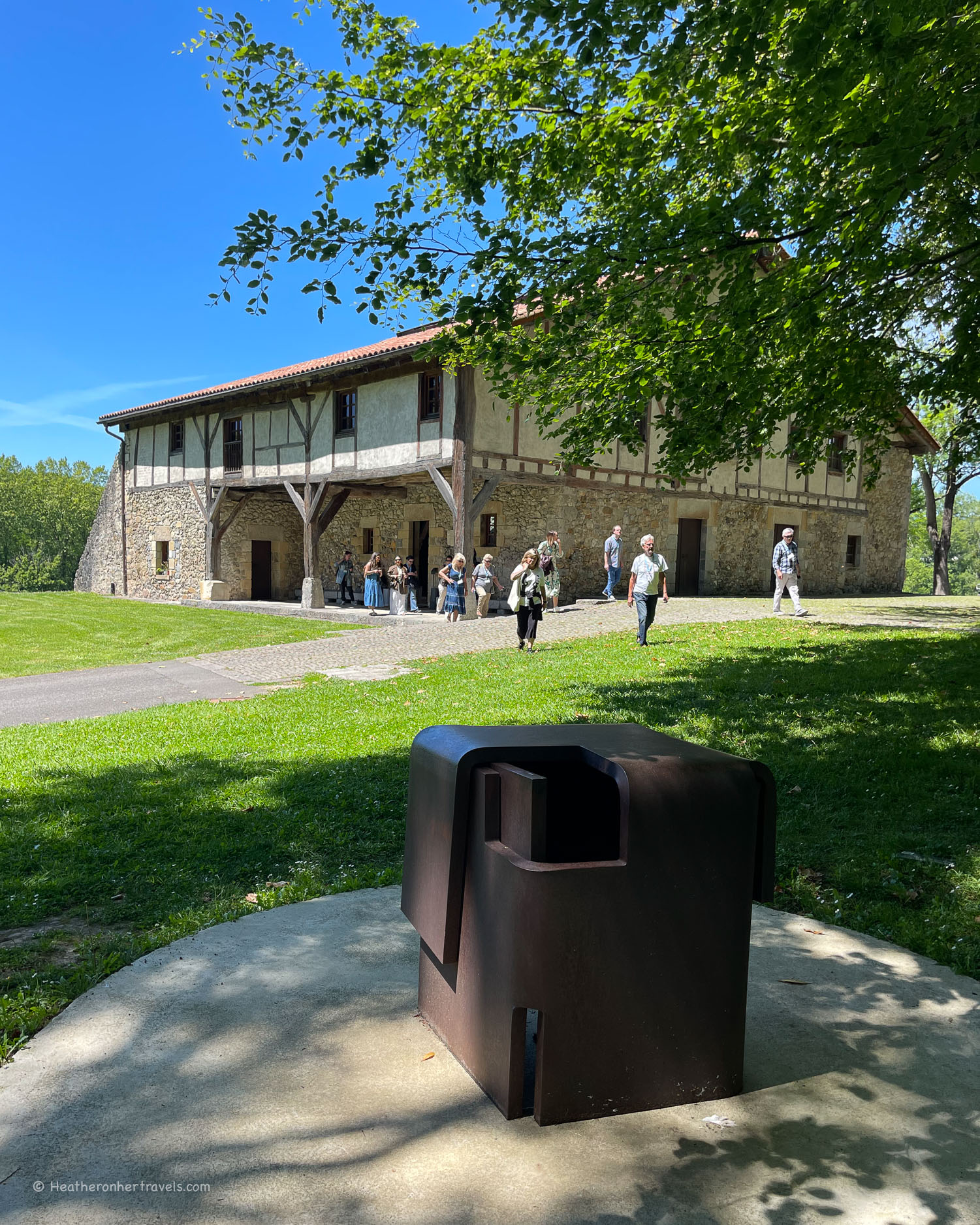
20. Visit a Traditional Sideria – to taste the local cider
The rolling green countryside around San Sebastian is ideal for growing apples and many of the farms of the Basque Country would traditionally make their own cider. What started as a glass of cider and some snacks served from the farm kitchen, has developed into the Sideria or Cider House that’s a fun part of Basque food culture.
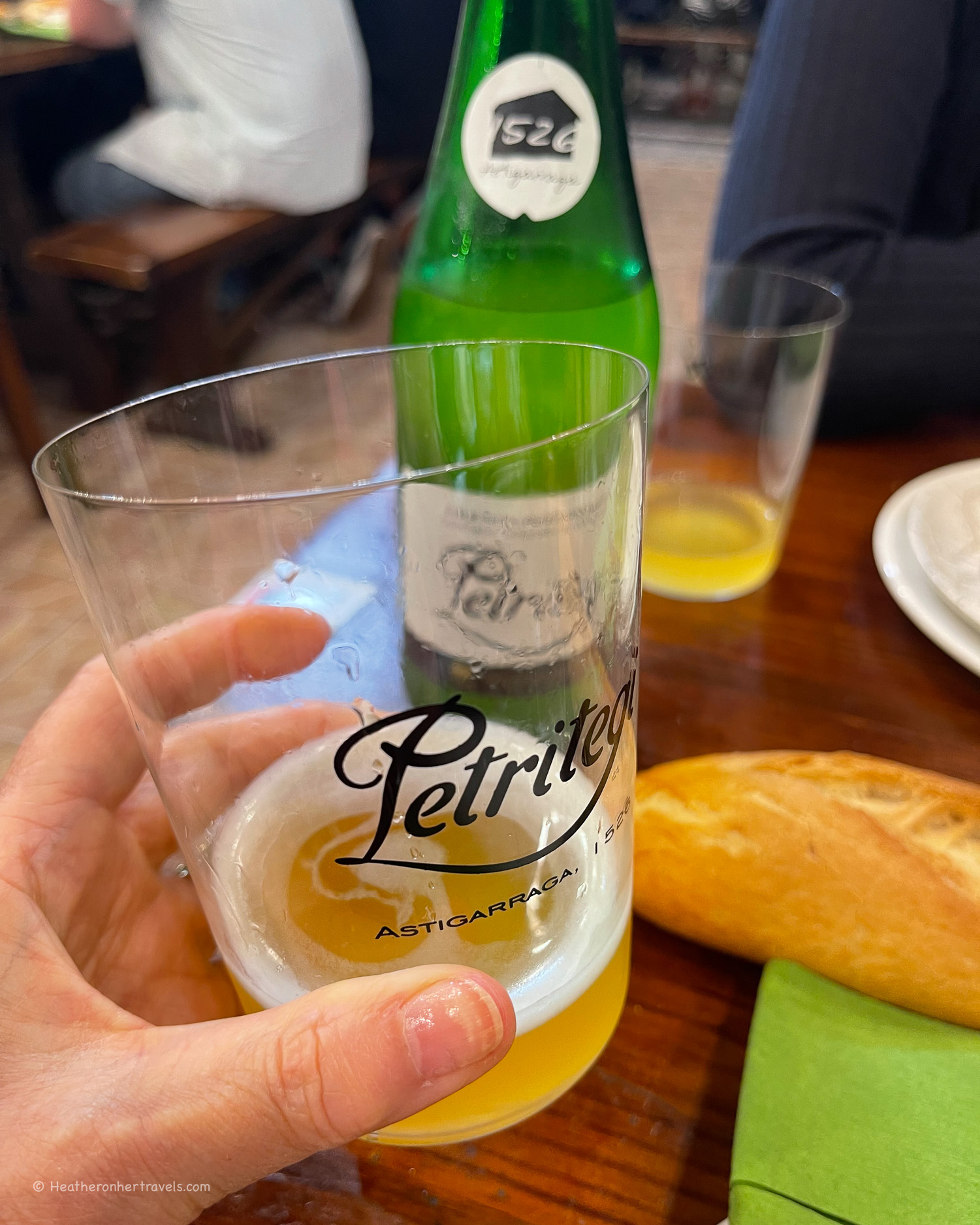
Since they developed around the orchards and farms, most of today’s Siderias are on the edge of San Sebastian. They are a fun way for friends to gather for a hearty meal and as much cider as you can drink. The convivial atmosphere is similar to a German beer hall, since you sit at long communal tables and are served simple fare such as omelette with cod, huge grilled steaks and local cheese with walnuts to finish.
The cider is naturally still, so to add some bubble it’s poured from a great height directly from the barrel. The barman will cry Txotx! (pronounced Chock!) as he opens the tap and everyone can then put their glass under the flow in turn, drawing it upwards to get the maximum fizz.
I was invited to a cider house evening at Petritegi Sideria just outside San Sebastian, which offers cider tastings in their shop and orchard, as well as the full on Cider House experience with set menu from around €40 per head.
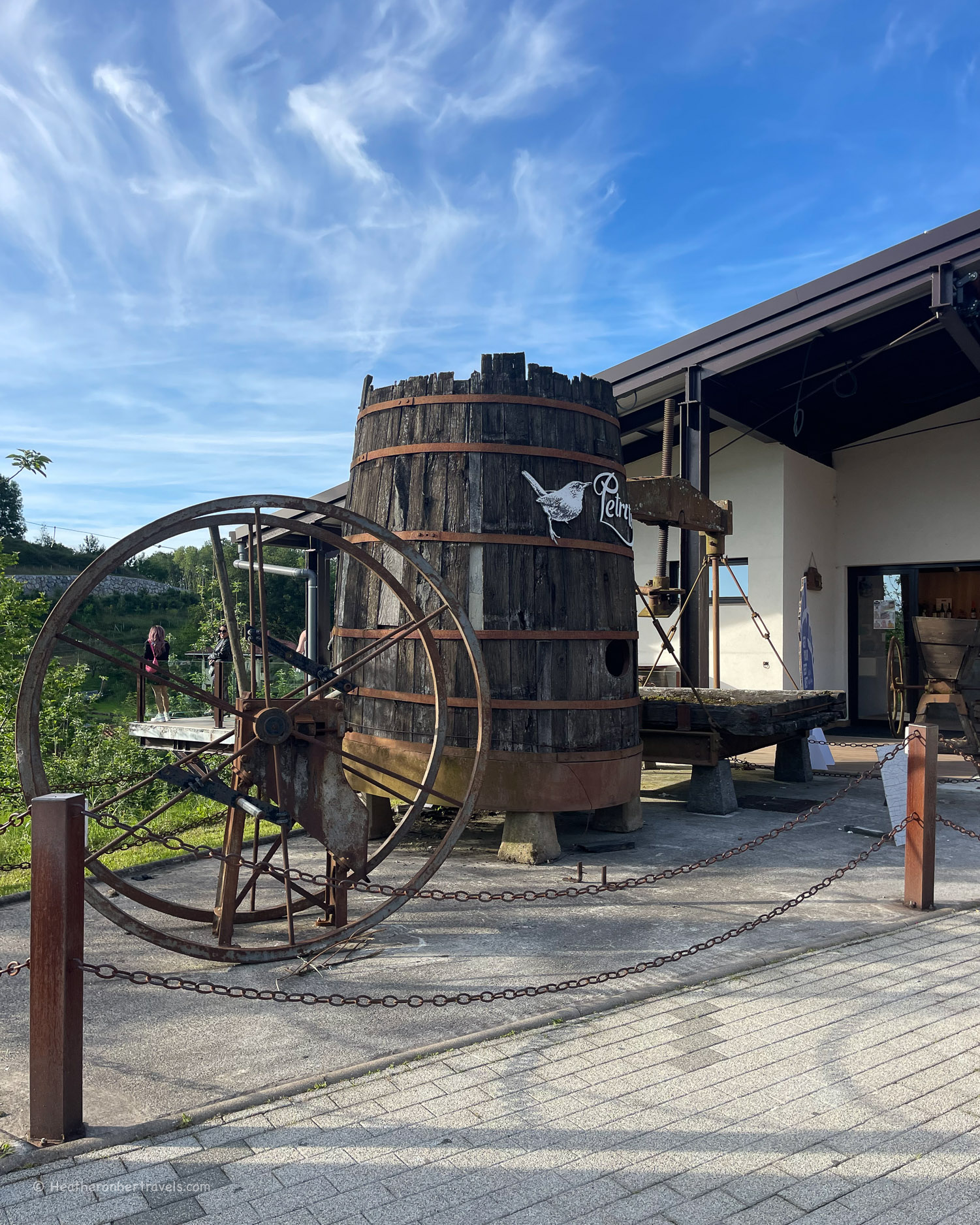
Easy Day Trips by bus from San Sebastian
While using San Sebastian as a base, it’s possible to make several interesting day trips to visit nearby coastal towns. You can drive to these locations if you have a hire car, but we can recommend taking the efficient bus service. It’s far more relaxing, sustainable and cheap!
Getaria
Getaria was my favourite day trip from San Sebastian, mainly because I used to work in fashion and loved visiting the stunning Cristobal Balenciaga Museum. We wandered down the main street of Nagusia Kalea to the 14th century Iglesia de San Salvador, which has an unusual sloping floor and is reminiscent of a ship.
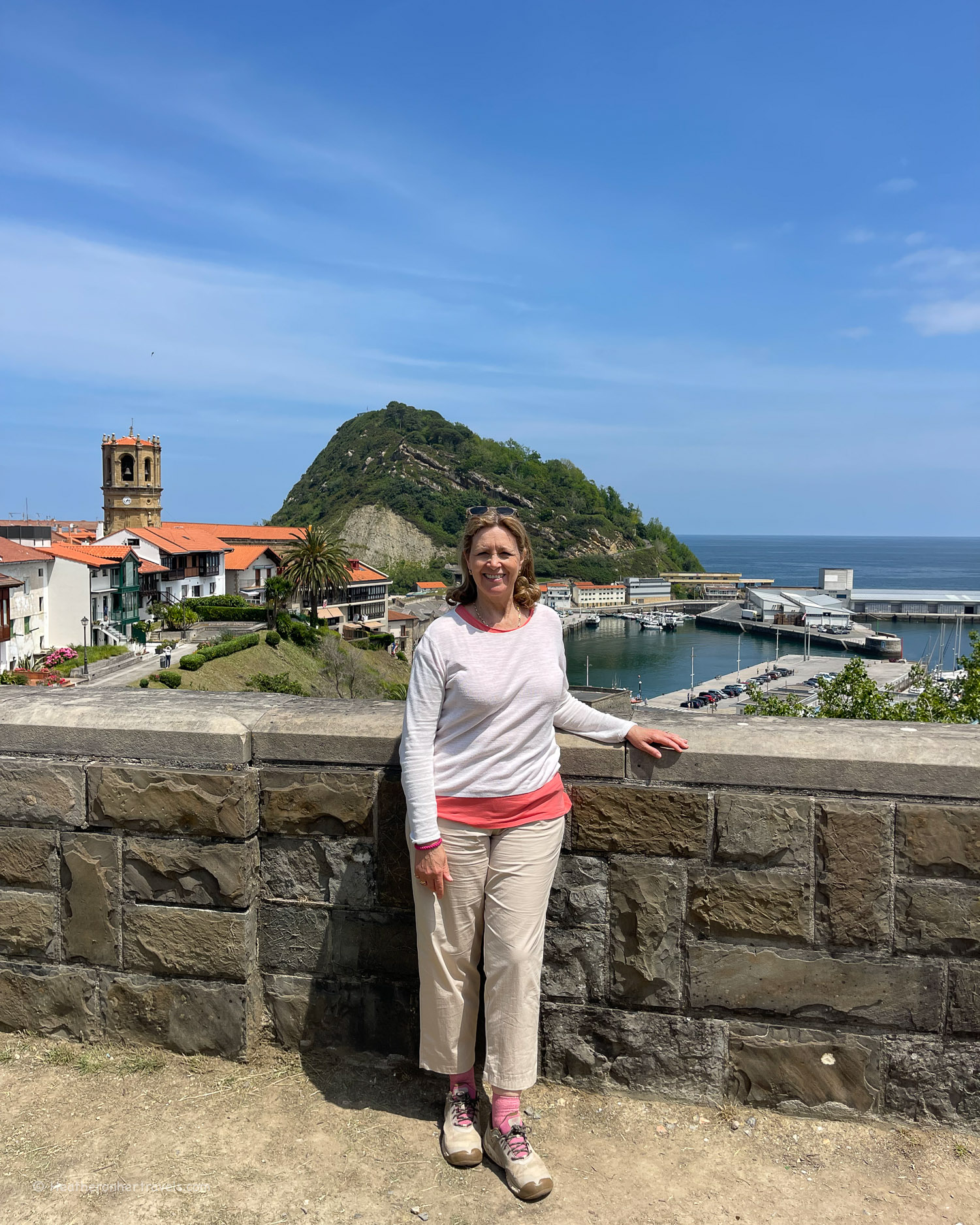
It was from here that the navigator Juan Sebastian Elcano left in 1519 to circumnavigate the globe on Magellan’s ship, one of the few sailors to return from the voyage. Beyond the church is the port area, with a number of restaurants that specialise in fresh fish grilled over charcoal, which will tempt you in with their appetising smell!
Retracing our steps we climbed back up the hill (there is an escalator to take you part of the way) to the museum dedicated to fashion designer Cristobal Balenciaga. He was born in Getaria and was at the peak of his influence as a master of couture in the 1950s and 1960s. The museum is full of gorgeous gowns, that trace the development of the Balenciaga style, with innovative silhouettes worn by the rich and famous.
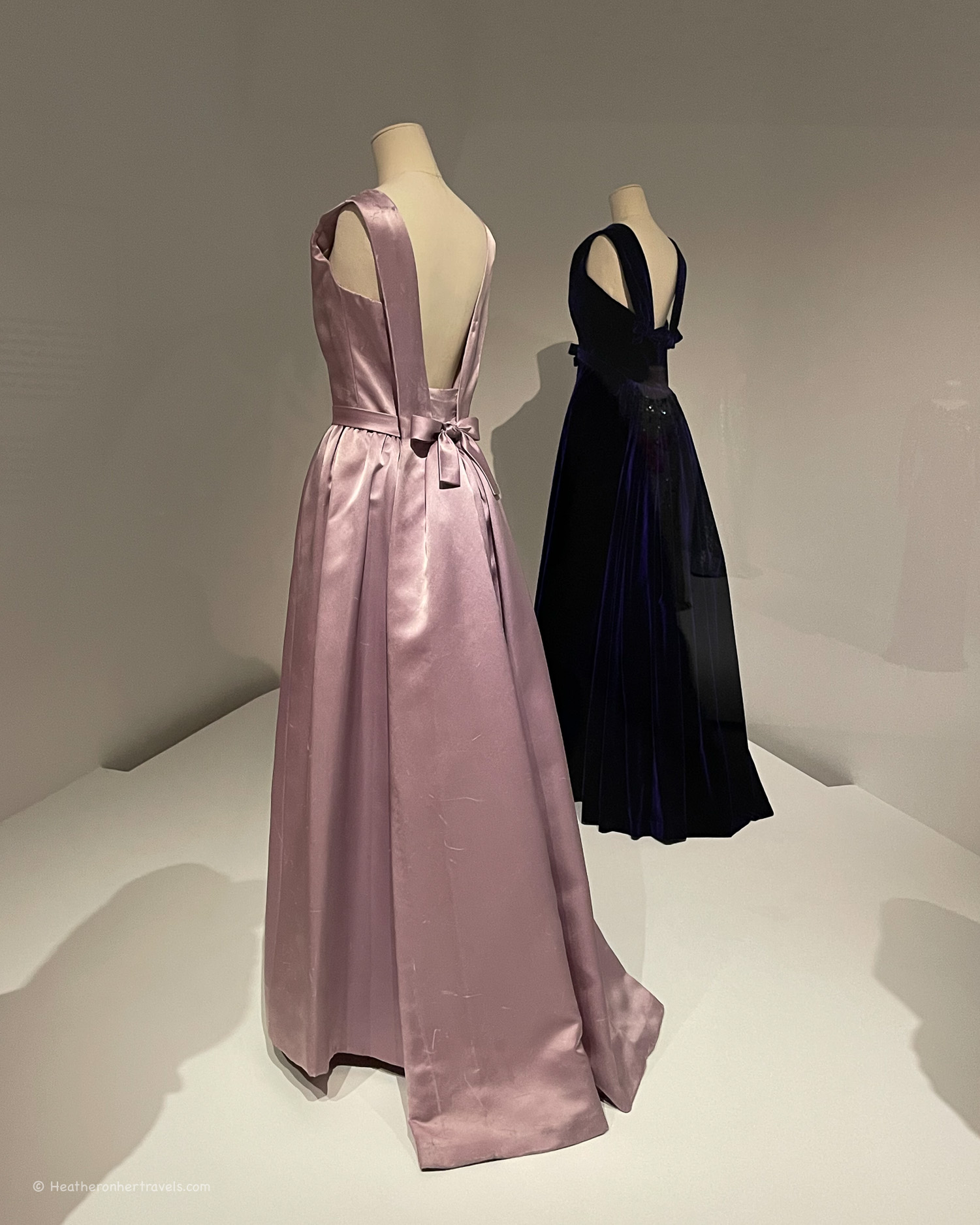
The area around Getaria is a major producer of the regional Txakoli white wine, but unless you visit by car or as part of a tour, it seemed difficult to visit any of the wineries.
Getting there: Take the UK11 bus, which is the quicker route as it goes via the motorway or the UK9 bus which takes a slightly longer and more scenic route via the villages. The bus starts in San Sebastian at Libertad 34 in the Centro district and takes 35-45 minutes. More information on the Lurralde Bus website.
Hondarribia
The walled old town of Hondarribia dates back to the 15th century, and reminded me a little of Alsace, with its half timbered houses and pretty flower filled balconies. There are a couple of attractive squares, including Plaza de Armas in front of the church, with medieval Parador hotel and tourist information centre, where we stopped for a coffee.
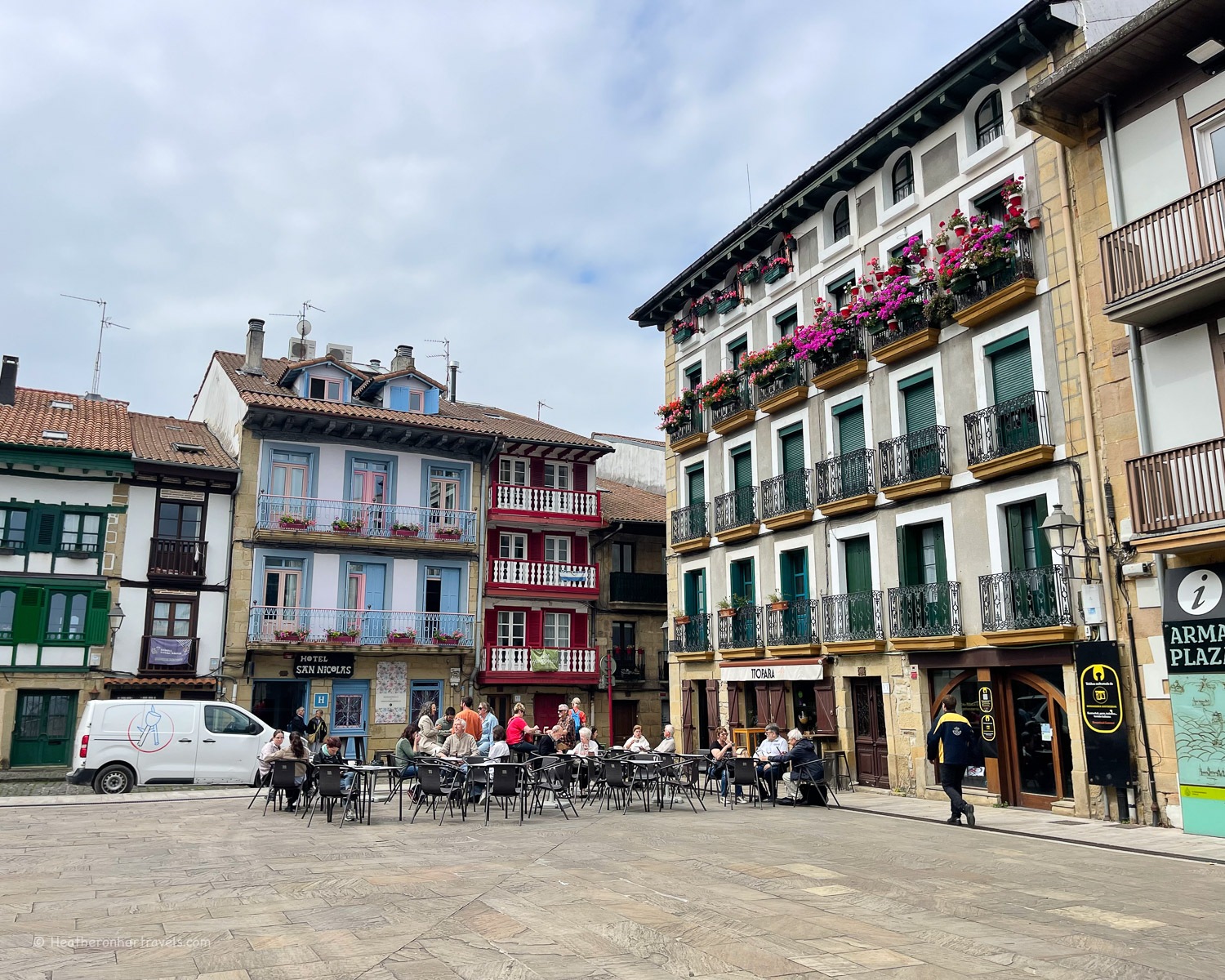
Continue down the hill to the La Marina district, a pedestrianised street with colourful fishermen’s houses that are now mostly bars, restaurants and souvenir shops. This is an excellent place for lunch, especially if you want to try the local seafood or Sopa de Pescado (fish soup). Hondarrabia is right on the border with France, and you can take a ferry across the river from here, if you want to explore the French town of Hendaye.
A 20 minute stroll along the river front will bring you past the marina where there’s a whole row of bars and restaurants. Just beyond is the Playa de Hondarribia, with a flat stretch of sand, partly backed by a nature reserve. Returning to the La Marina district, you can catch the bus from here back to San Sebastian.
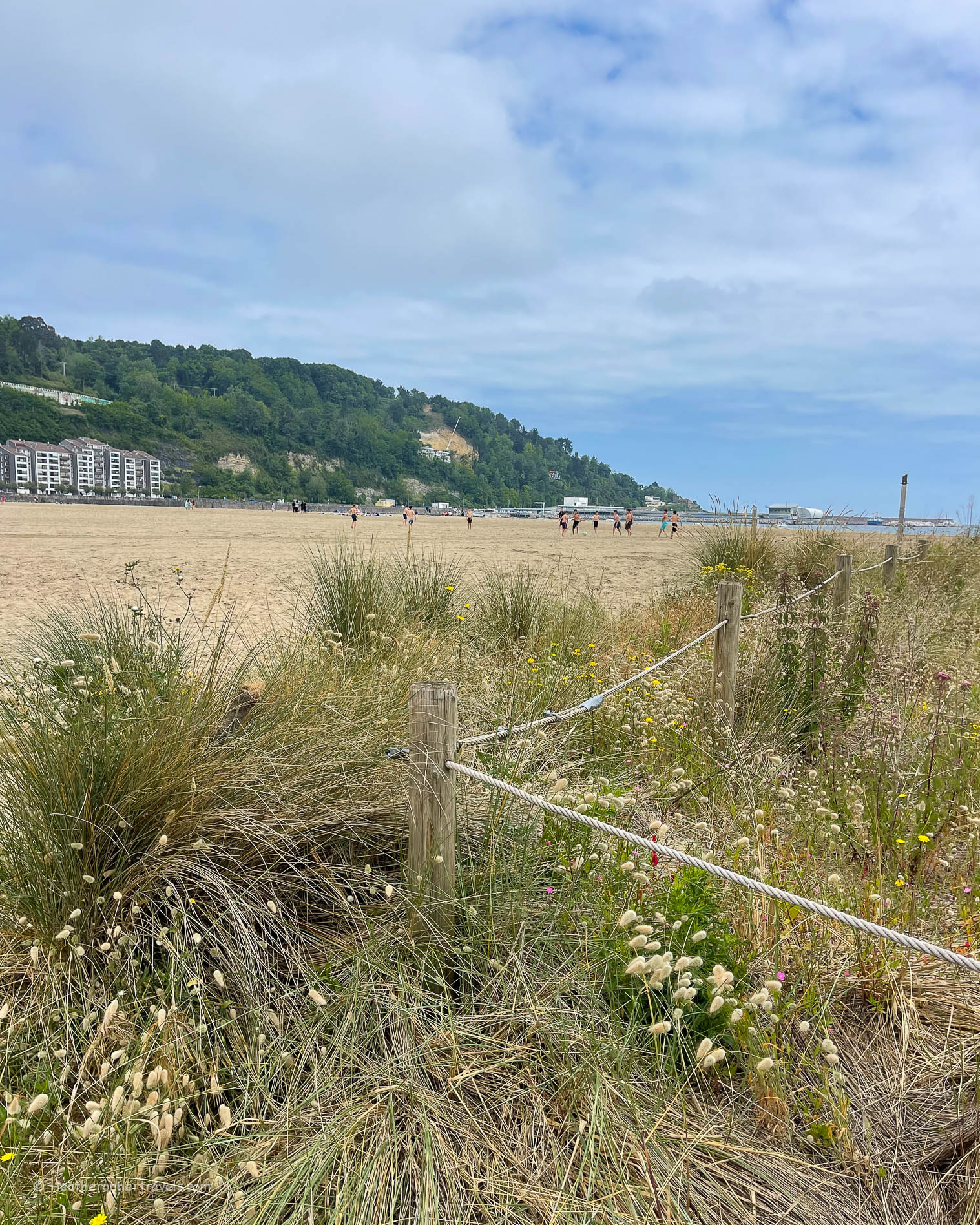
Getting there: Take the E21 bus from Gipuzkoa Plaza via the San Sebastian airport, and get off near the Casco Historico of Hondarribia. There are other E buses that will also take you there on slightly different routes – check on the Ekialdebus website for more information.
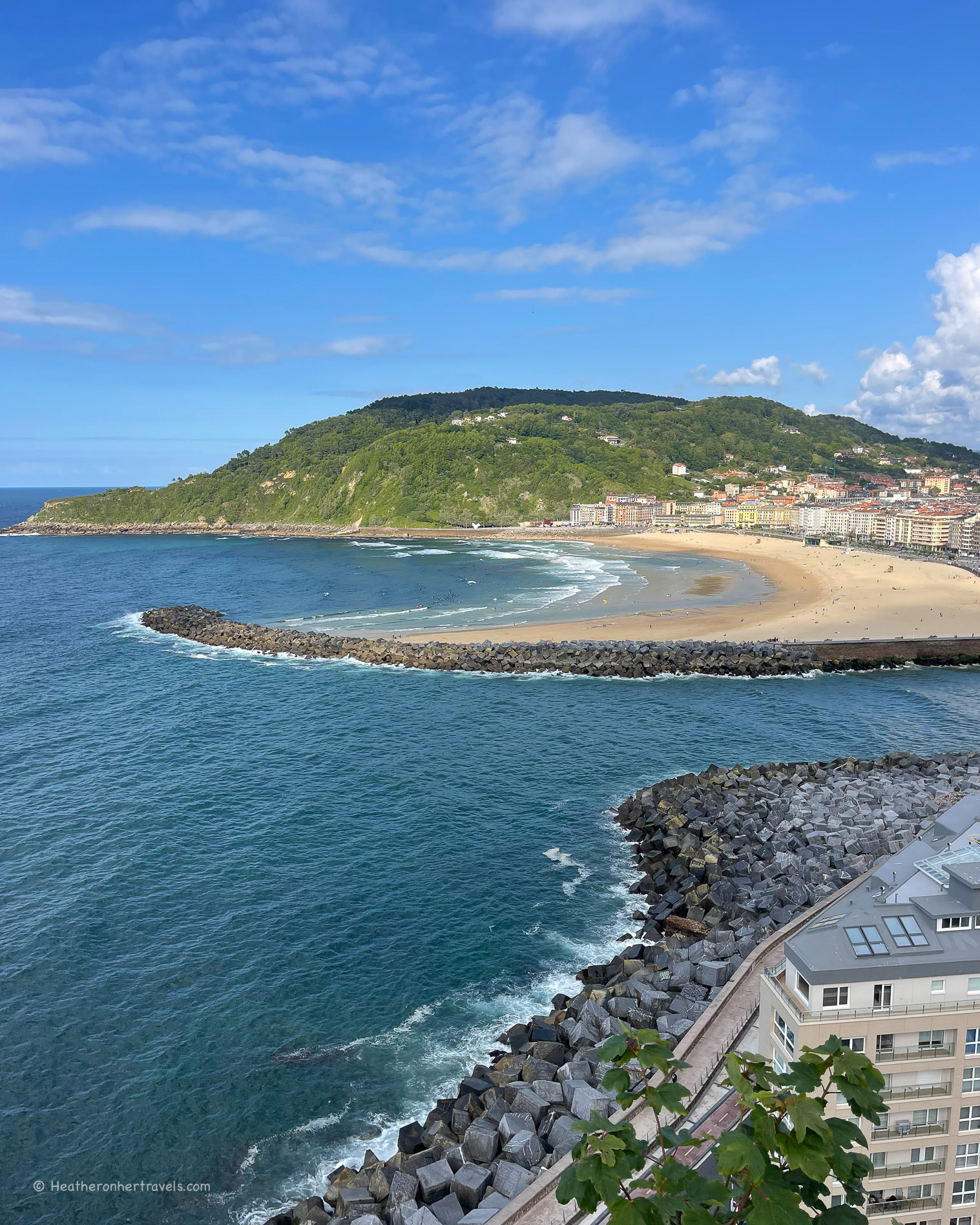
Pasaia
One walk would have loved to make if I’d had time, is the part of the Camino de Norte that leads from the end of Zurriola beach in San Sebastian, over Mount Ulia to Pasaia. The walk should take around 3 hours and you can return by bus – check the Lurralde Bus website.
While this is the location of San Sebastian’s busy commercial port, the medieval town closest to the sea has some charming older houses. The Albaola Museum can be visited for information about the town’s past role in the whaling industry and a replica of the San Juan galleon, which sank off the coast of Newfoundland.
A small ferry runs every 10 minutes across the river, which divides Pasaia on one side from Pasai Donibane on the other.
How to get to San Sebastian
Flights to San Sebastian
Bilbao Airport (BIO) is the closest Spanish airport to San Sebastian. There’s a wide choice of flights from other European destinations, although visitors from outside Europe may need to connect via Madrid. By road the journey time from Bilbao Airport to San Sebastian is around 1 hour 15 mins.
Biarritz Airport (BIQ) is an international airport that’s also close to San Sebastian, although it’s located over the border in France. By road the journey time from Biarritz airport to San Sebastian is around 50 minutes.
San Sebastian does have its own airport (EAS), but most of the flights are internal or from other Spanish islands. British Airways does fly direct to San Sebastian airport from London Heathrow, Gatwick and City airports.
By Ferry to San Sebastian
Portsmouth UK to Bilbao – This crossing is with Brittany Ferries and takes around 32 hours, with 2 sailings per week. From Bilbao port you will need to take the C1 Renfe line from Santurtzi to San Mames in Bilbao city centre, then take either the train or the bus to San Sebastian.
Portsmouth UK to Santander – This crossing is with Brittany Ferries and takes 33 hours, with 2 sailings a week. From Santander port (Barrio Pesquero) take the local bus to Santander bus station, then take the ALSA bus from Santander to San Sebastian (2 hrs 50 mins).
Trains to San Sebastian
There is a direct local train (Euskotren) from Bilbao Matiko station to San Sebastian Amara station. However, it stops at all the local stations and takes 2 hrs 35 mins, so is much longer than the direct bus.
Direct trains also run from Madrid and Barcelona to San Sebastian, with connections to and from many other Spanish towns and cities.
If coming from Biarritz, you’ll need to get to Biarritz city station and take the train to Hendaye, on the French side of the border. On exiting the Hendaye station, you can walk 50m to the nearby Euskotren (Basque local train) stop and change to another train to San Sebastian.
If coming by train from other destinations in France, you’ll need to take a train to Hendaye (there are trains from Paris and Bordeaux) and then change at Hendaye to the Euskotren service to San Sebastian.
Tip: The Basque name for San Sebastian is Donostia, so you may see this name given as the destination on train timetables.
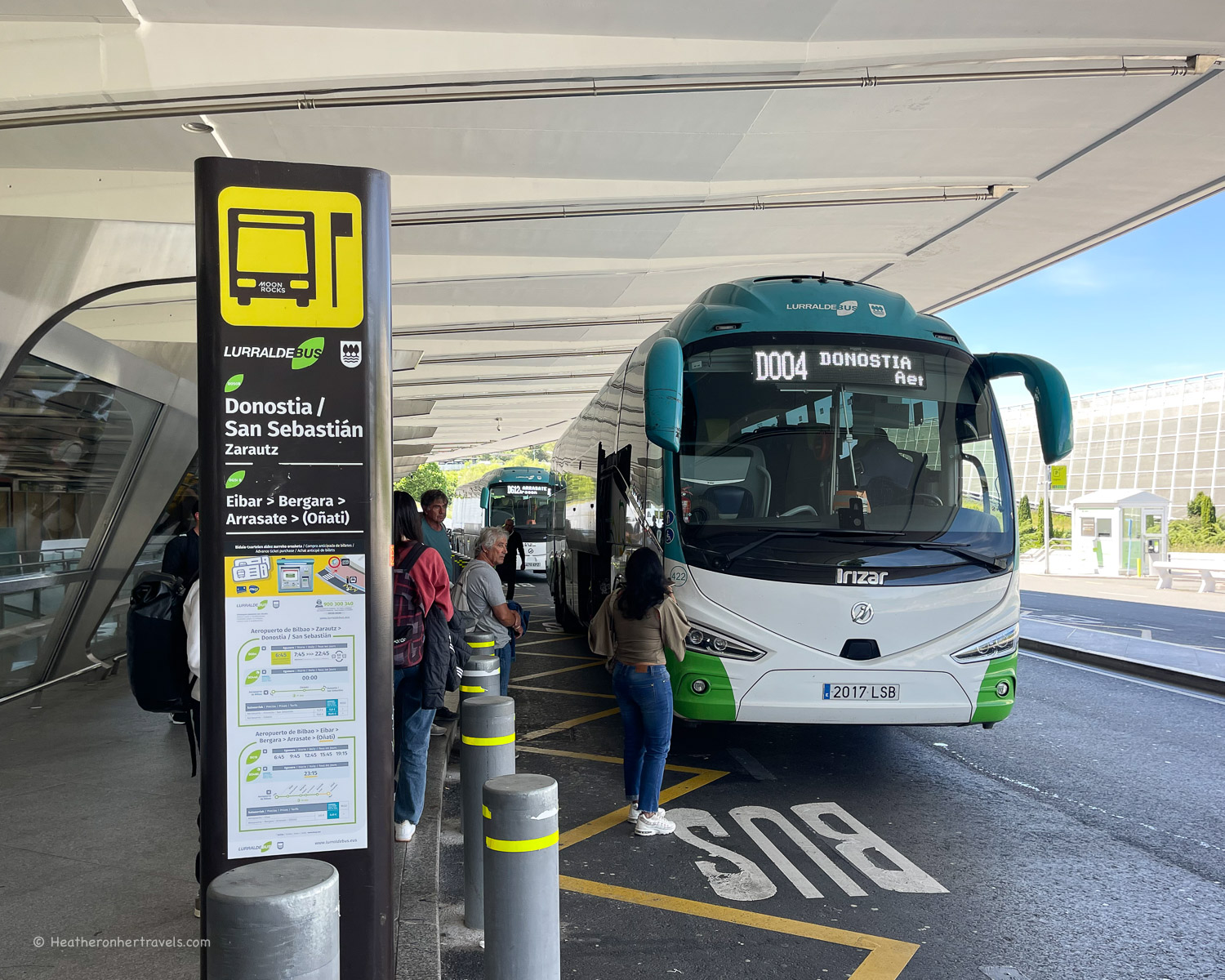
By Bus to San Sebastian
Bilbao Airport – From outside the airport arrivals terminal there is a direct bus service (D004) to the bus station at San Sebastian. Journey time is around 1 hour 15 mins. This is the method we used and found it quite easy. There was a ticket machine inside the airport, with people to assist with buying the tickets. The bus driver did not seem to sell tickets (unlike some reports we’ve read), so you do need to get them first from the machine. The bus runs about every hour.
Bilbao city centre – Buses run regularly with ALSA from the Bilbao Bus station (Intermodal) to San Sebastian Bus station. Journey Time is around 1 hour 30 mins.
Biarritz Airport – From the airport there’s a direct bus service to the bus station at San Sebastian. By road the journey time from Biarritz airport is around 50 minutes.
Buses run with ALSA or Flixbus to San Sebastian from Madrid, Barcelona and a number of other Spanish cities.
Car to San Sebastian
You can easily hire a car at Bilbao airport, San Sebastian airport or San Sebastian Downtown. If you hire a car, we recommend searching for the best deals on Rentalcars – but as always, check the ratings and reviews before you book.
You don’t really need a car while in San Sebastian, but could be useful if you’re making a tour of several places in the Basque Country.
Read Next
Discover where to see his Eduardo Chillida sculptures in San Sebastian
Read more about my travels in Spain
A Costa Brava Road Trip in Spain – Girona, Cadaques and Dali
20 best things to do in Seville Spain
15 Cool things to do in Madrid Spain
Pin it!
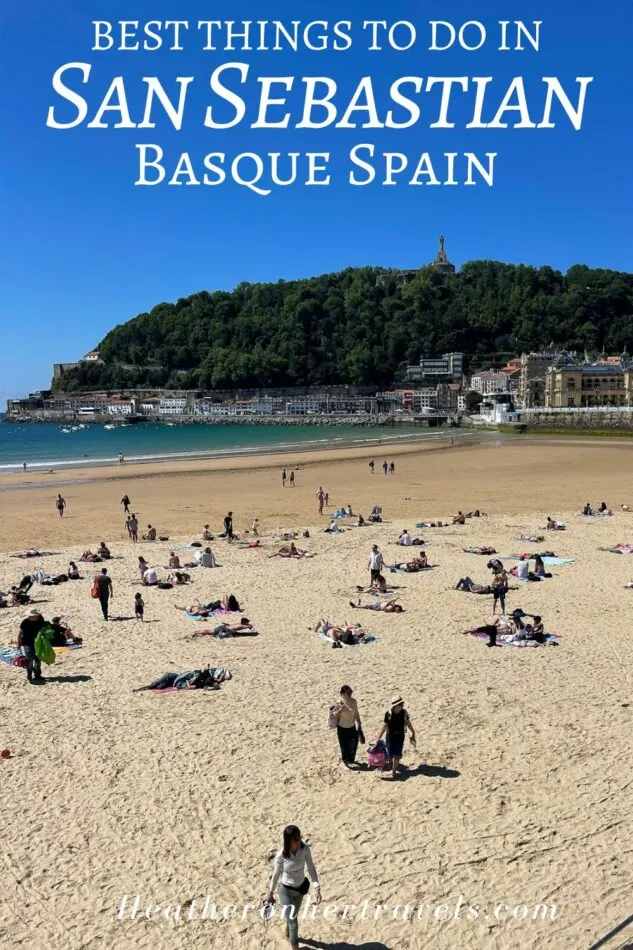
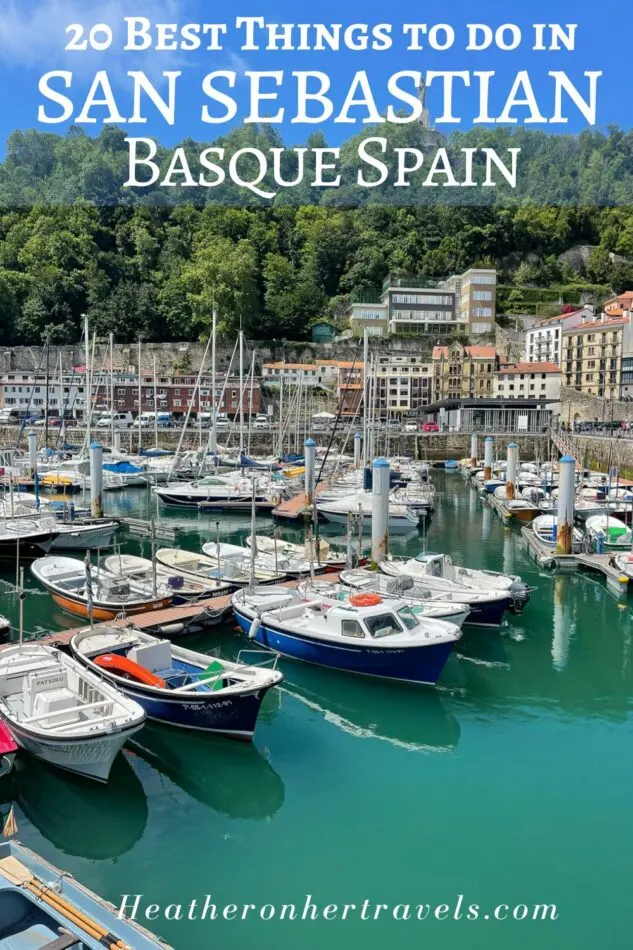
This article is originally published at Heatheronhertravels.com

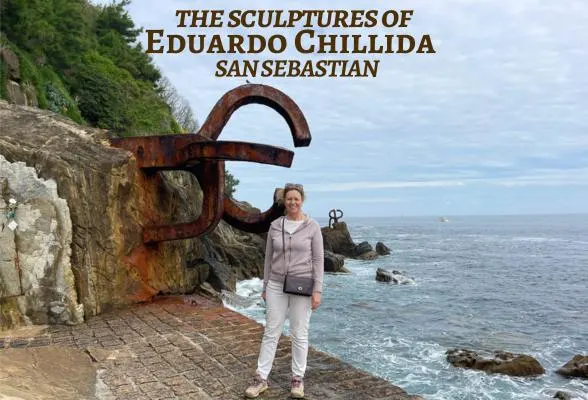

Hels
Friday 2nd of August 2024
The beaches, ports and boat trips are peaceful, clean and maximise the city's special location. But are there any moderately priced hotels with great water views?
Heather Cowper
Friday 2nd of August 2024
@Hels In general the hotel rates in San Sebastian are known to be higher than other parts of Spain, so it's difficult to find any real accommodation bargains overlooking the sea, unless you are there in low season. The hotels along La Concha beach tend to have the highest rates, so I'd look for places in the more affordable Gros neighbourhood, where there are a few apartments and pensions that overlook the beach.